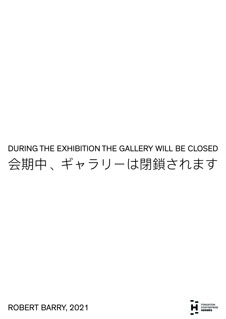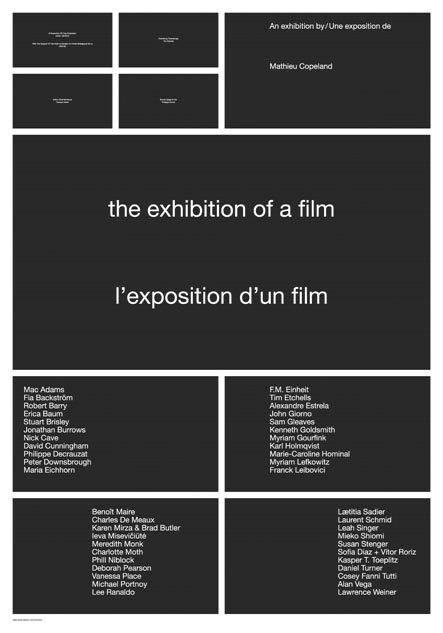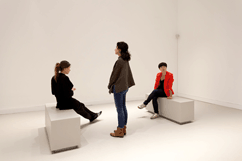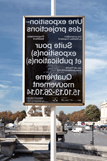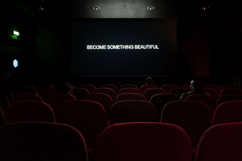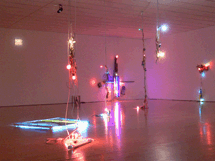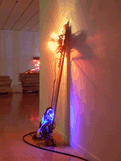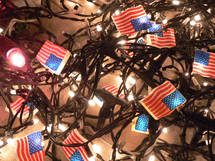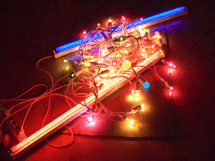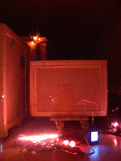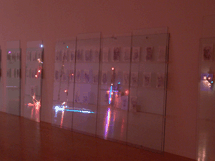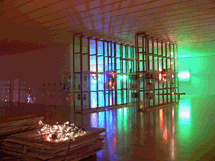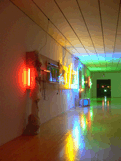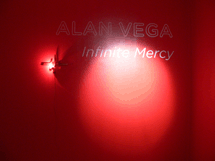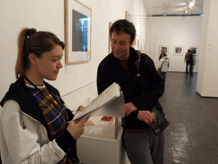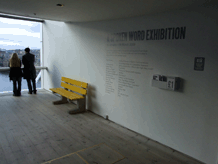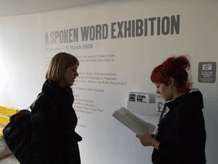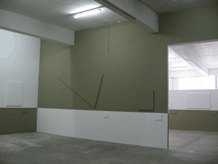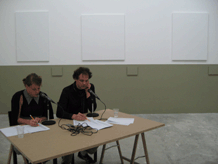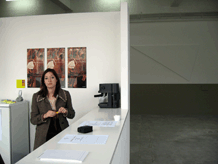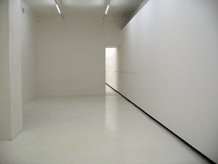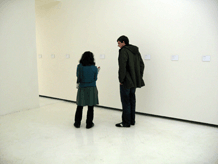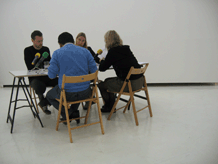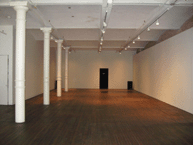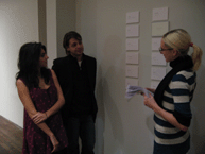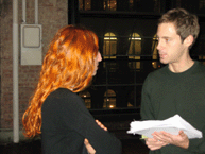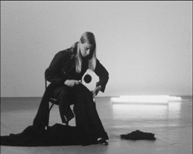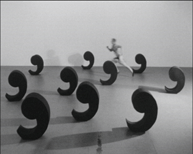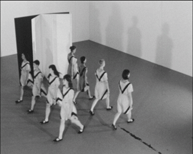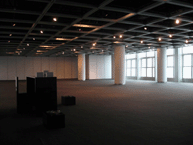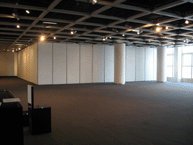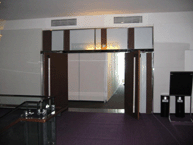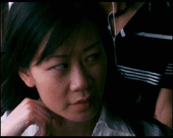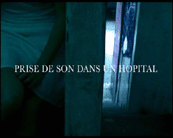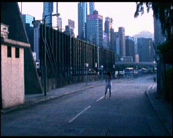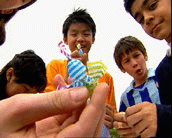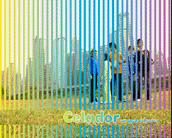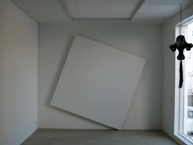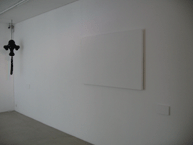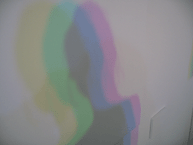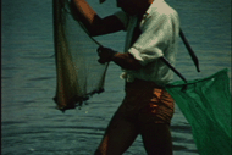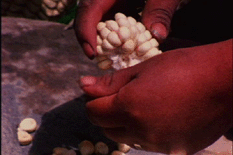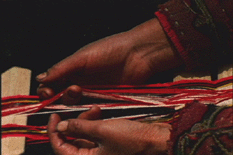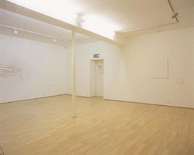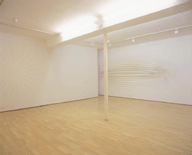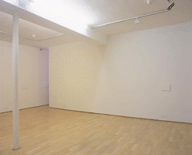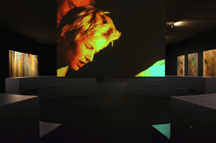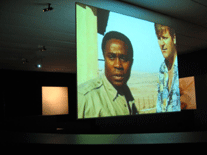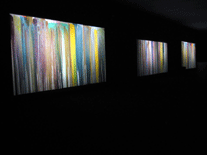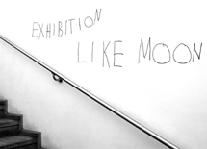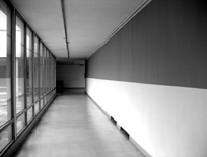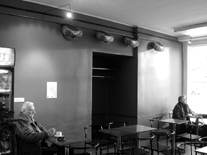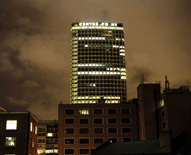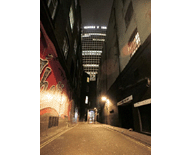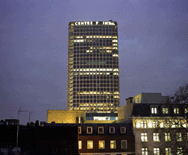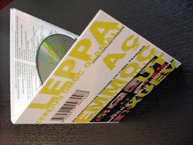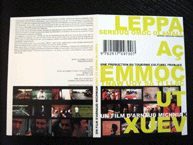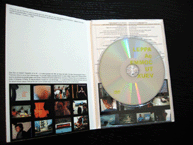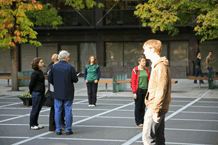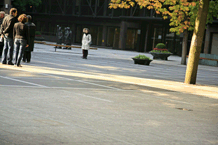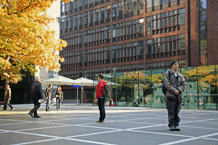EXPOSITIONS / EXHIBITIONS
FORTHCOMING: A SITUATION - ROBERT BARRY, VENET FOUNDATION, MAY 2023 - MAY 2024
PUBLICATIONS
OUT NOW : ‘Phill Niblock – Nothing but workin’ (Verlag der Buchhandlung Walther und Franz Konig), ‘Philippe Decrauzat – DELAY’ (Verlag der Buchhandlung Walther und Franz Konig), ‘Gustav Metzger – Writings 1953–2016’ (JRP Editions), 'A Personal Sonic Geology' (le Plateau & Mousse Publishing),‘The Anti-Museum’ (Konig Books), available now
l’anti-musée : un anti-documentaire
Avec Stefan Brüggemann, Graciela Carnevale, Philippe Decrauzat, FM Einheit, Henry Flynt, Kenneth Goldsmith, Swetlana Heger, Liliane Lijn, Ben Morea, Ben Vautier
Une exposition de Mathieu Copeland
18 octobre 2023 – 11 novembre 2023
Vernissage : mercredi 18 octobre à partir de 17 h
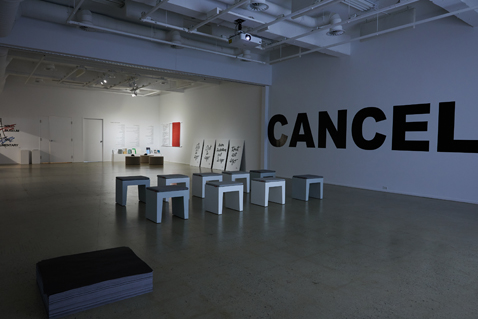
l’anti-musée : un anti-documentaire
Encore marquée par les réflexions ayant émergé au sein du laboratoire de recherche collaborative et transdisciplinaire Chercher l’ouverture (2020-2021), la Galerie UQO poursuit ses échanges avec le commissaire Mathieu Copeland au sujet des expositions fermées. Les fermetures, comme celle annoncée et revendiquée par la Galerie UQO en 2020, sont des gestes politiques forts qui mènent à s’interroger sur la définition du travail dans le milieu de la culture et de la vocation des espaces dans lesquels les œuvres d’art sont habituellement présentées. La pandémie a conduit à la fermeture d’entreprises, de magasins, de lieux culturels, mettant des millions de personnes au chômage; en cela, elle a produit une nouvelle normalisation de la distance sociale et des espaces virtuels. Raconté par le musicien Henry Rollins, le film The Anti-Museum: an Anti-Documentary (L’anti-musée : un anti-documentaire) est une réflexion sur la fermeture forcée des musées et des expositions. Il envisage des manières alternatives de produire et de diffuser l’art contemporain.
En écho à la projection du film en continu sur un tableau-écran de l’artiste Philippe Decrauzat, Copeland propose une (anti-)exposition qui, par le biais d’interventions inédites des artistes internationaux Stefan Brüggemann, Graciela Carnevale, FM Einheit, Henry Flynt, Kenneth Goldsmith, Swetlana Heger, Liliane Lijn, Ben Morea et Ben Vautier, envisage une approche sensible de la proposition de l’anti-musée. Cette exposition est conçue comme un anti-documentaire, évoquant, par la radicalité des œuvres, le sentiment de ce que peut être un anti-musée. Une journée de conversations et de discussions ouvrira l’exposition, convoquant autant des artistes de l’exposition, que des chercheur·euses et commissaires d’expositions, autour des questions fondamentales que sont les concepts d’anti-art, anti-philosophie ou anti-musique pour mieux mettre en avant le concept fondateur de l’artiste et activiste Gustav Metzger : la nécessité pour l’art de changer le monde.
En marge de l’exposition, les conférences FERMETURE et RADICALITÉ se tiendront à l’auditorium du Pavillon Lucien-Brault et en ligne le 18 octobre à 11 h 30 et à 15 h 30.
En partenariat avec la Bibliothèque de l’Université du Québec en Outaouais.
Réalisée avec le soutien de la Leeds School of Art – Leeds Beckett University.
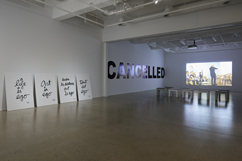
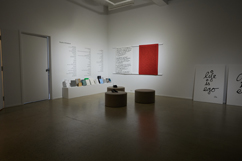
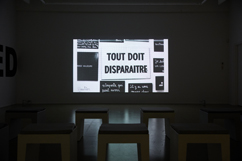
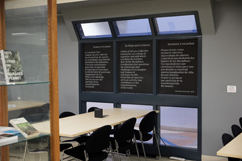
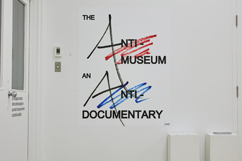
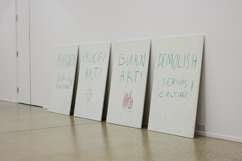
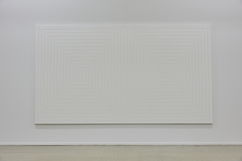
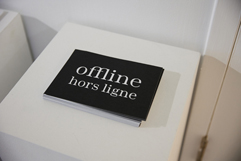
--
conférence #1 – fermeture
Mathieu Copeland, Jim Drobnick et Graciela Carnevale
11 h 30 à 13 h
À l’auditorium du Pavillon Lucien-Brault et en ligne
Considérant l’héritage de gestes radicaux comme formes artistiques, cette discussion portera sur les actes de fermeture de musée et de galeries dans l’histoire de l’art, prenant sa source dans Une rétrospective d’expositions fermées (Kunsthalle Fribourg, 2016) et l’ouvrage The Anti-Museum (Koenig Books, 2017). Plus précisément, il sera question de l’œuvre Nomadic Residents de Rirkrit Tiravanija présentée lors de l’ouverture de l’OCAD Professional Gallery en 2001 et de l’action historique de l’artiste Graciela Carnevale, où elle enferma le public à son insu dans la galerie du Ciclo de Arte Experimental à Rosario en Argentine, en 1968.
conférence #2 – radicalité
Mathieu Copeland, Vivek Venkatesh, FM Einheit et Marie-Hélène Leblanc
15 h 30 à 17 h
À l’auditorium du Pavillon Lucien-Brault et en ligne
La notion de radicalité est essentielle pour envisager les arts contemporains. Il semble pourtant quasi impossible d’en donner une définition ontologique. Au travers des recherches parallèles de Copeland, Venkatesh, FM Einheit et Leblanc qui couvrent autant la possibilité d’existence de l’institution, les pratiques artistiques et musicales destructives, que le rapport des communautés face à la haine et l’extrémisme violent, cette conversation permettra d’articuler les enjeux multiples de ces notions en prenant pour point d’appui le concept d’ANTI.
La discussion sera précédée par l’écoute de la pièce sonore Whatever it is, I’m against it !, une adaptation magistrale de la chanson originale des Marx Brothers, issue de leur comédie musical Horse Feathers de 1932, réalisée par FM Einheit spécialement pour l’exposition L’anti-musée : un anti-documentaire.
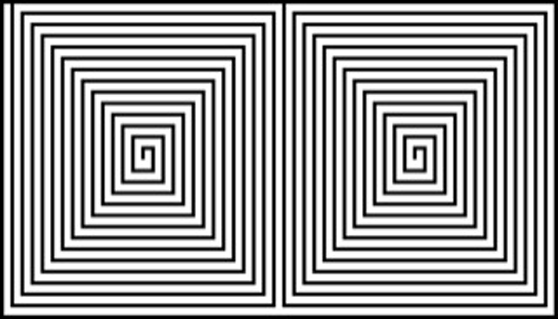
Galerie UQO
Université du Québec en Outaouais
101 Rue Saint-Jean-Bosco, Gatineau (Québec), QC J8Y 3G5, Canada
A Situation
Robert barry
An exhibition by Mathieu Copeland
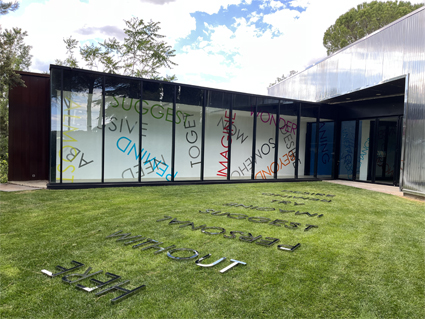
Visitors to the Venet Foundation are invited to experience two large ensembles from the immense body of work produced by Robert Barry, one of the figurehead of minimal art and pioneer of Conceptual Art. One is a retrospective of Barry’s wall pieces, with seven murals from 1978 to 2023, the second is a retrospective of the sound pieces the artist produced between 1976 and 2023.
Following a process of “rematerialization” the artist initiated in the mid 1960s, Barry pursued his study of the word and freed it from classical supports such as paper and canvas to consider it on the scale of the wall. The foundation’s exhibition begins with the UNTITLED wall drawing the artist originally produced for his 1978 one man exhibition at the Leo Castelli Gallery in New York where within the wall a space is defined through a square made of words. This piece is followed by YOUTO, a work that explodes the word to the size of the wall, its height giving the diameter to the letter O. This wall piece was first realised in 1985 for the artist’s solo show at the Renaissance Society, Chicago. Following a gradual deconstructing process, words first dismantle the square, then shape a circle before finally floating on the wall’s surface, cut up and fragmented by its edges. Barry further develops this approach in a piece specially commissioned for the Venet Foundation on the large exterior display window of the New Gallery and its immense back wall. Words written in semi-transparent coloured vinyl on the glass appear as coloured projections over words laser-cut in reflective stainless steel.
This all-encompassing exhibition also features a retrospective of the artist’s sound pieces realised between 1976 and 2023. These pieces are played in the spaces of the New Gallery, one after the other throughout the day. These pieces are also played outdoors amongst the trees in the adjacent sculpture park. Alliterations of words and silences in which the materiality of the human voice contrast with the monumental sculptures by Robert Morris, Frank Stella, James Turrell and others.
Two sculptures articulate this thorough experience. The first is a new work installed in the sculpture park. The piece consists of eight words made of polished stainless steel that reflect their surroundings. The second piece is a new iteration of a 1967 minimalist sculpture in the New Gallery. It consists of four 30 cm plaster cubes that delineate a 6-meter square space, an essential piece which makes the link between minimal and conceptual art – Robert Barry’s very evolution.
In Lawrence Weiner’s essential words, “Robert Barry made a situation into a reality.” This exhibition of works of words teaches us how to read art, and invites us to consider, in the artist’s own words, “this activity that we call Art”.
--
Born in 1936 in New York, Robert Barry lives in New Jersey. Considered one of the precursors of the American Conceptual Art movement, he has a Bachelor of Arts degree and a Master’s from Hunter College, New York. He took part in a number of historic exhibitions, including When Attitudes Become Form at Kunsthalle Bern and the Institute of Contemporary Art in London (1969), Documenta V and VII in Kassel (1972 and 1977), and the Venice Biennale (1972). From 1970 onward, his work was featured in major solo shows that included the Tate Gallery, London (1972), the Stedelijk Museum, Amsterdam (1974), the Van Abbe Museum of Eindhoven (1977), the Museum of Conceptual Art, San Francisco (1978), and The Renaissance Society, Chicago (1985), along with the Städtische Galerie im Lenbachhaus, Munich (2001). In 2022, a retrospective of his work was presented at Circuit, Contemporary Art Centre Lausanne, curated by Mathieu Copeland.
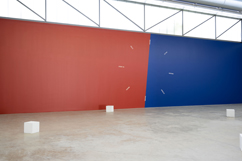
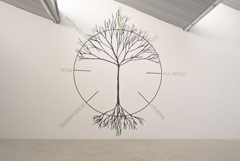
Una exposición de posters en blanco
with John Armleder, Robert Barry, Eva Barto + 1, Stefan Brüggemann, Peter Downsbrough, Liam Gillick, Florence Jung, Graciela Carnevale, Simon Morris, Olivier Mosset, Kay Rosen
Una exposición de Mathieu Copeland
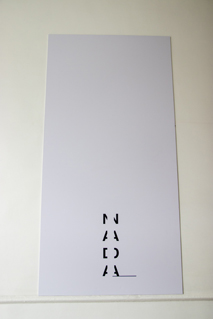
Organizada especialmente para el Festival de libros: Blanco sobre Blanco, esta exposición de posters –todos del mismo formato de 120cm x 60cm– nos ofrece la interpretación de estos artistas de la nada, el vacío, la ausencia... Al evitar las cualidades inacabadas que definen un espacio en blanco, estas obras de arte representan lo completo y absoluto, la esencia de la ausencia: un vacío, pero no páginas en blanco.
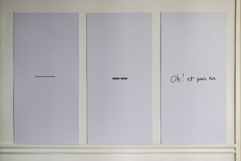
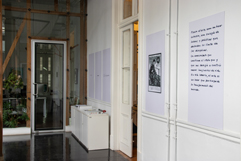
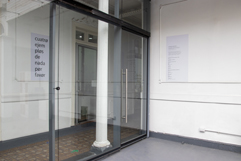
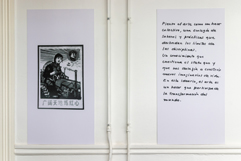
Une Situation
Robert barry
Une exposition rétrospective de Mathieu Copeland en huit volets successif
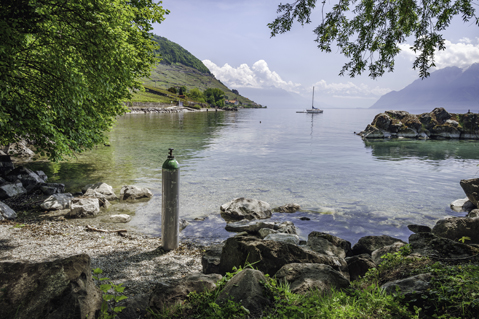
Une exposition rétrospective de l’artiste américain Robert Barry organisée en deux espaces et huit volets, dont l’œuvre s’articule autour du langage et interroge la matérialité de l’art.
L’exposition propose un regard sur l’ensemble de l’œuvre de Robert Barry, de 1964 à nos jours. Étudiant de Robert Motherwell puis de Tony Smith, Barry débute sa carrière artistique avec l’exposition 8 Young American Artists organisée par Eugene Goosen au Hudson River Museum, 11 – 25 octobre 1964, exposition aujourd'hui considérée comme l’une des premières de l’art minimal. Par l’entremise de Tony Smith, Barry obtiendra cette même année sa première exposition personnelle à la Westerly Gallery. L’exposition à CIRCUIT débute chronologiquement avec le carton d’invitation, un imprimé réalisé par l’artiste et reprenant le motif d’une des toiles présentées à l’époque. Graduellement, Barry entame un processus de réduction minimale, passant du « spot » à la grille, puis à la ligne pour réduire son motif a une toile de lin pure aux bords peints. Il réalisera par la suite des séries de peintures monochromes qui définissent l’espace, par exemple 4 toiles placées aux quatre coins du mur. Barry abandonnera la peinture au profit de la sculpture, puis en suivant son procédé de réduction, réalisera des œuvres de fils — d’abord de couleurs, puis de nylon transparent — qui littéralement mettent l’espace sous tension. Un minimalisme formel qui se contracte graduellement pour révéler l’espace entre-deux, puis ne montrer rien d’autre que l’espace vide, et le temps.
Ce principe de réduction se cristallise dans le mot. La phrase qui permet de décrire une œuvre apparemment absente (CARRIER WAVE PIECE, dites Radio Piece, et la série des gaz inertes, respectivement en janvier et mars 1969). Robert Barry passe ensuite à l’énoncé, en utilisant la galerie elle-même comme médium, et ses cartons d’invitation comme lieux de l’œuvre. Graduellement, les mots se libèrent. L’artiste cherche l’outil pour définir l’œuvre, à travers même le langage (THE DEFINING OF IT..., à partir de 1970). Une réflexion qui l’amène à se libérer de la phrase et à présenter le mot comme un objet autonome (WORD LIST PIECES, 1971-), et au final, fragmenté. Ces pièces peuvent être consultées à travers une recréation de la première exposition de l’artiste à la Galerie Leo Castelli en 1971, l’artiste présentait une documentation de ses œuvres textuelles dans six classeurs placés sur une table entourée de quatre chaises. À CIRCUIT, dans le premier espace, une évolution est visible chronologiquement par des peintures, dessins et documents provenant de prêts de collections privées, et des archives de l’artiste présentées pour la première fois au public. Ces documentations annoncent et complémentent les œuvres présentées dans le second espace.
Le second espace de CIRCUIT s’articule en huit volets. Chaque semaine, nous sommes invités à faire l’expérience d’une œuvre différente. Tout d’abord, une œuvre issue de la série de pièces dites « monofilaments ». Disposés à l’exact milieu du volume du second espace, trois fils de nylon transparents tiennent une bague en or. Lors de la seconde semaine, des ondes radio FM et AM, des signaux sans contenu, et un ultrason, sont diffusés dans cet espace vide. Pour la troisième semaine, nous subissons des radiations, une pièce originellement présentée par Harald Szeemann pour Quand Les Attitudes Deviennent Formes à la Kunsthalle de Berne en mars 1969. Le second espace de CIRCUIT se trouve entièrement vide pendant la quatrième semaine, créant une situation où nous sommes « libre de penser à ce que nous ferons », une phrase essentielle du philosophe Herbert Marcuse. La cinquième semaine, en partenariat avec le LUFF, présente une rétrospective des œuvres sonores (SOUND WORDS) que l’artiste réalise à partir du milieu des années 70, des allitérations de mots et de silences. La sixième semaine plonge l’espace dans l'obscurité, et nous présente des œuvres de diapositives (SLIDE PIECES). L’artiste poursuit depuis 1971 dans les SLIDE PIECES des recherches sur la « définition de cela » et sur l’autonomie du mot et de sa forme. Durant la septième semaine de l’exposition, CIRCUIT Centre d’art contemporain sera fermée. Cette fermeture fait partie d’une série entamée depuis 1969 où la galerie devient le médium même de l’œuvre d’art. Enfin, la huitième semaine c’est l’expérience d’une nouvelle œuvre écrite par l’artiste pour CIRCUIT où « les murs seront peints d’une couleur vive. »
Parallèlement à ces deux axes principaux sont proposés deux autres grands ensembles : une sélection rétrospective des œuvres vidéo réalisées par l’artiste entre 2004 et 2015, ainsi qu’une rétrospectives des œuvres murales en quatre pièces. Robert Barry y poursuit son étude du mot, et suivant le processus de « rematérialisation » mis en œuvre à la fin des années 60, se libère du support classique du papier ou de la toile pour considérer le mot à l’échelle du mur. Premièrement au travers du « wall drawing » réalisé lors de son exposition personnelle chez Leo Castelli en 1978, où le mur définit un espace, un carré représenté par des mots est repris ici pour la rétrospective. En face, l’œuvre YOUTO explose le mot à la taille du mur dont la hauteur donne au O son diamètre. Une pièce initialement réalisée pour son exposition personnelle à la Renaissance Society de Chicago en 1985. Suivant un processus de disposition éparse, le mot flotte sur la surface du mur, pour se couper et se fragmenter. Les deux commissions réalisées par l’artiste spécialement pour CIRCUIT prennent en compte la vitrine extérieure et le mur central. Des mots sont écrits en vinyle coloré semi-transparent sur le verre, projetant leurs reflets à l’intérieur de l’architecture du centre d’art. En face, la réflexion se poursuit avec des mots, en lettres inox découpées au laser.
Reprenant cette phrase essentielle de Lawrence Weiner qui nous rappelait peu avant sa disparition que « Robert Barry a su faire d’une situation une réalité », ses huit volets sont autant d’invitations de faire l’expérience de huit « situations ». Des moments historiques, définitifs, et radicaux de ce qu’est l’Art, ou selon l’expression de l’artiste, « cette activité que l’on nomme Art ». Inscrivant dans le temps la lecture, ces œuvres de mots et l’ensemble de ces interventions architecturales sont réinterprétées en parallèle d’une recréation des actions iconiques de l’artiste. Parmi celles-ci, les pièces transmises télépathiquement (1969), ainsi que les gaz inertes libérés dans l’atmosphère, œuvre réalisée en Californie en mars 1969. Une pièce historique recréée le 14 mai dernier sur les rives du lac Léman où 30 litres d’argon ont été retournés à l’atmosphère, dont un poster documente l’action est affiché dans l’espace public lausannois (Éditions Circuit, 2022).
Cette exposition rétrospective annonce aussi la première monographie dédiée à l’ensemble de l’œuvre de l’artiste, éditée par le curateur de l’exposition Mathieu Copeland, et publiée en 2024 par Verlag Walther und Franz Koenig.
Né en 1936 à New York, Robert Barry vit dans le New Jersey. Considéré comme l’un des précurseurs du mouvement de l’art conceptuel américain, il est titulaire d’un Master et d’un Bachelor en art du Hunter College, New York. Il a participé aux expositions : Quand les attitudes deviennent formes à la Kunsthalle de Berne et à l’Institute of Contemporary Art, Londres (1969), aux Documenta V et VII de Kassel (1972 et 1977). Depuis 1970, ses œuvres ont fait l’objet de nombreuses expositions individuelles, dont à la Tate Gallery, Londres (1972), au Stedelijk Museum, Amsterdam (1974), au Van Abbe Museum de Eindhoven (1977), au Museum of Conceptual Art, San Francisco (1978), à The Renaissance Society, Chicago (1985), ainsi qu’à la Städtische Galerie im Lenbachhaus, Munich (2001). En 2003-2004, une rétrospective de ses œuvres de 1963 à 1975 accompagnée d’un catalogue a été présentée à la Kunsthalle de Nuremberg en Allemagne et au Aargauer Kunsthaus en Suisse.
Vernissage le vendredi 23 septembre à 18h
Une exposition de Mathieu Copeland et Circuit
du 24 septembre au 19 novembre 2022
Du mardi au samedi de 14h à 18h
et sur rendez-vous
Dimanche 20 novembre, dernier jour,
14h une conférence de Mathieu Copeland
Entrée libre
Cinquième volet en partenariat avec le LUFF
PSYCHIC WORKSHOP: TELEPATHY, SECRETS AND READINGS avec Robert Barry & Mathieu Copeland
luff.ch | circuit.li
Ill: INERT GAS SERIES / ARGON / D'UN VOLUME MESURE A UNE EXPANSION INDEFINIE / 14 MAI 2022, 14H15 (photographie Wally Veronesi, Edition circuit 2022)
Huit volets successifs:
du 23 au 30 septembre 2022:
Untitled (monofilament piece - ring), 1968
du 30 septembre au 7 octobre 2022:
Carrier Wave Pieces, 1968-
88 mc Carrier Wave (FM), 1968
88 megacycles; 5 milliwatts, 9 volt DC Battery
1600 kc Carrier Wave (AM), 1968
1600 kilocycles; 60 milliwatts; 110 volts AC/DC
Ultrasonic Piece, 1969
40 KHZ Ultrasonic soundwave installation, January 4, 1969, 8.25 mm ultrasonic soundwave
du 7 au 14 octobre 2022:
Radiation Piece, 1969-
Radium 233
du 14 au 21 octobre 2022:
MARCUSE PIECE, 1971-
Des lieux où nous pouvons nous rendre et où, pour peu de temps, nous « serons libres de penser a ce que nous ferons. » (H. Marcuse)
Some places to which we can come, and for a while, “be free to think about what we are going to do.” (H. Marcuse)
du 21 au 28 octobre 2022:
SOUND PIECES
PORTRAIT, SIDE A + B, 1976
VARIATIONS (NO. 1), A + B, 1977
VARIATIONS (NO. 3), TK1 + TK2
DON’T BE SO SURE, A + B, 1980
CELEBRATE, undated
ONLY, undated
Otherwise (LP), Van Abbemuseum, 1981
Sky Land Sea: A Sound Piece, 1997, Villa Arson
du 28 octobre au 4 novembre 2022:
IT CAN SEEM TO BE, 1972
slidepiece
WORDS WITH BLUE CIRCLE, 1974
slidepiece
du 4 au 11 novembre 2022:
FOR THE EXHIBITION FROM NOVEMBER 4 THROUGH NOVEMBER 10 2022 THE ART CENTER WILL BE CLOSED ART CENTER WILL BE CLOSED
POUR L’EXPOSITION LE CENTRE D’ART SERA FERMÉ DU 4 AU 11 NOVEMBRE 2022
du 11 au 19 novembre 2022:
To paint each wall a bright colour, 2022
Ce projet est possible grâce au soutien de la Fondation Leenaards
Circuit bénéficie du soutien de : Ville de Lausanne, État de Vaud, Loterie Romande et Profiducia Conseils SA
Remerciements à : Alfatih ; Alfonso Artiaco Gallery et Francesca Fattori ; Antoine ; Archivio Paolo Mussat Sartor ; Benoît Moreau ; Eliot Möwes ; Francis Baudevin ; Françoise et Jean-Philippe Billarant ; Giancarlo Mino ; Jan Mot ; Jennifer Bochud ; Kenneth Goldsmith ; Marie-Christine Gailloud ; Matthieu ; Masen Al-Saghir ; Mathieu Bulliard ; Michel Québatte, Art-Vannerie Rotin Sàrl ; Natacha Anderes ; Nicolas Eigenheer ; Petya Ivanova ; Raphaël Raccuia ; Stéphane Ibars et la Collection Lambert ; Thibault Walter ; Vincent Barras ; Bernar Venet ; Wally Veronesi ; Warren Neidich
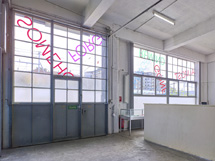
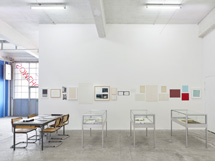
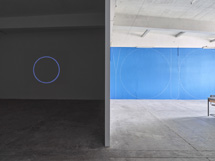
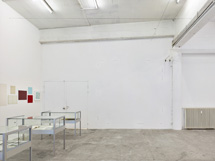
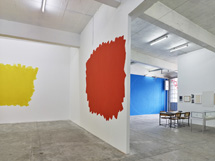
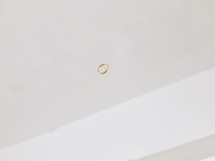
A Staged Exhibition
La Ferme du Buisson,
Saturday 11 September, 2021 @6pm
performer Jennifer Lacey
composition and music Laetitia Sadier (assisted by Hannes Plattmeier)
with Art & Language, Fiona Banner aka The Vanity Press, Robert Barry, Luis Camnitzer, Braco Dimitrijević, Coco Fusco, Giovanna, Joseph Grigely, Swetlana Heger, Florence Jung, Ghislaine Leung, David Medalla and Michael Portnoy
backdrop Gaylen Gerber
an exhibition by Mathieu Copeland
-LR.jpg)
Pursuing his investigation into the nature of an exhibition, curator Mathieu Copeland transposes the exhibition to the stage for the duration of a show. Descriptions of dreamed, real, or vanished artworks written by a dozen artists for A Staged Exhibition are interpreted through gestures, words and music by choreographer and dancer Jennifer Lacey and composer and musician Laetitia Sadier against a backdrop by Gaylen Gerber.
Following A Choreographed Exhibition, presented at the Contemporary Art Centre in 2008, and the book and the festival Choreographing Exhibitions in 2013, curator Mathieu Copeland returns to La Ferme du Buisson with A Staged Exhibition (Une exposition mise en scène). Working with the theatre’s spatial and temporal parameters, Copeland experiments and collaborates with Lacey and Sadier to interrogate the way works are articulated from one to the other, confronted in their singularity and interpreted as a tableau vivant that transposes works by an international and intergenerational grouping of artists including Art & Language, Fiona Banner aka The Vanity Press, Robert Barry, Luis Camnitzer, Braco Dimitrijević, Coco Fusco, Giovanna, Joseph Grigely, Swetlana Heger, Florence Jung, Ghislaine Leung, David Medalla and Michael Portnoy.
Jennifer Lacey pursues her investigation in breaking free from the spectacular to find a playful and inventive hermeneutics of the body as she performs written or described works commissioned specifically for A Staged Exhibition. Laetitia Sadier enters into resonance, or dissonance, with the exhibition taking place in parallel to offer a sound exhibition within a staged one. In a minimalist setting, American artist Gaylen Gerber creates – for the first time in his career – a work for a theatrical context. Invited to reinterpret what a theatrical backdrop can be, Gerber continues his decades-long exploration of Backdrops and how they draw attention to the works presented and to their presentation.
Shedding the physical reality of the object, A Staged Exhibition focuses on the emotional experience of a work, lived in the present tense as an exhibition that exists solely through the prism of the lived actions. Fundamentally influenced by the art of Robert Barry – whose own oeuvre conveys the feeling of art without ever fully revealing it – A Staged Exhibition offers the mediation of works of art that occur only in their interpretation.
.jpg)
_R.jpg)
.jpg)
_R.jpg)
Une exposition mise en scene
La Ferme du Buisson,
Samedi 11 September, 2021 @ 6pm
interprète Jennifer Lacey
composition et musique Laetitia Sadier (assistée par Hannes Plattmeier)
avec Art & Language, Fiona Banner, Robert Barry, Luis Camnitzer, Braco Dimitrijević, Coco Fusco, Giovanna, Joseph Grigely, Swetlana Heger, Florence Jung, Ghislaine Leung, David Medalla, Michael Portnoy
fond de scène Gaylen Gerber
une exposition de Mathieu Copeland
_R (3).jpg)
Poursuivant sa réflexion sur la nature même d’une exposition, le commissaire Mathieu Copeland transpose l’exposition à la scène le temps d’un spectacle. Des oeuvres rêvées, réelles, ou disparues – proposées spécifiquement pour Une exposition mise en scène par une dizaine d’artistes – sont interprétées par la chorégraphe et danseuse Jennifer Lacey et la compositrice et musicienne Laetitia Sadier sur un backdrop de Gaylen Gerber. Ces oeuvres offrent ainsi leurs sensibilités par leur mise en gestes, mots et musique.
Déroulant le fil tissé depuis Une exposition chorégraphiée présentée en 2008 au Centre d’art contemporain et prolongé avec le livre et le festival Chorégraphier l’exposition en 2013, le commissaire Mathieu Copeland revient à la Ferme du Buisson et conçoit Une exposition mise en scène. Au sein des paramètres fournis par l’espace et la temporalité du théâtre, en envisageant les ressources qui lui sont propres, Mathieu Copeland expérimente, en collaboration avec la chorégraphe et danseuse Jennifer Lacey et la compositrice et musicienne Laetitia Sadier, la manière d’articuler les oeuvres les unes aux autres, de les confronter dans leur singularité et d’envisager leur interprétation.
Art & Language, Fiona Banner aka The Vanity Press, Robert Barry, Luis Camnitzer, Braco Dimitrijević, Coco Fusco, Giovanna, Joseph Grigely, Swetlana Heger, Florence Jung, Ghislaine Leung, David Medalla et Michael Portnoy sont invité·e·s à écrire ou décrire une oeuvre pour Une exposition mise en scène. Le temps d’un spectacle, les oeuvres pensées par ces artistes internationaux·ales de différentes générations sont transposées par Jennifer Lacey et Laetitia Sadier, formant littéralement un tableau vivant.
Jennifer Lacey poursuit sa recherche qui consiste à s’émanciper du spectaculaire pour retrouver une herméneutique espiègle et inventive du corps lorsqu’elle interprète les oeuvres spécifiquement pensées pour Une exposition mise en scène. Laetitia Sadier entre en résonance ou dissonance avec l’exposition qui se joue en parallèle, et pour ainsi dire offre une exposition sonore au sein d’une exposition mise en scène. Dans un décor minimaliste, Gaylen Gerber, artiste plasticien américain rarement présenté en France, réalise pour la première fois une oeuvre dans un contexte théâtral. Invité à réinterpréter ce que peut être le fond de scène, il poursuit ainsi la réflexion qu’il mène depuis quelques années dans le cadre d’une série d’oeuvres nommée Backdrops (littéralement des toiles de fond initialement destinées à la photographie commerciale), qui sont ajustées aux murs des espaces d’exposition, attirant l’attention sur les oeuvres présentées et sur leur présentation elle-même.
Se délestant de la réalité physique de l’objet, Une exposition mise en scène se concentre sur le sentiment d’une oeuvre et le prisme de l’expérience vécue. L’exposition offre la médiation d’oeuvres d’art qui n’existent que dans leur interprétation. Se confrontant à la nature même de ce qu’elle peut être, Mathieu Copeland transpose l’exposition à la scène le temps d’un spectacle. Fondamentalement influencé par l’art de Robert Barry – auteur d’une oeuvre qui offre le sentiment d’une œuvre d’art sans jamais la révéler pleinement – Une exposition mise en scène s’écrit toujours au présent.
.jpg)
Exhibition Cuttings
Le Forum, Ginza Maison Hermes,
April 23rd (Fri.) - Julz 18th (Sun.), 2021
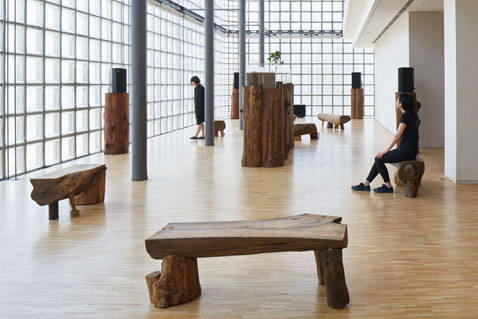
The Fondation d’entreprise Hermès is pleased to present “Exhibition Cuttings”, a new exhibition by London-based French/British curator Mathieu Copeland and his first in Japan. Since 2003, Copeland (born in 1977) has been using exhibitions as a platform to question their traditional roles and frameworks, through a curatorial practice that proposes new ways of experiencing and perceiving exhibitions.
“Exhibition Cuttings” is an exhibition of two exhibitions – “The Anti-Museum: And Anti-Documentary” and “Nurturing Exhibitions” –, and is conceived from the two meanings of the word ‘cutting’. The first refers to the ‘cutting and grafting’ in plant propagation. This also offers an echo to the fleeting ecosystem of this exhibition, in which a work of art is temporarily cut out, transplanted to the gallery space, and nurtured with the viewer throughout its duration. The other refers to the more familiar meaning of the word, the editing process of newspaper clippings and movies, and relates ‘cutting’ from the archives of past exhibitions.
Nurturing Exhibitions
The first gallery space, which refers to ‘cutting and grafting’, opens up an environment filled with sounds, music pieces commissioned especially for the exhibition to Phill Niblock, one of the greatest composers of experimental and minimalist music and known for his sound filled with microtones (drone music). The six new compositions were performed by the Ensemble IRE, David Maranha, Stephen O’Malley, Deborah Walker, Elisabeth Smalt and the Japanese vocal group Vox humana who recorded in Tokyo during the Pandemic Exploratory, Rhine version – “Looking for Daniel”. The music, along with the natural light that fills the gallery comprising the wooden display-structures realised by Nao Nishihara, nurture the soil and the Amanatsu orange tree that are at the centre of the room and came from – and will return to, after the exhibition – the Masanobu Fukuoka Natural Farm. Masanobu Fukuoka’s one straw revolution began with this soil, a fundamental and radical philosophy that continues to bear its fruits today as one of the greatest tools against mass extinction and climate change. Nature nurtured creates an Environment. A fertile ground where ultimately the soil and tree are both what is exhibited, and what exhibits.
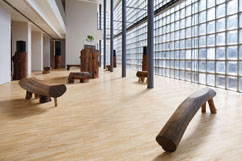
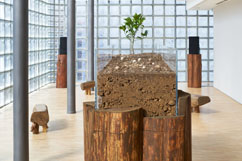
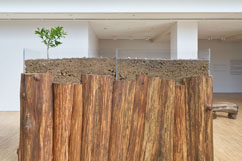
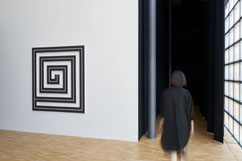
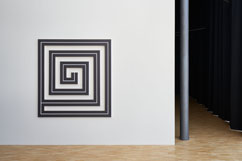
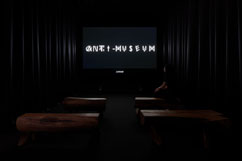
The Anti-Museum: An Anti-Documentary
The second gallery space is literally introduced by a moral maze painting by Philippe Decrauzat, a painting whose shape is literally informed by the exhibition layout. There, we revisit Copeland’s past exhibition, “A Retrospective of Closed Exhibitions” (Fri Art Kunsthalle, Fribourg, 2016) and his publication “The Anti-Museum” (König Books, 2017), through the film “The Anti- Museum: An Anti-Documentary”. The ongoing pandemic has forced many cultural institutions to close. This film, narrated by Henry Rollins to a soundtrack composed by FM Einheit and directed by Céline Fitzmaurice, re-examines the history and meaning of the act of closure performed by artists as artistic gestures, and in doing so, seeks to redefine the limits and debates around institutions in art and spaces for exhibitions.
Through cutting, grafting, and editing, Copeland explores the possibilities of exhibitions as an invitation to experience new territories, rich ecosystem nurtured by new hybrid organisms.
The exhibitions opened on Thursday the 22nd of April, to close the following Sunday due to a new lockdown in response to the sanitary situation in Tokyo. I immediately invited Robert Barry to realise a new closed gallery piece – a piece that is at the centre of the Anti-Documentary. During such a desperate situation, the piece that Barry began in 1969 acquires yet another meaning, further questioning the triumvirate of Gallery, Exhibition and Closure. During the lockdown, with the exhibition happening whilst the gallery is closed, bathed in natural light and the minimal compositions by Phill Niblock and with the spectators forcefully excluded, alone in the intimacy of the gallery, the tree began to bloom…
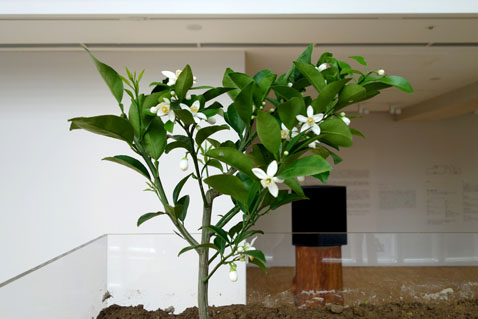
An exhibition by Mathieu Copeland
The Need for Art to Change the World
An International Symposium on Gustav Metzger
Department of Art & Media (DKM)
Zurich University of the Arts
Oct 10-12, 2019
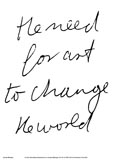
Gustav Metzger’s (1926-2017) entire oeuvre is defined by his writings. Since 1959, his manifestos have been the cornerstone of his radical and everlasting impact on art, art history and society. Metzger has done more than raise awareness, his art and philosophy are a stark testimony to the alternative world for which he strove. Organised to coincide with the release of the all-encompassing anthology Gustav Metzger: Writings (JRP | Editions, Oct 2019), this international symposium brings together Kristine Stiles, Ivor Davies, FM Einheit, Catherine Mason, Jonathan Benthall, Andrew Wilson, Norman Rosenthal, Jerome R. Ravetz and Hans Ulrich Obrist to envisage Metzger’s art, philosophy and imperatives: autodestructive and auto-creative art, the Destruction in Art Symposium DIAS (London 1966), computer arts, the crisis in technological art, and the social responsibility of artists.
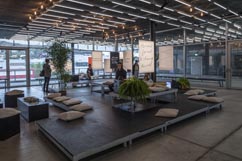
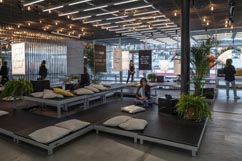
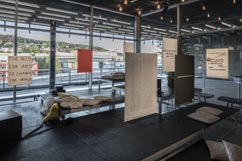
Concerned with the looming threat of extinction, Gustav Metzger sought to create “worldwide movements in response to the accelerating decimation of the natural world through human-made activities leading to mass extinction.” To offer a prospective outlook, this symposium aims to provoke, expose and discuss the fundamental theses of our societies and the state of our world in a time of climate crisis, set within a specially designed documentation lounge where videos and audio recordings on and by Metzger will be shown, alongside an exhibition of posters by artists Ursula Biemann, Graciela Carnevale, Cécilia Cavalieri, Ivor Davies, Swetlana Heger, Karl Holmqvist, Franck Leibovici, Liliane Lijn, David Medalla, Gustav Metzger, Ben Morea, Phill Niblock, Karin Sander, Rirkrit Tiravanija, Ben Vautier, Jacques Villeglé, who each wrote the sentence that gave this symposium its title – THE NEED FOR ART TO CHANGE THE WORLD – which Metzger coined in 1993 and strongly resonates now more than ever.
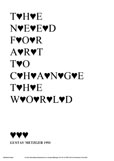
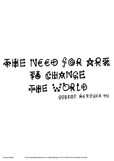
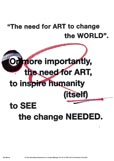
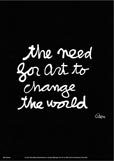
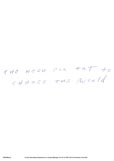
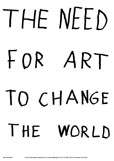
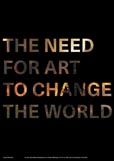
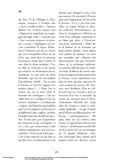
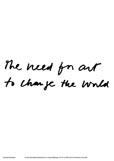
Oeuvres sur papier
Gustav Metzger
Une exposition de Mathieu Copeland et Circuit
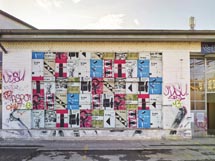
Gustav Metzger (1926-2017) considérait ses écrits équivalents à ses oeuvres.
C’est en préambule à la parution de Gustav Metzger – Writings 1953-2016 chez JRP|Editions, une anthologie réunissant l’intégralité des écrits de l’artiste, que Circuit invite Mathieu Copeland (artiste, commissaire et chercheur), spécialiste de cette archive et éditeur de cette anthologie, à concevoir le déroulé spatial et expositif de cette documentation. Gustav Metzger, considéré et reconnu pour ses oeuvres à caractère performatif et installatif, toujours affiliées au principe d’auto destruction, employait affiches, publications et autres manifestes comme des outils d’annonce, mais aussi comme documentation matérielle à ses interventions éphémères.
Lors de sa première démonstration publique d’art auto-destructif, Metzger recouvre de journaux les murs de la galerie dans laquelle il intervient, insistant sur la notion de présent. Il s’y applique selon ses dires à relever l’immédiateté du maintenant. Cet intérêt précoce et récurrent de Metzger pour les quotidiens – omniprésent dans son oeuvre – est abordé dans l’exposition par la réactualisation de nombreuses oeuvres protocolaires de l’artiste disparu.
Mass Media inaugurait dès 1970, l’importance de l’inclusion du public à sa démarche. L’artiste invitait les visiteurs à choisir puis découper des articles de presse dans des quotidiens mis à disposition durant l’exposition, sur des thèmes de société prédéfinis par l'artiste. Cette intégration de considérations participatives lui permettra de diffuser et inciter des réflexions écologiques et humanistes avant que ces préoccupations ne deviennent des sujets d’actualité urgents.
L’exposition de Gustav Metzger intitulée Oeuvres sur papier, propose l’accès et la consultation de documents issus des archives personnelles de l’artiste, essence de son développement artistique et politique.
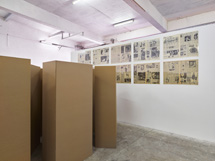
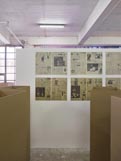
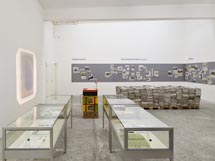
Visite guidée, mer 21 nov à 19h
par Mathieu Copeland
Entrée libre
L’EXPOSITION D’UN RÊVE
7 octobre – 17 décembre 2017
Les rêves de Gabriel Abrantes, Genesis Breyer P-Orridge, FM Einheit, Tim Etchells, Alexandre Estrela, Susie Green, David Link, Pierre Paulin, Emilie Pitoiset, Lee Ranaldo, Susan Stenger et Apichatpong Weerasethakul
Interprétés par FM Einheit avec Volker Kamp, Robert Poss, Susan Stenger, Erika Stucky, Saskia von Klitzing et les chanteurs du Choeur Gulbenkian
Joués à travers les Mandalas de José de Almada Negreiros, Philippe Decrauzat, Myriam Gourfink, Olivier Mosset et Eduardo Terrazas
Une exposition de Mathieu Copeland
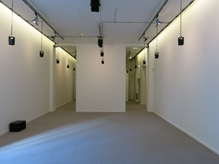
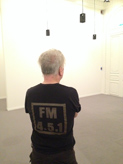
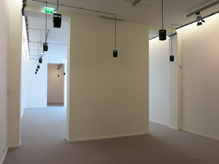
Cette exposition a été pensée dans un lieu très précis : le jardin Gulbenkian. Conçu par António Viana Barreto et Gonçalo Ribeiro Telles dans les années 60, le jardin encadre actuellement le bâtiment où le rêve de Calouste Gulbenkian prend forme chaque jour.
L’exposition telle qu’elle se propose s’inspire littéralement des rêves de cinéastes et de dramaturges, de poètes et d’écrivains. Leurs rêves ont été mis en musique par le musicien allemand F. M. Einheit puis enregistrés à la Fondation et dans son jardin, grâce à la contribution de nombreux musiciens et du Chœur Gulbenkian tout au long de 2017.
Un intéressant dialogue s’offre ici : le rêve et l’immatérialité d’une exposition et la matérialité très concrète d’une institution comme la Fondation Gulbenkian. L’architecture, l’institution, le jardin, selon les mots du commissaire Mathieu Copeland viennent « renseigner l’exposition et, en retour, l’exposition utilise l’institution ».
Le rêve – en tant que manifestation des désirs et des peurs (dans une lecture freudienne), support des voix de l’inconscient (parfois de voix de l’autre monde), mais aussi outil de création, le rêve comme élément constitutif de mythologies – est le fil conducteur de cette exposition.
Parallèlement, les abstractions géométriques (cf. Almada Negreiros) ou mystiques (les mandalas, des diagrammes symboliques qui jouent un rôle dans de nombreuses traditions religieuses ou même dans l’école jungienne de psychologie) tiennent ici une place importante. Ce projet donne lieu à ce que le commissaire appelle polyphonie, conçue par un « auteur-multiple », explorant les dimensions de l’immatérialité d’une exposition.
Exposition ouverte lundi, mercredi, jeudi et vendredi de 9h à 18h
Samedi, dimanche et jours fériés de 11h à 18h
--
Rencontre avec Mathieu Copeland et FM Einheit autour de L'exposition d'un rêve
Jeudi 16 novembre, 2017 - 19:00 Jusqu'à 20:30
Lors de cette discussion, Mathieu Copeland, le commissaire de L’exposition d’un rêve, et FM Einheit, le compositeur des chansons à partir des rêves de douze artistes, présenteront et discuteront de l’exposition, et reviendront sur l’ensemble de la carrière de FM.
Mathieu Copeland (né en 1977, vit à Londres) cultive une pratique curatoriale cherchant à subvertir le rôle traditionnel des expositions et à en renouveler nos perceptions. Il a notamment été co-commissaire de l’exposition «Vides, une rétrospective » au Centre Pompidou à Paris en 2009 et à la Kunsthalle de Berne et a récemment édité « The Anti Museum », co-publié par Koenig Books en 2017. Il a été commissaire invité du Musée du Jeu de Paume, Paris (2013-2014) et, avec Philippe Decrauzat, commissaire invité du Plateau – FRAC Ile-de-France Paris (2014-2015).
FM Einheit (né en 1958) est un musicien, compositeur et performeur allemand, pionnier de la musique industrielle. Co-fondateur du mythique groupe allemand Einstürzende Neubauten, il poursuit aujourd’hui une intense carrière solo qui allie l’énergie et l’urgence du mouvement punk aux expérimentations issues de la musique bruitiste. FM Einheit a enregistré de nombreux albums et collaboré notamment avec Diamanda Galás, Andreas Ammer, Pan Sonic, Gry ou encore Caspar Brötzmann.
La conversation aura lieu en anglais.
UNA EXPOSICIÓN COREOGRAFIADA
16 SEPTIEMBRE — 15 OCTUBRE 2017
INAUGURACIÓN 16 SEPTIEMBRE 11:00
UNA EXPOSICIÓN DE MATHIEU COPELAND
Una exposición coreografiada consta únicamente de movimientos. Reúne las obras coreografiadas para la exposición por artistas, coreógrafos y músicos de fama internacional. Durante un mes, tres bailarines ocupan constantemente los espacios de exposición e interpretan una coreografía de gestos, figuras y desplazamientos, con arreglo a las partituras e instrucciones escritas por Cecilia Bengolea, Fia Backström, Jonah Bokaer, Tim Etchells, Karl Holmqvist, Jennifer Lacey, Roman Ondák, Michael Parsons y Michael Portnoy.
En ausencia de decorado, luz dramática y música, los gestos "resuenan" en las galerías vacías del CA2M, donde los bailarines centran toda la atención. Lo único que acompasa las representaciones son los horarios de apertura del centro de arte y la duración de la exposición. Los gestos, encadenados en un continuum sin fin, se convierten en formas abstractas y flotantes que se despliegan y vagan por el espacio.
La relación con el espectador queda profundamente alterada: ya no es él quien da vueltas alrededor de las obras, sino ellas las que dan vueltas a su alrededor y le arrastran con su impulso. La proximidad turbadora de los bailarines y sus desplazamientos, a menudo imprevisibles, le obligan a ponerse él también en movimiento, a cambiar permanentemente de posición.
Una exposición de Mathieu Copeland que se forma y evoluciona a lo largo del tiempo y solo se fija en la memoria, porque al final lo único que queda es el recuerdo de los gestos efectuados.
Una exposición coreografiada es una coproducción original de la Kunsthalle de St Gallen (Suiza) y de la Ferme du Buisson, de Noisiel (Francia), donde la exposición se celebró, respectivamente, del 1 de diciembre de 2007 al 13 de enero de 2008 y del 8 de noviembre al 21 de diciembre de 2008. La muestra es un hito importante en la historia de las exposiciones y su relación con la danza y las artes visuales. Retomada, modificada y ampliada siguiendo las pautas de la exposición original, Una exposición coreografiada se programa de nuevo del 16 de septiembre al 15 de octubre de 2017 en el CA2M, ocupando los espacios del centro de arte para brindar la experiencia única de una exposición de movimiento con un conjunto de formas desbordantes y de posibles significados.
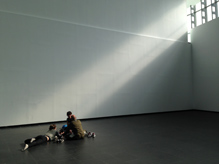
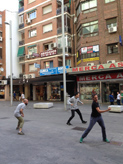
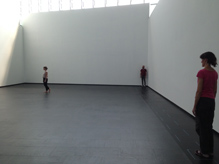
INTÉRPRETES
Joaquín Abella, Pablo Durango, Amalia Fernández, David Herraez, Inma Marín, Lara Ortiz, Patricia Roldán Y Tania Arias Winogradow.
WORD SQUARES
KARL HOLMQVIST
Karl Holmqvist works with language. His art is that of an exhibition of words, a majestic experience of Concrete (and Wood, and Steel, and…) Poetry, in all its different manifestations: spoken words, recorded words, words written on the wall, words made wallpaper, words incarnated as so many platforms of communications, word paintings of 183cm, four-letter word sculpture, fluorescent tubes four letters word pieces, spoken word sculptures…
Holmqvist renders the structure of concrete poetry through the concrete of concrete. Its metallic armature structures the form of a name (KARL), an adjective (NICE), or again a noun (LIFE). The subject is the matter, both abstracted in form, and structured in concrete matter. Holmqvist makes of the logos of his name a logo (WE ME), a personal icon as a signature (LRAK) in space.
Give Poetry a try. Holmqvist’s platforms for communications makes use of the dormant material present in everyone who hears/reads him, calling up the memory of these very words from within. Holmqvist works how words and phrases tend to repeat in memory and how this in turn shapes the way we view the world around us. More than mere appropriation, the words used by the artist literally echo in the reader’s/listener’s mind, claiming both Spoken Words to the World, and Spoken Worlds to the Word.
The popular memes and pop culture artefacts become material in all their sculptural, structural, textural qualities. To read/hear is to convene all that mind-materiality into the time-construct of a spoken word sculpture. To hear/read Holmqvist homophony – the words sound the same (and are the same) – cast a radical new appreciation of words as material, as they blend into a mental duet between the artist and the source of origin of these words with us reader/hearer as abstract sing-alongs. Holmqvist words are squared, squares squared in a given squared surface. With words as ready-made sculptures, the language is an existing material multiplied by itself.
CURRICULUM VITAE
EARLY ONE MORNING AT THE END OF MAY 2007 I dreamt I was in bed with Joe d'Allesandro and Iggy Pop. We were lying naked only covered by a thin, white sheet in a bed surrounded by cameras and lightpeople etc. involved in making a photoshoot or commercial of some kind. Iggy Pop and Joe d'Allesandro were on either side of me forming a kind of human sandwich. With their hard bodies and long hair the two of them were sexy beyond comprehension, but also both very attentive and affectionate. It went on for some time with us giggling and tickling and hugging each other before I woke up surprised or even shocked at how vivid and really, really nice it had all been.
--
One night I dreamt I was part of recording a commercial for a real estate company. It was directed by my friend Danh Vo standing at the ready with a megaphone behind the camera and crew. I was sitting behind my boyfriend on a motorcycle, he was wearing really tight white jeans and a black motorcycle leather jacket. I was holding onto him with one hand on each side of his hips. No helmet. We rolled up a short distance in front of a white apartment building and he motioned with his hand and exclaimed; "-Here, all are welcome!" before he turned around and kissed me passionately with the camera coming to a close zoom. AND CUT.
KH 2009
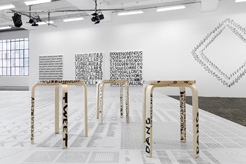
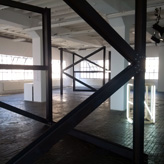
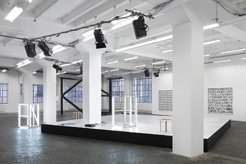
An exhibition by Andrea Bellini & Mathieu Copeland
UNE RETROSPECTIVE D’EXPOSITIONS FERMEES / A RETROSPECTIVE OF CLOSED EXHIBITIONS, Kunsthalle Fribourg, 05.08 - 19.11.2016
Une Rétrospective d’expositions fermées / A Retrospective of Closed Exhibitions
05.08 - 19.11.2016
Du 6 août au 19 novembre 2016 Fri Art propose une rétrospective radicale composée de onze fermetures de l’espace du Centre d’art– à la suite les unes des autres – par onze artistes différents. Le 19 novembre, une grande fête se tiendra dans l’espace réouvert de Fri Art et un important catalogue anthologique de 600 pages sur l’Anti-Musée sera publié pour l’occasion.
Lefevre Jean Claude – 19.08.2016
Swetlana Heger & Plamen Dejanov 20.08.2016 – 26.08.2016
Santiago Sierra 30.08.2016 – 05.09.2016
Graciela Carnevale 08.09.2016 – 14.09.2016
Rirkrit Tiravanija 17.09.2016 – 23.09.2016
Robert Barry 26.09.2016 – 02.10.2016
Matsuzawa Yutaka 05.10.2016 – 11.10.2016
Maria Eichhorn 14.10.2016 – 20.10.2016
Maurizio Cattelan 22.10.2016 - 28.10.2016
Daniel Buren 02.11.2016 – 08.11.2016
Hi Red Center 13.11.2016 – 19.11.2016
Ouverture 19.11.2016 + Party
Une exposition de : Mathieu Copeland
La Rétrospective d’expositions fermées a débuté le 6 août dernier, au début de la pause estivale officielle de Fri Art avec l’exposition de Lefevre Jean Claude. Jusqu’au 19 novembre, onze expositions engendrant chacune une manière différente de fermer l’espace d’exposition se succèdent à un rythme quasi hebdomadaire pour former Une Rétrospective d’expositions fermées. Depuis le début des années 1960, des artistes ont pris le parti radical de fermer des musées ou des galeries pour faire œuvre. Ces gestes historiques sont réactivés spécialement pour le contexte de Fri Art en étroite collaboration avec les artistes ou leurs héritiers. Ces œuvres sans compromis nous confrontent à la fermeture de l’espace et nous invitent à expérimenter leur réalité physique, sensible, ou encore conceptuelle. Se déployant dans le temps, sur le mode d’une répétition quasi beckettienne d’un motif récurrent, mais selon des modes d’action très divers, ce projet se veut expérimental dans sa manière d’aborder le genre de la rétrospective. L’exposition explore les extrêmes limites du champ de l’art et défie les attentes des visiteurs en mettant en jeu des questions autant esthétiques que politiques. Si des termes comme « anti-lieu », « anti-art », « anti-galerie commerciale » sont souvent utilisé par les artistes des années 1960, les gestes de fermeture des quinze dernières années sont accompagnés de questionnements sur le travail, le temps et le système économique de l’art.
Ces gestes ne signent pas une négation totale de l’art. Comme l’histoire nous l’a apprise, les tabula rasa indiquent toujours un renouvellement. Des artistes comme Daniel Buren ou Maurizio Cattelan (dont les expositions fermées constituaient leur toute première exposition personnelle) ont développé par la suite de longues carrières très productives. Une installation de Buren occupe actuellement la totalité du toit de verre de la Fondation Louis Vuitton à Paris, tandis que Cattelan participe à la Biennale Manifesta de Zurich après avoir bénéficié d’une rétrospective tonitruante au Guggenheim Museum de New York (2011).
Les onze expositions fermées
Lefevre Jean Claude présentait une réplique de son œuvre de 1981, qui consistait à profiter de la fermeture estivale de la galerie Yvon Lambert à Paris pour énoncer une exposition qui n’existait que par le texte apposé aux vitrines, une œuvre performative, au sens linguistique du terme, qui annonçait simplement « une exposition de lefevre jean claude 11.07/31.08 ‘81 ». (Jusqu’au 19 août 2016)
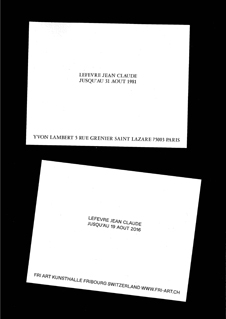
Swetlana Heger & Plamen Dejanov, un duo d’artistes aujourd’hui séparé, développent une réflexion sur les conditions économiques de l’art. En février 1999, ils envoyaient le personnel de la galerie berlinoise Mehdi Chouakri en vacances et fermaient de fait l’espace. La pancarte originale de l’exposition annonçant la fermeture pour vacances de la galerie berlinoise est installée sur la porte du rez de Fri Art et en interdit l’accès. (20 au 26 août 2016)
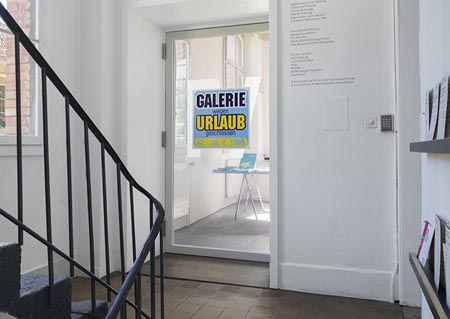
En écho à la crise financière qui ébranlait l’Argentine en 2002, Santiago Sierra avait bloqué avec le même acier ondulé utilisé par les banques pour se protéger de leurs clients un autre type d’institution financière : la Lisson Gallery de Londres. (du 30 août au 5 septembre 2016)
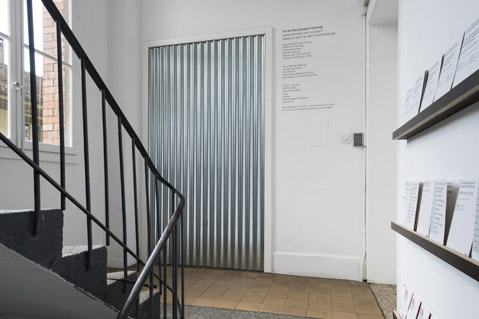
Pour l’exposition qu’elle présentait en octobre dans le cadre de l’Experimental Art Series qu’elle co-organisait durant l’année 1968 à Rosario en Argentine, Graciela Carnevale enfermait à son insu le public dans la galerie, faisant ainsi écho au régime dictatorial et répressif militaire. Au bout de quatre heures, un passant avait fini par briser la vitre, libérant les spectateurs. (du 8 au 14 septembre 2016)
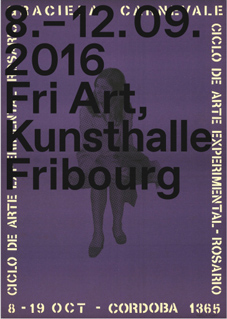
Rirkrit Tiravanija, invité en 2007 à inaugurer l’espace d’exposition de l’Ontario College of Art and Design à Toronto, bloquait l’entrée avec des parpaings sur lesquels il reprenait le slogan situationniste : « Ne travaillez jamais ». (du 17 au 23 septembre 2016)
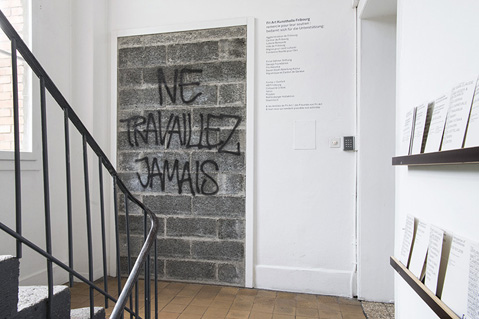
Robert Barry annonçait en 1969 que durant l’exposition, les galeries Eugenia Butler, Art & Project et Sperone seraient fermées. L’artiste manifestait ainsi une velléité critique contre le marché de l’art, se posant volontairement comme « anti-galerie ». (du 26 septembre au 2 octobre 2016)
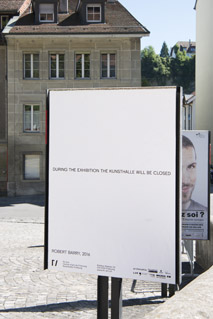
En octobre 1964, à la galerie Naiqua, Matsuzawa Yutaka, avec « Ah, Nil, Ah, A Ceremony of Psi’s Secret Embodiment Drowning in the Wilderness: Prototype Exhibition », affirmait par sa fermeture la galerie comme « anti-lieu ». (du 5 au 11 octobre 2016)
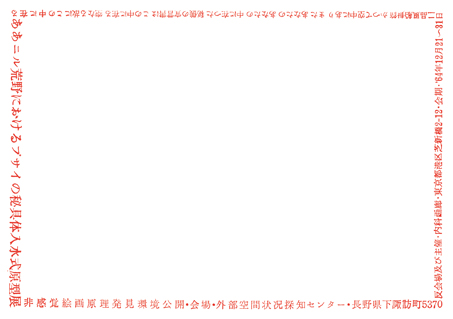
Au printemps de cette année, Maria Eichhorn demandait à l’ensemble des employés de la Chisenhale Gallery à Londres de soustraire leur travail de l’institution, et ainsi fermait par nécessité le centre d’art pour cinq semaines, soit 25 jours ou 175 heures de travail non acquittées. (du 14 au 20 octobre 2016)
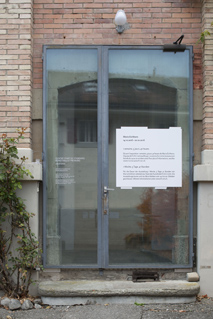
Maurizio Cattelan, l’artiste italien bien connu du grand public pour ses sculptures provocatrices citant le Pape ou Hitler, fermait en 1989 la galerie Néon à Bologne pour sa première exposition personnelle, ne laissant visible qu’un écriteau annonçant « torno subito », soit « je reviens tout de suite ». (du 22 au 28 octobre 2016)
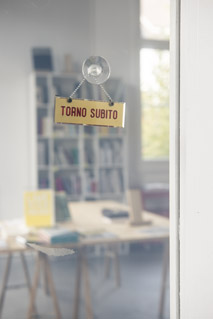
Également pour sa première exposition personnelle à la galerie Apollinaire de Milan fin octobre 1968, Daniel Buren présentait un travail consistant à fermer la galerie le temps de l’exposition en recouvrant totalement la porte d’entrée avec des papiers peints rayés blanc et vert. Par ce geste, l’artiste indiquait son refus de la galerie, et d’une partie de ses fonctions. (du 2 au 8 novembre 2016)
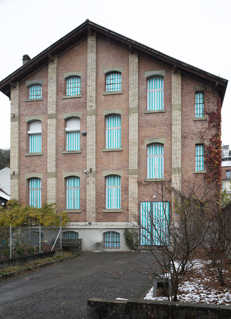
En mai 1964, au travers de Great Panorama Exhibition, le collectif japonais Hi Red Center fermait la galerie Naiqua de Tokyo. Comme le rappelait Akasegawa Genpei, « ce grand panorama mettait l’univers en boîte ». (du 13 au 19 novembre 2016)
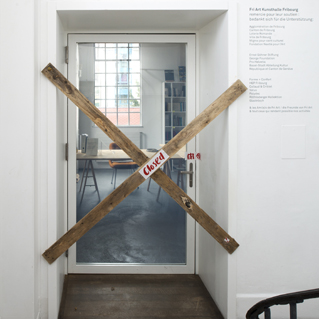
--
A Retrospective of Closed Exhibitions
From 6 August to 19 November 2016, Fri Art proposes a radical retrospective consisting of eleven closures of the art centre space – one following the other – by eleven different artists. On 19 November, a large celebration will mark the re-opening of Fri Art space, along with the release of a major anthological publication entitled “The Anti-Museum”.
Lefevre Jean Claude – 19.08.2016
Swetlana Heger & Plamen Dejanov 20.08.2016 – 26.08.2016
Santiago Sierra 30.08.2016 – 05.09.2016
Graciela Carnevale 08.09.2016 – 14.09.2016
Rirkrit Tiravanija 17.09.2016 – 23.09.2016
Robert Barry 26.09.2016 – 02.10.2016
Matsuzawa Yutaka 05.10.2016 – 11.10.2016
Maria Eichhorn 14.10.2016 – 20.10.2016
Maurizio Cattelan 22.10.2016 - 28.10.2016
Daniel Buren 02.11.2016 – 08.11.2016
Hi Red Center 13.11.2016 – 19.11.2016
Opening 19.11.2016 + Party
An exhibition by Mathieu Copeland
The “Retrospective of Closed Exhibitions” began on 6 August, the beginning of Fri Art’s official summer break, with Lefevre Jean Claude’s exhibition. Until 19 November, eleven exhibitions closing the art centre will follow one another on an almost weekly basis, thus forming the retrospective. Since the early 1960s, artists have seized the pattern of closing to create works. These historic gestures are reactivated especially for Fri Art, in close collaboration with the artists or their estate. These uncompromising works confront us with the closed space, and invite us to experience their physical, sensory and conceptual reality. Over the course of three months, in an almost Beckettian repetitive mode of a recurrent pattern, but according to highly diverse modes of action, the project approaches the retrospective genre in an experimental way. The exhibition explores the extreme limits of the field of art and defies visitors’ expectations by bringing into play questions as aesthetic as they are political.
Lefevre Jean Claude presents a replica of his 1981 work, which took advantage of the summer closing of the Yvon Lambert gallery in Paris to set out an exhibition that existed only in the text affixed to the gallery windows. A performative work, in the linguistic understanding of the term, which simply announced ‘an exhibition by lefevre jean claude 11.07/31.08 ‘81’. (Until 19 August 2016)
Swetlana Heger & Plamen Dejanov, developed a collaborative practice at the turn of the 2000’s , that offered among others a consideration on the economic conditions of art. In February 1999, they sent Mehdi Chouakri gallery’ staff on holiday, thus closing the space. The original sign for the exhibition announcing the Berlin gallery’s holiday closing is re-installed at Fri Art, closing the space. (From 20 to 26 August 2016)
Echoing the financial crisis that shook Argentina in 2002, Santiago Sierra blocked also in 2002, with the same corrugated iron used by Argentinean banks to protect themselves from their clients, access to another type of financial institution: the Lisson Gallery in London. (From 30 August to 5 September 2016)
For her exhibition presented in October 1968 as part of the Experimental Art Cycle in Rosario, Argentina, Graciela Carnevale locked the visitors inside the gallery without them knowing, thereby mirroring the country’s dictatorial and repressive military regime. After four hours, a passer-by released the spectators in smashing the window. (From 8 to 14 September 2016)
Rirkrit Tiravanija, invited in 2007 to inaugurate Toronto’s OCAD exhibition space, blocked the entrance with cinder-blocks on which he reprised the Situationist slogan ‘Ne Travaillez Jamais (Never Work).’ (From 17 to 23 September 2016)
Robert Barry announced in 1969 that during the exhibition, the Art & Projec, Sperone and Eugenia Butler galleries would be closed. The artist manifested an attack on the gallery system, deliberately presenting himself as ‘anti-gallery’. (From 26 September to 02 October 2016)
In October 1964, at the Naiqua Gallery in Tokyo, with “Ah, Nil, Ah, A Ceremony of Psi’s Secret Embodiment Drowning in the Wilderness: Prototype Exhibition”, Matsuzawa Yutaka affirmed the gallery as an “anti-venue” by closing it. (From 5 to 11 October 2016)
In spring this year, Maria Eichhorn requested that all the entire staff of the Chisenhale Gallery in London withdraw their labour for five weeks, thereby obligatorily closing the art centre for the duration of the 5 weeks, 25 days, 175 hours exhibition by necessity. (From 14 to 20 October 2016)
Maurizio Cattelan, the Italian artist well known for his provocative sculptures depicting the Pope or Hitler, closed the Galleria Neon in Bologna in 1989 for his first solo exhibition, leaving only a sign announcing ‘torno subito’ (‘I’ll be back soon’) visible. (From 22 to 28 October 2016)
For his first solo exhibition at the Apollinaire Gallery in Milan at the end of October 1968, Daniel Buren presented a work that entailed closing the gallery for the exhibition duration by entirely covering over the entrance door with white and green striped wallpaper. With this gesture, the artist created a dialogue between his refusal of the traditional use of the walls and his acceptance of the gallery and some of its purposes. (From 2 to 8 November 2016)
In May 1964, through the “Great Panorama Exhibition”, the experimental art Japanese collective the Hi Red Center closed the Naiqua Gallery in Tokyo. As Akasegawa Genpei noted ‘this great panorama canned up the universe’. (From 13 to 19 November 2016)
THE EXHIBITION OF A FILM / L'EXPOSITION D'UN FILM
with / avec Mac Adams, Fia Backström, Robert Barry, Erica Baum, Stuart Brisley, Jonathan Burrows, Nick Cave, David Cunningham, Philippe Decrauzat, Peter Downsbrough, Maria Eichhorn, F.M. Einheit, Tim Etchells, Alexandre Estrela, John Giorno, Sam Gleaves, Kenneth Goldsmith, Myriam Gourfink, Karl Holmqvist, Marie-Caroline Hominal, Myriam Lefkowitz, Franck Leibovici, Benoît Maire, Charles De Meaux, Karen Mirza & Brad Butler, Ieva Misevičiūtė, Meredith Monk, Charlotte Moth, Phill Niblock, Deborah Pearson, Vanessa Place, Michael Portnoy, Lee Ranaldo, Lætitia Sadier, Laurent Schmid, Leah Singer, Mieko Shiomi, Susan Stenger, Sofia Diaz + Vítor Roriz, Kasper T. Toeplitz, Daniel Turner, Cosey Fanni Tutti, Alan Vega, Lawrence Weiner
An exhibition by / Une exposition de Mathieu Copeland
the exhibition of a film
Taking its construct both within the reality of a film and its medium, The exhibition of a film envisages through a polyphony of sound and images the possible textures offered by the cinematic environment. The time of the film stems from the spatial ad-equation of a projected image and of a sound heard. The film’s spatialization defines its different textures, and thus creates an exhibition both to be seen and listened to, in other words, an experience in cinema. An exhibition for a context, namely a film screened in a cinema, and thus as much an exhibited film, the film of an exhibition or again a filmed exhibition.
Working within its own abstraction, this exhibition as a feature film plays with the spatialization of sound, and its polyphony in space. It envisages the unicity of the image and its possible fragmentation on the screen. This exhibition considers its structure as its material, and is constructed by the alternating and confronting of abstract elements and/or filmed scenes.
The exhibition of a film aims at being something other than a structuralist ‘epic’, or a suite of artist’s short films one after the other. Instead, each layer is constitutive of the whole, becoming a potential field of action.
l’exposition d’un film
Partant autant de la réalité du film que des médiums qui la compose, l’exposition d’un film envisage au travers d’une polyphonie sonore et visuelle l’ensemble des textures possibles dans l’espace du cinéma. Le temps d’un film est ici envisagé par la disposition spatiale d’une image projetée et d’un son écoutée. La spatialisation d’un film en définit les strates, et crée ainsi une exposition à être vue et entendue – en sommes une expérience de cinéma. Une exposition pour un contexte, soit un film projeté en salle de cinéma. Il s’agit autant d’un film exposé, du film d’une exposition et d’une exposition filmée.
Travaillant sa propre abstraction, ce film articule la spatialisation du son et sa polyphonie dans l’espace, l’unicité de l’image et sa division à l’écran. Cette exposition considère sa structure comme son matériau, et se rythme par l’alternance et la confrontation de motifs abstraits et/ou de scènes filmées.
L’exposition d’un film ne se pense pas comme un ‘épique’ film structurel et structuraliste, et se situe à l’opposé d’une suite de séquences s’ajoutant les unes aux autres. Discrépant, chaque strate constitutive de l’ensemble devient un champ d’action possible.
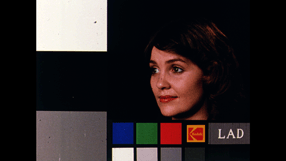
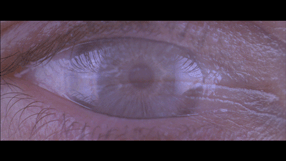
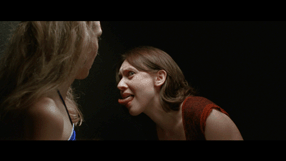
DCP Interop 2K flat 24p
Audio 5.1 (48kHz / 24 bits)
VO-ANG / No subtitles
Duration: 100 minutes
An exhibition by / Une exposition de
Mathieu Copeland
Dramaturg/Dramaturge
Tim Etchells
Original scores enacted by/Partitions originales interprétées par
Nada Gambier, Wendy Houstoun and/et Jerry Killick
With/avec Lucy McCormick and/et Jennifer Pick
Under the direction of/Sous la direction de
Tim Etchells and/et Mathieu Copeland
Editor/Chef Monteuse
Pascale Alibert
Sound Design & Mix
Philippe Ciompi
Director of Photography/Directeur de la Photographie
Tom Wright
Focus Puller/1er assistant caméraman
Chris Connatty
2nd Assistant Cameraman/2ème assistant caméraman
David Geli
Sound Recording/Preneur de son
Jack Sandham
Light Technician/Technicien lumière
Ben Moon
Hair and Make up Artist/Maquilleuse et coiffeuse
Paula Recabarren
Runner/Assistant de plateau
Daniel Montanarini
Filmed on location at the Institute of Contemporary Arts, London (ICA)/Film tourné à l’Institut d’Art Contemporain de Londres (ICA)
Graphic Design/Charte graphique
Nicolas Eigenheer & Jeremy Schorderet
A Production Of / Une Production
Head – Genève
With The Support Of The / Avec Le Soutien
Du Fonds Strategique De La Hes-So
Phill Niblock: Working For a Title
25.11. – 25.1.2016
Dům pánů z Kunštátu
Dominikánská 9, Brno
Otevřeno: út – ne 10 – 18 h
Vernisáž: 25.11.2015
Kurátor: Mathieu Copeland
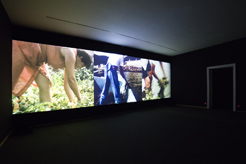
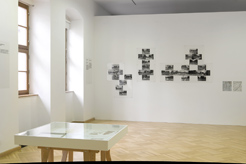
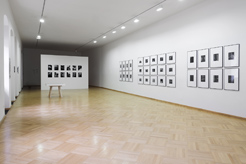
Tvorba Philla Niblocka je multidisciplinární a už více než 50 let se pohybuje v oblasti „intermediálního umění“. Autor kombinuje minimalistickou hudbu, konceptuální umění, strukturalistický film, systémové či politické umění a snaží se tak transformovat naše vnímání a prožívání času.
Ačkoli je Phill Niblock uznávaný jako jeden z nejvýznamnějších experimentálních skladatelů naší doby, započal svoji uměleckou dráhu jako fotograf. Narodil se v roce 1933 v Andersonu (Indiana), ale jako vášnivý jazzový fanoušek se v roce 1958 usadil v New Yorku. Fotografovat začal od roku 1960 a po celé čtyři roky se věnoval portrétům jazzových hudebníků; často provázel do nahrávacích studií a na koncerty Charlese Minguse, Billyho Strayhorna, Dukea Ellingtona a další. V polovině šedesátých let přechází od fotografie k filmu a na popud choreografky a zakladatelky nadace „Experimental Intermedia“ Elaine Summers začíná filmovat tanečníky a choreografy v divadle Judson Church Theater: patří k nim Yvonne Rainer, Meredith Monk, Lucinda Childs a další. Od roku 1968 se Phill Niblock zaměřuje na hudbu a skládá své první kompozice, které – jak zdůrazňuje sám autor – se musí poslouchat velice nahlas, aby náležitě vyzněly jejich superharmonie (overtones). Souběžně pokračuje i ve své filmové tvorbě, k níž patří i jeho monumentální dílo The Movement of People Working (Pohyb pracujících lidí), filmový cyklus o celkové délce přesahující 25 hodin realizovaný v letech 1973–1991; opakující se charakter pohybů při práci zde působí jako přímá ozvěna jeho minimalistických hudebních kompozic.
Analogové fotografie Philla Niblocka se už od poloviny šedesátých let zabývají architekturou a urbanismem New Yorku. Řazení a kompozice jeho záběrů mapují fotografovaná místa a objekty, ať už se jedná o opuštěné budovy na ostrově Welfare Island (dnes Roosevelt Island) z roku 1966, vybydlené oblasti v jižním Bronxu (1979) nebo fasády ve čtvrti SoHo Broadway (1988). Od roku 1966 se Niblock zabývá myšlenkou projekce pohyblivých obrazů prostřednictvím série filmů a sekvence diapozitivů. Úvodní počin tohoto experimentálního postupu tvoří Šest filmů, cyklus krátkých zvukových filmů natočených na šestnáctimilimetrový materiál v letech 1966 až 1969 a přinášejících portréty umělců a hudebníků, například Sun Ra či Max Neuhaus. Jeho zaujetí lidskou individualitou a její oslava tvoří jádro cyklu videofilmů nazvaného Anecdotes from Childhood (Příběhy z dětství). Vznikl v letech 1985 až 1992 a zabývá se fenoménem paměti a vyjádřením osobní historie prostřednictvím intimních portrétů.
Již v roce 1968 začíná autor experimentovat s kombinováním svých vizuálních děl a hudebních partitur a vytváří architektonické a environmentální zvukové kompozice. Cyklus Environments (Prostředí), který zde autor rekonstruoval poprvé od dosud poslední prezentace v roce 1972, extrahuje pomocí obrazů realitu několika různých prostředí a zároveň generuje ve výstavním prostoru hutnou a intenzivní dočasnou situaci promítaných obrazů, hudby a pohybu.
Filmový cyklus Pohyb pracujících lidí, který představuje lidskou práci v její nejzákladnější podobě, se zde poprvé promítá vcelku a autor jej pro svoji retrospektivu nově sestříhal a remasteroval. Byl natočen na šestnáctimilimetrový barevný film a později na video na takových místech jako Peru, Mexiko, Maďarsko, Hong-Kong, Arktida, Brazílie, Lesotho, Portugalsko, Sumatra, Čína a Japonsko. Celkové množství natočeného materiálu přesahuje 25 hodin a zaměřuje se na práci jako na choreografii pohybů a gest, vzdávajících hold mechanickému, avšak zcela přirozenému opakování počínání pracujících. Phill Niblock o tomto díle říká, že „Pohyb pracujících lidí vznikl z nutnosti, protože moje hudební představení doprovázeli živí tanečníci, ale bylo příliš obtížné a nákladné pořádat turné s tolika lidmi. Tak jsem začal natáčet filmy, které bych mohl při své produkci promítat.“
Filmy doprovází pomalu se rozvíjející, harmonicky minimalistické hudební dílo Philla Niblocka, vytvořené v letech 1968 až 2011. Hlasitost provedení těchto kompozic a jejich táhlých souzvuků – drónů – nabízí niterný prožitek, oživený jiskřivými, pulzujícími harmoniemi. Partitury, představené na výstavě ve formě fotokopií vytvořených pro autorovu výstavu v londýnské galerii ICA v roce 1982, zaznamenávají pokyny skladatele pro mixování hudby. Hudebník s nimi během představení nepracuje, hraje si s nahrávkami, pohybuje se po prostoru, někdy vytváří souzvuk s tonalitou nahrávky, jindy naopak vznikají disonance. Výsledkem je neustálý tepající, rytmický a pulzující pohyb v neustále se proměňujících harmoniích během jeho vlastního pohybu v prostoru. Vrstvení tónů jakoby bylo ozvěnou opakovaného konání pracujících; odvíjení filmů na každé obrazovce (které se v průběhu dne mění) v kombinaci s programem, který náhodně přehrává různé hudební skladby, v důsledku vytváří neustále se obnovující formy, nabízející stále nové juxtapozice zvuku a obrazu.
Pohyb pracujících lidí představuje silné společenské a politické sdělení, zdůrazněné samotným názvem a prezentované bezprostřední blízkostí pracujících. V tomto smyslu evokuje filmový cyklus práci některých dalších filmařů, jako byli Jean Luc Godard nebo Chris Marker, kteří již v roce 1967 dali dělníkům kamery a poučili je o základních filmařských technikách, aby si mohli natáčet své vlastní filmy. Fascinujícím zvratem událostí došlo k tomu, že několik dělníků začalo zakládat skupiny Medvekine a rozhodli se filmovat sami sebe při práci, spíše než by vytvářeli hrané nebo čistě dokumentární filmy.
Výstava vznikla ve spolupráci dvou muzeí – Musée de l’Elysée a centra současného umění Circuit de Lausanne.
Výstavě předchází mimořádný koncert Philla Niblocka v brněnské Hvězdárně, v pondělí 23. 11. v 19 h. Ve strhujícím audiovizuálním představení věhlasný americký intermediální tvůrce Phill Niblock promítá na kopuli planetária dlouhé sekvence z filmového cyklu „Pohyby pracujících lidí“ v doprovodu vlastní elektronické hudby. Minimalistická, nezúčastněná choreografie pohybů a gest filmovaných aktérů, provádějících monotónní pracovní úkony, generuje v kombinaci s hlasitou a rozvláčnou hudbou komplexní synestetický zážitek na hranici transu. Nenechte si ujít mimořádný příspěvek k dějinám moderního kinematografického umění.
A PERSONAL SONIC GEOLOGY
13.05–26.07.15
Vernissage mardi 12.05, 18h-21h
Avec Boyle Family, une carte mentale, la chute d’eau, un désert, FM Einheit, une exposition, un événement, la fabrique de peinture, Ellen Fullman, Gilles Furtwängler, une grotte, Marcia Hafif, Peter Halley, Fritz Hauser, l’imprimerie, Tom Johnson, Ulrich Krieger, Alan Licht, Lydia Lunch, John M Armleder, Agathe Max, Gustav Metzger, l’usine de tissage.
Une exposition de Philippe Decrauzat et Mathieu Copeland
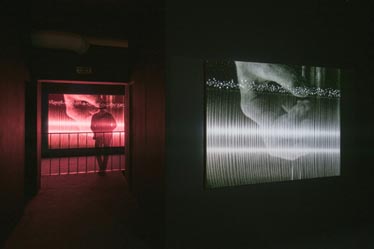
A Personal Sonic Geology regroupe l’ensemble des films coréalisés par Mathieu Copeland et Philippe Decrauzat depuis 2012. Nés du désir de filmer le son, d’enregistrer des lieux et de plonger dans la matière des processus de fabrication et de destruction, ces films sont présentés selon un mode de projection intégrant l’exposition de peintures écrans monochromes.
Invités à réaliser une programmation d’événements et d’expositions au plateau depuis mars 2014, Mathieu Copeland et Philippe Decrauzat ont à chaque fois utilisé ces espaces et ce temps pour faire intervenir des artistes du champ plastique ou musical – à travers le format de l’exposition ou celui, plus dense, de l’événement – et les filmer, avec comme finalité de poursuivre leur collaboration filmique pour donner à voir et à entendre sous la forme d’un dispositif immersif, ce qui aura déjà été vu, entendu et vécu.
Instaurant ainsi un dialogue entre image filmique, peinture et production sonore, les films, réalisés en relation avec une constellation d’artistes, mettent en oeuvre les procédés de surimpression et de fragmentation de l’image au moyen de la pellicule 16 mm. Qu’il s’agisse de filmer des musiciens, tels Alan Licht, Ellen Fullman ou FM Einheit alors qu’ils réalisent la bande-son des films à venir, d’instaurer un dialogue oeuvre-caméra avec les dessins de Marcia Hafif ou avec un tableau de Peter Halley, de filmer des moments ou des lieux de création – la réalisation d’une peinture de John M Armleder, la recréation d’une action/démonstration de Gustav Metzger ou la grotte de l’artiste et « chercheuse » suisse Emma Kunz – ou encore des lieux de production comme une imprimerie à Marrakech, une usine de filature textile ou une fabrique de peintures, les composantes de ces films forment ici un assemblage linéaire de réalités superposées.
Ce programme a fait l’objet d’une série de manifestes rédigés par des artistes invités, conférant à chaque manifestation – exposition ou événement – son titre et reliant ainsi tous les éléments du projet, tels des maillons d’un même vaste ensemble nous proposant une relecture d’une histoire de la modernité par le biais des arts visuels et de la musique.
* Manifeste de Susan Stenger
rendez-vous
Live Evil
13.06.15 – 19h
Live de Max Turner (Agathe Max et Gareth Turner)
Violon et contrebasse amplifiés
Max Turner, égrégore et voyageur spatio-temporel, navigue entre Lyon et Bristol avec pour seul bagage sa contrebasse et son violon électriques. Le drone qu’il diffuse en souffle continu se répand dans les éléments et les êtres afin de faire apparaître en chacun des forces telluriques, des fleuves de métal fondu comme autant de veines incandescentes. Les cordes amplifiées ouvrent une faille dans laquelle les coeurs se lovent, surpris par la paradoxale force fragile qui s’en dégage. La magie de l’électricité agît sur la contrebasse et sur le violon, instruments ancestraux et pourtant rendus ainsi si contemporains. Max Turner aime le débat et ne rentre en aucun cas dans des conventions figées, des théories absurdes sur ce que devrait être ou ce qu’est la musique ou XXIème siècle, puisque, chercheur, il ne cesse d’expérimenter et dans son laboratoire de sons, une fine distillation s’opère, révélant plus qu’un élixir une expérience sonique unique.
Visite commissaires avec Mathieu Copeland et Philippe Decrauzat
Dimanche 28 juin – 17h30
Conversations de plateau
Mercredi 8.07.15 – 19h30
Des invités interviennent sur les questions du son, du cinéma et du manifeste, autant de maillons constituant l’exposition. Ils échangent et livrent leurs regards sur celle-ci.
Avec Nicolas Couturier (graphiste, collectif g.u.i.), Maxime Guitton (programmateur et commissaire d’exposition) et Jonathan Pouthier (programmateur cinéma).
--
A PERSONAL SONIC GEOLOGY
13.05–26.07.15
With Boyle Family, a mental map, a waterfall, a desert, FM Einheit, an exhibition, an event, a factory paint, Ellen Fullman, Gilles Furtwängler, a cave, Marcia Hafif, Peter Halley, Fritz Hauser, a printery, Tom Johnson, Ulrich Krieger, Alan Licht, Lydia Lunch, John M Armleder, Agathe Max, Gustav Metzger, a spinning mill.
An exhibition by Philippe Decrauzat and Mathieu Copeland
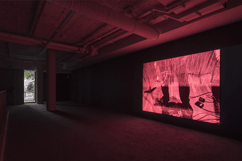
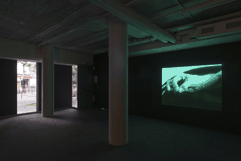
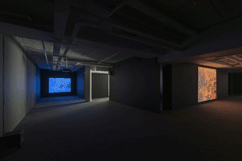
A Personal Sonic Geology gathers together the films realised by Mathieu Copeland and Philippe Decrauzat since 2012. Stemming from a desire to film sound, record places, and dive into the process of a material construction and destruction, these films are screened using a projection apparatus that integrates an exhibition of monochrome screens/paintings.
Invited to create a programme and events and exhibitions at le Plateau from march 2014 on, Mathieu Copeland and Philippe Decrauzat have each time used these spaces and this time to involve artists from the visual and music fields—using the exhibition format, or he denser format of the event—and film, their end purpose being to pursue their film collaboration to present to the eye and ear, in the form of an immersive arrangement, something that has already been seen, heard and experienced.
Creating a dialogue between filmed images, painting and
sound production, these films bring together a constellation of artists, superimposing and fragmentating the 16 mm film stock. Filming musicians including Alan Licht, Ellen Fullman or FM Einheit as they realise the soundtrack for these films to be, creating a dialogue between works of art and the camera, with Marcia Hafif’s drawings or a painting by Peter Halley, filming moments and places of creation such as the realisation of a painting by John M Armleder, the re-enactment of a lecture-demonstration by Gustav Metzger, Swiss artist and “researcher” Emma Kunz’s Grotto, and production sites including a printing press in Marrakech, a textile manufacture or a paint factory, the film’s components shape a linear assemblage of overlaid realities.
This programme has been the subject of a series of manifestos drawn up guests artists, lending each exhibition and event its title and thus connecting all the elements of the project, like links in one and the same huge enselmbe, offering us a re-reading of a history of modernity seen through visual arts and music.
*Susan Stenger manifesto.
WAYWORDS OF SEEING
12.06–27.07.14
Vernissage mercredi 11.06, 18h-21h
Avec Francis Baudevin, Boyle Family, David Cunningham, FM Einheit, Morgan Fisher, Marcia Hafif, David Hominal, Steven Parrino, Stephen Partridge, Martin Rev, Karin Sander, Amikam Toren, Dan Walsh
Une exposition organisée par Philippe Decrauzat et Mathieu Copeland
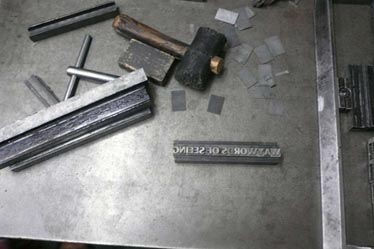
Empruntant son nom à un titre manifeste de Dan Walsh, l’exposition Waywords of Seeing envisage le point de vue, le regard, le champ et le hors-champ au travers du prisme de la dérive des mots**.
S’y déploient des trajectoires aux arborescences multiples : cartographier et exposer un réel fragmenté au hasard, penser des transcriptions visuelles d’univers sonores et électriques, proposer une archéologie d’images et de situations reconstituées et transformées.
L’exposition Waywords of Seeing dessine des espaces en négatif qui se découvrent à travers des « véhicules » réalisés par Dan Walsh pour chaque espace et offre une investigation du champ de la perception, en explorant la distance entre l’œuvre et celui qui la regarde, comme autant de points de vue de et sur l’exposition.
Une mise en abîme de la vision par une démultiplication d’expériences, replaçant le corps dans sa relation à l’image à un niveau scientifique, psychologique et narratif.
Waywords of Seeing interroge et conditionne le regard via une succession de filtres, dessinant ainsi des expositions dans l’exposition.
* *Le titre du manifeste de Dan Walsh intègre un jeu de mots – voire un jeu de lettres – en partant de « waywards » qui signifie « errance, dérive, égarement ».
--
WAYWORDS OF SEEING
12.06–27.07.14
Opening Wednesday 11 June, from 6 to 9 pm
With Francis Baudevin, Boyle Family, David Cunningham, FM Einheit, Morgan Fisher, Marcia Hafif, David Hominal, Steven Parrino, Stephen Partridge, Martin Rev, Karin Sander, Amikam Toren, Dan Walsh
An exhibition curated by Philippe Decrauzat and Mathieu Copeland.
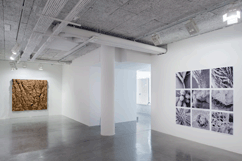
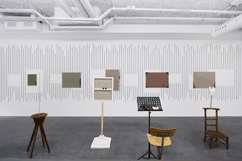
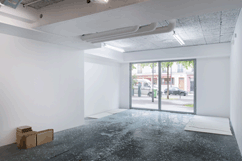
Taking its name from a title-statement by Dan Walsh, Waywords of Seeing considers the viewer’s gaze – in and out of the field of perception – through a prism of drifting words: the random mapping of places, the visual transcription of a sonic and electric realm, the archaeology of images and circumstances which have been reconstituted and transformed.
Waywords of Seeing creates negative space to be discovered through the “vehicles” conceived by Dan Walsh: they offer an investigation of the field of perception through the exploration of the distance separating the work of art and the viewer – creating in the process a multitude of points of view of and about the exhibition.
A multiplication of vision through different experiences repositions the body in relation to its image on scientific, psychological and narrative levels. Waywords of Seeing both questions and conditions the gaze via a succession of filters, ultimately forming exhibitions within the exhibition.
Une exposition – un événement
Suite pour exposition(s) et publication(s),
quatrième mouvement.
Avec Mac Adams, Art & Language, Fia Backström, Robert Barry, Julien Bismuth, Claude Closky, Peter Downsbrough, Liam Gillick, Pratchaya Phinthong, Georgia Sagri, Betty Tompkins, Oriol Vilanova, Cally Spooner, et une publication de Genesis Breyer P Orridge.
Une exposition de Mathieu Copeland
Du 15 octobre 2013 au 26 janvier 2014
Dans le cadre de la programmation Satellite, "Suite pour exposition(s) et publication(s)" s’offre, en quatre mouvements, comme une réflexion sur l’exposition, son image, sa représentation ainsi que son catalogue. Sous le titre "Une exposition – des projections", le quatrième mouvement interroge l’exposition à travers la notion de projection, entendue ici dans une large acception – orale, mentale, cinématographique –, qu’il s’agisse de la projection du mot par la lecture du catalogue d’une exposition passée (entresol et niveau –1) ou de la projection du texte avec un film à être lu (auditorium).
Une reprise
Reprise / re-pri-z’ / n. & v. : n. 1. Passage répété dans un morceau de musique. 2. Article repris dans un programme musical. v. tr. répétition (performance, chanson, etc.) ; nouvelle présentation (théâtre, film), réécriture. [Français, fém. participe passé de reprendre]
Une exposition, une fois qu’elle a achevé son cours, se cristallise dans les productions qu’elle a engendrées, dans le souvenir de ceux qui en ont fait l’expérience, mais aussi dans son catalogue, qui met généralement à disposition le détail des travaux qu’elle a présentés. Le catalogue d’une exposition "reproduit" les images des objets qui ont contribué à la faire exister et / ou des vues de celle-ci. Ainsi, il en est, au mieux, la mémoire ; au pire, il n’en est que la check-list.
Cette "reprise" de l’exposition "Art & Language", qui s’est tenue au Jeu de Paume du 9 novembre 1993 au 2 janvier 1994, s’offre comme le désir de revisiter la mémoire de cet événement autant que de lui conférer une nouvelle réalité. Sans qu’aucune œuvre ne soit montrée, la manifestation passée est envisagée de nouveau à travers la lecture de son catalogue, utilisé comme une partition. Diffusé dans les salles, l’enregistrement sonore (exécuté par Jonathan Reig) de l’ensemble de l’ouvrage – lu en français par Olivier Claverie et en anglais par Kate Lith – permet une compréhension nouvelle de cette exposition et de son rapport au texte. Cependant, il ne restitue qu’un écho lointain de l’original, affirmant l’exposition comme un matériau en continuelle expansion qui, en tant que tel, peut être repris des semaines, des mois ou des années plus tard, et dans des contextes différents. Au travers de cette (re)lecture "projetée", qui constitue un nouvel événement en soi, le catalogue devient ainsi le libretto d’une exposition en constant devenir.
En parallèle, la publication du recueil de poèmes intitulé Life as a Cheap Suitcase, carte blanche offerte à Genesis Breyer P-Orridge, figure pionnière de la musique industrielle, dépasse la conception du catalogue comme simple représentation de l’exposition par le livre. Parce qu’il donne le sentiment de l’exposition, cet ouvrage, somme toute, en est le miroir et la continuité.
Un film à être lu
Dans l’auditorium, est projetée de manière continue une exposition du mot à travers un "film à être lu", constitué d’un enchaînement de textes d’artistes écrits spécifiquement pour ce dernier.
La description du sentiment d’une oeuvre par Robert Barry, un script de mots de femmes par Betty Tompkins, un secret partagé de Pratchaya Phinthong, un film noir de Mac Adams, une phrase en attente de Liam Gillick, une prédiction du temps par Oriol Vilanova, une poésie informatique abstraite de Claude Closky, un voyage mental avec Georgia Sagri, l’utilisation du texte par Julien Bismuth dans le but de faire "apparaître" des images, une polyphonie de Cally Spooner ou, encore, la transformation de la salle noire du cinéma en un théâtre intérieur par Fia Backström – toutes ces œuvres sont articulées entre elles par des transitions réalisées par Peter Downsbrough. Unifiés par la typographie, les textes forment autant les sous-titres d’un film sans images que des projections mentales qui se construisent dans l’esprit de celui qui les lit.
--
Exhibitions—A Projection
Suite for Exhibition(s) and Publication(s),
fourth movement.
With Mac Adams, Art & Language, Fia Backström, Robert Barry, Julien Bismuth, Claude Closky, Peter Downsbrough, Liam Gillick, Pratchaya Phinthong, Georgia Sagri, Betty Tompkins, Oriol Vilanova, Cally Spooner, and a publication by Genesis Breyer P Orridge.
An exhibition by Mathieu Copeland
from 15 october 2013 until 26 january 2014
For the sixth edition of its Satellite programme, the Jeu de Paume has invited curator Mathieu Copeland. Conceived as part of the “Suite for Exhibition(s) and Publication(s),” “An exhibition – An Event” will be presented at the Jeu de Paume from 28 May to 1 September 2013. It will echo the two movements “A Spoken Word Exhibition” and “An Exhibition Without Texts,” which were presented respectively at the Jeu de Paume and the Maison d’Art Bernard Anthonioz. This exhibition examines the moment when the image becomes an abstraction of itself until it disappears in favor of the event. The event should be envisaged in its widest sense: a musical score of an event, a suggested reading, or an action that takes place in the ancillary spaces allocated to the Satellite program. Mathieu Copeland’s proposal explores what happens in neutral contexts and how a formal presence is activated in them.
A Reprise
Reprise /ri’pri:z/ n. & v. : n. 1. A repeated passage in music. 2. A repeated item in a musical programme. v. tr. repeat (a performance, song, etc.); restage, rewrite. [French, fem. past part. of reprendre]
An exhibition, once it has run its course, crystallizes into the products that it generated, in the recollection of those who experienced it, and also in its catalogue, which generally provides details about the works on display. The exhibition catalogue “reproduces” images of the objects that contributed to its existence and/or views of it. It is thus, at best, a memory of it; at worst, it is nothing more than a checklist of it.
This “reprise” of the “Art & Language” exhibition, which took place at the Jeu de Paume between November 9, 1993 and January 2, 1994, reflects as much a desire to revisit the memory of this event as a desire to give it a new reality. Without any works even being shown, the past event is envisaged anew through a reading of its catalogue, which is used as a score. Broadcast in the rooms, the sound recording (engineered by Jonathan Reig) of the entire book—read in French by Olivier Claverie and in English by Kate Lith—permits a new understanding of this exhibition and its relation to the text. However, it restores only a distant echo of the original, affirming the exhibition as constantly expanding material which, as such, can be reprised weeks, months or even years later, in various contexts. Through this “projected” (re)reading, which constitutes a new event in itself, the catalogue thus becomes the libretto of an exhibition that is constantly in becoming.
In parallel, the publication of the collection of poems Life as a Cheap Suitcase, for which Genesis Breyer P-Orridge, a pioneer of industrial music, was given carte blanche, goes beyond the concept of the catalogue as a representation of the exhibition in book form. This publication, to the extent that it conveys the feeling of it, is ultimately both a mirror and a continuation of the exhibition.
A Film to Be Read
In the auditorium, an exhibition of the words is projected continuously in the form of a “film to be read,” consisting of a succession of artists’ texts written specifically for it.
The description of the feeling of a work by Robert Barry, a script of women’s words by Betty Tompkins, a shared secret by Pratchaya Phinthong, a film noir by Mac Adams, a suspended sentence by Liam Gillick, a prediction of time by Oriol Vilanova, an abstract computer poem by Claude Closky, a mental journey with Georgia Sagri, the use of text by Julien Bismuth to make images “appear,” a polyphony by Cally Spooner and the transformation of the dark room of the cinema into an internal theatre by Fia Backström— all these works are intertwined in a string of words created by Peter Downsbrough. Unified by their typography, the texts are both the subtitles of a film without images and mental projections constructed in the mind of the person reading them.
Mandala Mental
Con Luigi Amara, Philippe Decrauzat, Myriam Gourfink, y con la participación de F.M. Einheit, Ulrich Krieger, Alan Licht, Gustav Metzger, Robert Poss y Alan Vega.
Un exposición de Mathieu Copeland

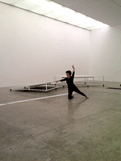
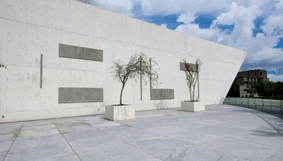
La exposición Mandala Mental, proyecto realizado por Mathieu Copeland, parte de la concepción de que las exhibiciones suceden sobre todo en la mente. Mediante una práctica de curaduría experimental, Copeland busca ahondar acerca de la relación entre las obras de arte y la experiencia del espectador.
Mandala Mental articula tres elementos. Por un lado, una película es proyectada sobre pinturas negras de gran formato realizadas por el artista suizo Philippe Decrauzat. El film retrata a músicos (F.M. Einheit, Ulrich Krieger, Alan Licht, Alan Vega y Robert Poss) produciendo la banda sonora, intercalados con paisajes y acercamientos a cuadros de nylon rociados con ácido siguiendo las instrucciones del artista austriaco Gustav Metzger.
Ese montaje en vivo contrasta con la simplicidad de la acción de una coreografía de Myriam Gourfink, ejecutada por Margot Dorléans, que inscribe una línea imaginaria en el espacio. Su partitura es al mismo tiempo las instrucciones para una bailarina, el libreto para el público y la memoria de aquello que está por suceder.
Finalmente, acompaña a la muestra el texto de una exposición imaginaria concebida por el escritor Luigi Amara. Queriendo cuestionar el rol de las exhibiciones y obras de arte, Mathieu Copeland aspira a que esos elementos construyan una exposición como una situación que sólo es posible en tanto alguien, un sujeto, la complete con su presencia.
--
A Mental Mandala
With Luigi Amara, Philippe Decrauzat, Myriam Gourfink, and featuring F.M. Einheit, Ulrich Krieger, Alan Licht, Gustav Metzger, Robert Poss and Alan Vega.
An Exhibition by Mathieu Copeland
A Mental Mandala comprises three main elements – an exhibition of paintings and projected films & music, a choreography that defines through time space itself, and a text that contextualise a dramaturgy for yet another possible exhibition.
An exhibition of raw, white and blacks paintings taking the shape of a film-still gradually fragmented are disseminated throughout the galleries. Inside the gallery, the black monochromes act in turn and alternatively as the screens for the projected films as an exhibition realised together with Swiss artist Philippe Decrauzat. This series focuses on filming a musician as he produces the soundtrack for this film to be. Portraits of musicians F.M. Einheit, Ulrich Krieger, Alan Licht, and Alan Vega are superimposed with a landscape that encompasses views of a textile factory, dunes of the Sahara desert or extreme close up of a nylon canvas smeared with acid as instructed by Gustav Metzger.
In the other gallery, the presence of the body through time unveils a slow inscription in space as a dancer works an imaginary line. A score written by French choreographer Myriam Gourfink for one dancer, Margot Dorléans, choreograph a walk whose duration is that of an exhibition. Ultimately, this score is both the instructions for the dancer, the libretto for the public, the memory of what had happen, and for what is about it to happen.
The sensitive articulation in time and space of the exhibition ultimately takes the form of a text. This writing act as a dramaturgy to what is present, taking an exhibition and the presentation of artefacts as the means to generate a new narrative, reframing what is to be seen in the mind of the one who reads. A possible comprehension of the mandala – the ephemeral, and the mind – the immaterial, offers the sensitive mental experience of an exhibition that looks at one. A Mental Mandala is a choreographed exhibition whose sole reality exists within the minds of the ones who complements it all.
Une exposition – un événement
Suite pour exposition(s) et publication(s),
troisième mouvement.
Avec Mieko Shiomi, Maria Eichhorn et Tim Etchells, et une publication de Douglas Coupland.
Une exposition de Mathieu Copeland
Du 28 Mai au 01 Septembre 2013
.gif)
.gif)
.gif)
Dans le cadre de la programmation Satellite, « Suite pour exposition(s) et publication(s) » s’offre, en quatre mouvements, comme une réflexion sur l’exposition, son image, sa représentation ainsi que son catalogue. Sous le titre « Une exposition – un événement », le troisième mouvement envisage ce moment où l’œuvre fait abstraction d’elle-même pour se jouer du spectacle de l’exposition, que ce soit au travers d’actions morcelées dans l’espace et dans le temps, d’invitations à imaginer un événement par le texte ou encore d’interventions et gestes infimes, réalisés notamment au sein d’espaces interstitiels. L’événement, considéré ici dans son acception la plus large et selon une approche fragmentaire et déceptive, consacre ainsi le non-événement.
Entre 1965 et 1975, l’artiste Fluxus Mieko Shiomi (née en 1938, vivant à Osaka) orchestre une suite de neuf Spatial Poems (« Poèmes spatiaux ») articulés autour de micro-actions effectuées parallèlement, aux quatre coins du globe, par différents performers, jouant de la fragmentation de l’événement en différents lieux et instants. L’invitation adressée aux participants fonctionne comme la partition de l’événement par le biais d’instructions elles que rapporter la direction de ses déplacements à un moment déterminé ou enregistrer la chute provoquée d’un objet. Les comptes rendus établis par Shiomi exploitent autant le texte pour son caractère narratif que pour ses effets graphiques et spatiaux : Spatial Poem No. 2: A Fluxatlas (1966) recense et commente, sur une carte géographique, la position de chacun des intervenants à une heure donnée ; Spatial Poem No.3: A Fluxcalender (1968) constitue un calendrier de toutes les performances menées sur la durée de l’événement. Dans le même registre que les poèmes spatiaux, Events & Games (1965) contient une série de cartes appelant à réaliser des interventions subtiles et minimales dans l’environnement (par exemple, tourner en rythme autour d’une flaque d’eau tout en la regardant). La lecture de ces invitations aujourd’hui s’offre en écho à ces actions passées, dans un dialogue sans cesse renouvelé.
À l’occasion de l’exposition, le dramaturge et chorégraphe britannique Tim Etchells (né en 1962, vivant à Sheffield), cofondateur du collectif Forced Entertainment, interroge la manière dont la lecture peut générer un événement. Invitations à susciter des performances par le seul biais du texte, ses Fight Posters (« Affiches de combats », 2012) annoncent une série absurde de combats imaginaires, soulignant conflits sociaux et politiques non résolus ou rivalités médiatiques stéréotypées. Live Forever (« Vivre pour toujours », 2013), sculpture de glaçons formée des onze lettres de son propre titre, explore la relation entre le texte comme espace sémiotique et objet matériel : ce qui est énoncé en toutes lettres ne peut se réaliser, la fonte des mots s’opérant progressivement au fil des jours. Le dessin mural Let Go (« Lâcher prise », 2013) répète trois mots simples sous la forme d’une séquence évolutive et changeante de plusieurs lignes, comme si leur auteur s’exerçait à faire une déclaration. La dernière ligne, LET IT GO, vient démentir le travail accumulatif demandé par l’énonciation textuelle de l’œuvre. Let Go explore les aspects contradictoires du langage : la vitesse, la clarté et la vivacité avec lesquelles celui-ci transmet un récit, une image et des idées et, en même temps, sa propension à créer confusion, incertitude et tension.
Maria Eichhorn (née en 1962, vivant à Berlin) se saisit de l’institution comme d’un médium en tant que tel, s’immisçant dans ses interstices, contournant ses contraintes administratives et budgétaires pour sonder, altérer et subvertir sa logique et son mode de fonctionnement. Ici, elle met à mal le statut événementiel de l’exposition par le biais de deux nouvelles pièces susceptibles de demeurer invisibles. Peinture de l’adresse du Jeu de Paume, en blanc sur blanc et en léger relief, sur un pan de mur du hall d’entrée, 1 place de la Concorde, 75008 Paris (2013) est à peine perceptible, exigeant une certaine proximité pour devenir lisible. Avec Entrée gratuite (2013), l’artiste utilise les fonds de production qui lui sont alloués par l’institution pour programmer la distribution sporadique et aléatoire d’un nombre restreint de billets offrant au public la gratuité à l’ensemble des manifestations en cours. Ainsi, Eichhorn souligne la fragilité du moment où l’événement a lieu pour questionner la visibilité même de l’œuvre et, par là même, de l’exposition.
À travers le prisme de l’exposition comme événement s’offrent à la fois une compréhension, une critique et une célébration de l’institution. Etsi le format d’une exposition peut être envisagé en termes de temps et d’espace, il s’agit toujours d’un matériau à construire et à fragmenter.
--
An Exhibition – An Event
Suite for exhibition(s) and publication(s),
third movement.
With Mieko Shiomi, Maria Eichhorn and Tim Etchells, And a publication by Douglas Coupland.
An exhibition by Mathieu Copeland
From the 28th of May to the 1st of September 2013
Part of the Satellite programme, “Suite for Exhibition(s) and Publication(s)” is a reflection, in four movements, on the exhibition, its image and its representation, as well as its catalogue. Titled “An exhibition – An Event”, the third movement examines the moment when the artwork becomes an abstraction of itself, playing on the exhibition as spectacle, be it through actions that are scattered in space and time, invitations to imagine an event in text or through minute interventions and actions carried out in the interstitial spaces of the museum. The event, considered here in its widest sense and using a fragmentary, deceptive approach, thus celebrates the non-event.
Between 1965 and 1975, Fluxus artist Mieko Shiomi (born in 1938, lives in Osaka) orchestrated a series of nine Spatial Poems revolving around micro actions carried out in parallel, around the world, by different performers, playing on the fragmentation of the event into different places and instants. The invitation issued to participants functioned like the score of the event by means of instructions, such as reporting the direction of one’s movements at a specific moment or recording a falling object. The records kept by Shiomi use the text as much for its narrative capacity, as for as its graphic and spatial effects: Spatial Poem No. 2: A Fluxatlas (1966) located and commented on the positions of all the participants at a specific time on a map; Spatial Poem No. 3: A Fluxcalender (1968) featured a calendar of all the performances carried out during the event. In a similar vein to the spatial poems, Events & Games (1965) contained a series of cards with instructions for carrying out subtle, minimal actions in the environment (for example, moving rhythmically around a puddle while looking at it). Reading these invitations today provides an echo of these past actions, generating a dialogue that is continuously renewed.
For this exhibition, British artist and choreographer Tim Etchells (born in 1962, lives in Sheffield), co-founder of the Forced Entertainment collective, examines the way in which reading can generate an event. The Fight Posters (2012), invitations to performances through text alone, announce an absurd series of imaginary fights that underscore unresolved conflicts in the social and political sphere or replay stereotypical media rivalries. Live Forever (2013), an ice sculpture made up of the eleven letters of its own title, explores the relationship between the text as semiotic space and material object: what is announced cannot take place, with the words gradually melting each day. The wall drawing Let Go (2013) repeats three simple words in the form of a developing and mutating sequence over a number of lines, as if their author might be practising a phrase or an utterance. The last line, LET IT GO, refutes the cumulative work demanded by the enunciation in the work’s text. Let Go explores the contradictory aspects of language: the speed, clarity and vividness with which it communicates narrative, image and ideas, and, at the same time, its propensity for creating confusion, uncertainty and tension.
Maria Eichhorn (born in 1962, lives in Berlin) uses the institution itself as a medium, occupying its interstitial spaces, circumventing its administrative and budgetary constraints in order to probe, alter and subvert its logic and its way of operating. Here Eichhorn calls into question the exhibition’s status as event through two new pieces that are likely to remain invisible. 1 place de la Concorde, 75008 Paris (2013), a painting of the address of the Jeu de Paume, in white on white and in low relief, on one of the walls in the entrance hall, is barely perceptible and is readable only close up. In Entrée gratuite (2013), the artist uses the production budget allocated to her by the institution to arrange for the sporadic, random distribution of a limited number of tickets offering free admission to all the events taking place at the time. Eichhorn thereby emphasises the fragility of the moment when the event takes place in order to question our very perception of the artwork and, in turn, the exhibition itself.
Through the prism of the exhibition as event, an understanding, a critique and a celebration of the institution emerge. And although an exhibition’s format can be envisaged in terms of time and space, it remains a material to construct and fragment.
An Exhibition Happening Everywhere, At All Times, with Everyone
A Lecture by Mathieu Copeland
Wednesday, April 17, 2013, 6:00 p.m.
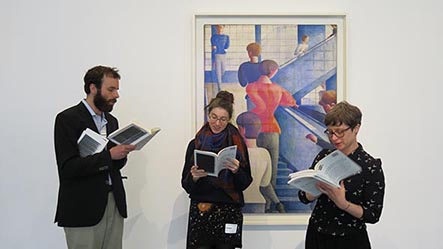
Theater 3 (The Celeste Bartos Theater), mezzanine, The Lewis B. and Dorothy Cullman Education and Research Building
Artists Experiment is a new initiative in the Department of Education that brings together contemporary artists in dialogue with MoMA educators to conceptualize ideas for developing innovative and experimental public interactions.
Curator Mathieu Copeland discusses the poetics of interstitial, neutral and otherwise overlooked off-spaces—and off-times—of museums and galleries. He envisages how they can be activated and seen anew through a variety of perspectives, and thus subvert the traditional role of exhibitions and renew the way they are perceived.
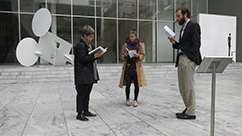

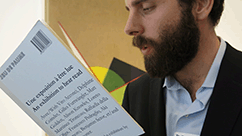
An Exhibition to Hear Read
On April 17, 18 and 19, look out for an exhibition of the words in the interstitial spaces of the museum, an art whose cohesion is not so much spatial, but mental, as Textual artworks written by Vito Acconci, Robert Barry, Delphine Coindet, Keren Cytter, Gilles Furtwängler, Nicolas Garait, Goldin + Senneby, Kenneth Goldsmith, Karl Holmqvist, Bethan Huws, Alison Knowles, Benoît Maire, Loreto Martínez Troncoso, David Medalla, Charlotte Moth, Raffaella della Olga, Francesco Pedraglio, Falke Pisano, Aki Sasamoto, Yann Sérandour, Benjamin Seror, Cally Spooner, Irena Tomain, and Sue Tompkins, are read from the series of Exhibitions to Hear Read curated by Mathieu Copeland by three readers (Ceel Mogami de Haas, Anne Hildbrand and Daphné Roulin, from the Geneva University of Art and Design HEAD—Genève).
Activating the "non-spaces," and offering to Museum visitors the opportunity to experience artworks through the voice, an exhibition to hear read proposes the notion of speech as material gesture, in which both the texture of the word and its spoken quality are inscribed in space and time through the act of reading. The vocal interpretation of these artworks constructs an abstract and ephemeral reality that can be said to sculpt the spaces in which it occurs. This ongoing investigation into the materiality of artwork as a question of word and speech is crystallized through a series of publications that act as both score and memory.
April 17, 5–6 p.m.: Cullman mezzanine, 4 W. 54 Street
April 18, 3–5 p.m.: Bauhaus Lounge, third floor and MoMA Sculpture Garden
April 19, 12:30–1:30 p.m. and 3–4 p.m.: Bauhaus Lounge, third floor and MoMA Sculpture Garden
UNE EXPOSITION SANS TEXTES, Maison d'Art Bernard Anthonioz, Nogent sur Marne - FR, 21/03 - 19/05/2013
Une exposition sans textes
Suite pour exposition(s) et publication(s),
deuxième mouvement.
Satellite 6.
Avec Vito Acconci, Francis Baudevin, Stefan Brüggemann, Delphine Coindet, Gilles Furtwängler, Matt Golden, Idris Khan, Alison Knowles, Loreto Martínez Troncoso, Raffaella della Olga, Francesco Pedraglio, Giandomenico Tonatiuh Pellizzi, Claude Rutault, Aki Sasamoto, Benjamin Seror, Cally Spooner, Amikam Toren, Jacques Villeglé, Gil Joseph Wolman… Et une publication de franck leibovici.
Une exposition de Mathieu Copeland.
Maison d’Art Bernard Anthonioz, Nogent-sur-Marne
du 21 mars au 19 mai 2013
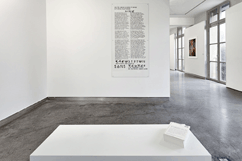
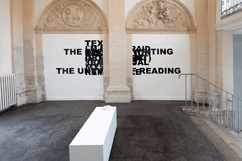
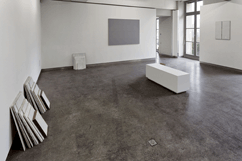
Deuxième mouvement de la suite pour exposition(s) et publication(s) proposée par Mathieu Copeland, « Une exposition sans textes» s’offre en écho direct et simultané a « Une exposition parlée », premier mouvement présente au Jeu de Paume à Paris. Si cette dernière questionne la place du mot et de la lecture dans l’exposition, ce deuxième mouvement en prend le contrepoint pour aborder ce moment où le texte fait image, ou l’écriture (dans sa plus large acception) s’efface, générant ainsi une image abstraite et affirmant la disparition du sens au profit d’une autre lecture.
Une exposition n’est pas l’illustration d’un texte. Tout comme les œuvres qui la compose et sans lesquelles elle ne pourrait être, elle n’appelle pas un paratexte ni ne découle d’un format impose. Sa forme n’est pas prédéfinie en fonction d’une mise en espace pour un temps donne.
Envisageant la superposition et l’accumulation au travers d’œuvres de Stefan Bruggemann, Matt Golden et Idris Khan, l’effacement, la déchirure et une cryptographie du réel, mises en jeu par Jacques Villegle, la re-peinture et l’obstruction chez Francis Baudevin, Giandomenico Tonatiuh Pellizzi, Claude Rutault ou encore l’oblitération et la défiguration avec Amikam Toren et Gil Joseph Wolman, « Une expositions sans textes» s’articule autour de la volonté affirmée d’annuler tout texte ou toute image. Cette approche de l’exposition dans ce qu’elle peut avoir de plus formel insiste sur l’existence de l’œuvre à travers la représentation que l’on s’en fait ou et les mots que l’on projette.
--
An Exhibition Without Texts
Suite for Exhibition(s) and Publication(s),
second movement.
With Vito Acconci, Francis Baudevin, Stefan Brüggemann, Delphine Coindet, Gilles Furtwängler, Matt Golden, Idris Khan, Alison Knowles, Loreto Martínez Troncoso, Raffaella della Olga, Francesco Pedraglio, Giandomenico Tonatiuh Pellizzi, Claude Rutault, Aki Sasamoto, Benjamin Seror, Cally Spooner, Amikam Toren, Jacques Villeglé, Gil Joseph Wolman… And a publication by franck leibovici.
The second movement of the “Suite for Exhibition(s) and Publication(s)” by Mathieu Copeland, “An Exhibition Without Texts” is a direct, simultaneous echo of the first movement, “A Spoken Word Exhibition,” presented at the Jeu de Paume. Whereas the latter questioned the role of words and reading in the exhibition, the second movement provides a counterpoint by addressing the moment when the text becomes image, when writing (in its widest sense) disappears, thereby generating an abstract image and affirming the disappearance of meaning in favour of a different reading.
An exhibition is not the illustration of a text. Like the works that compose it and without which it could not exist, it does not call on a paratext and it does not derive from an imposed format. Its form is neither predetermined nor dictated by a presentational text and by its creation in space at a given time.
Une exposition parlée
Suite pour exposition(s) et publication(s),
premier mouvement.
Satellite 6.
Avec Vito Acconci, Delphine Coindet, Yona Friedman, Gilles Furtwängler, Matt Golden, Kenneth Goldsmith, Idris Khan, Alison Knowles, Loreto Martínez Troncoso, David Medalla, Gustav Metzger, Raffaella della Olga, Francesco Pedraglio, Aki Sasamoto, Benjamin Seror, Cally Spooner... et une publication de Kenneth Goldsmith.
Une exposition de Mathieu Copeland
du 26 février au 12 mai 2013



La première exposition conçue par Mathieu Copeland dans le cadre de la programmation Satellite du Jeu de Paume envisage l’exposition du mot et la diffusion d’une œuvre dans sa globalité par l’oral. Entre écriture et image mentale, lecture et écoute, celle-ci interroge l’unicité de la lecture et de la parole, la place du mot dans l’exposition, la question de l’exposition et du catalogue – ou plutôt de l’exposition du catalogue…
Le texte – lu – permet son interprétation, et en devient ainsi autant sa partition que sa mémoire. "Une exposition à être lue" génère des figures à être dites, l’abstraction du langage permettant à une forme d’être et, naturellement, une fois dite, de se dissoudre. Parallèlement à cette exposition par le livre est présentée une série de "rétrospectives parlées". Gustav Metzger, qui fait de la destruction et de l’impermanence des motifs de son œuvre, David Medalla, au travers de l’éphémère et de l’impromptu, et d’autres sont invités à enregistrer par leur voix une rétrospective idéale de leur œuvre, soit leurs vies. Un engagement dont le motif et la matérialité ne peuvent exister — survivre — que par l’exposition non documentaire d’une œuvre radicale et qui échappe autant que possible à la présentation de la rétrospective classique. Chaque rétrospective n’existe qu’au travers des mots dits par les artistes — par la mémoire de ceux qui ont créé —, générant ainsi l’image mentale d’une exposition du temps (temps d’une œuvre dont la disparition affirme son existence, temps d’une vie passée) dans l’esprit de ceux qui écoutent.
--
A Spoken Word Exhibition
Suite for Exhibition(s) and Publication(s),
first movement.
With Vito Acconci, Delphine Coindet, Yona Friedman, Gilles Furtwängler, Matt Golden, Kenneth Goldsmith, Idris Khan, Alison Knowles, Loreto Martínez Troncoso, David Medalla, Gustav Metzger, Raffaella della Olga, Francesco Pedraglio, Aki Sasamoto, Benjamin Seror, Cally Spooner... and a publication by Kenneth Goldsmith.
An exhibition by Mathieu Copeland.
from 26 February 2013 until 12 May 2013
The first exhibition conceived by Mathieu Copeland as part of the Jeu de Paume’s Satellite program envisages the exhibition of the word and the diffusion of an entire work orally.
Combining writing and mental image, reading and listening, it questions the uniqueness of reading and speech, the place of the word in the exhibition, the question of the exhibition and the catalogue – or rather of the exhibition of the catalogue...
The – read – text makes possible its interpretation, thus becoming its score as well as its memory. “An Exhibition to Hear Read” generates figures to be said, the abstraction of language enabling a form to come into being and, naturally, once uttered, to dissolve. In parallel with this exhibition through the book a series of “spoken retrospectives” is presented. Gustav Metzger, who uses destruction and impermanence as motifs in his work, David Medalla, through the ephemeral and the impromptu, and others are invited to record with their voices an ideal retrospective of their work, or their lives. The motive and materiality of this undertaking can only exist – survive – through the non-documentary exhibition of a radical work, one that avoids as far as is possible the classic presentation of the retrospective. Each retrospective exists only through the words spoken by artists – through the memory of those who have created – thus generating the mental image of an exhibition of time (time of a work whose disappearance affirms its existence, time of a past life) in the minds of those who are listening.
SUPPORTIVE, 1966 - 2011 - auto-creative art by Gustav Metzger
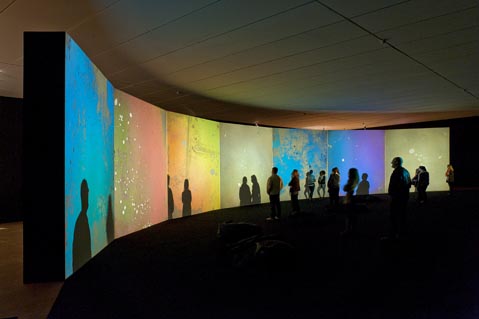
une exposition de Mathieu Copeland au Musée d'art contemporain de Lyon
14.02.2013 – 14.04.2013
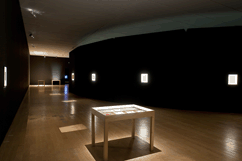
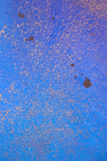
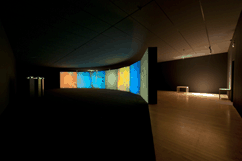
L’art auto-créatif est indissolublement lié à ce qui fut son corollaire, l’art auto-destructif, que Gustav Metzger définit dès novembre 1959 dans son premier manifeste auto-publié. Si son œuvre est souvent envisagé à travers le prisme prépondérant de l'auto-destruction, il nous apparaît aujourd’hui nécessaire de considérer l’envers de toute destruction : l’auto-création.
Metzger associe dès ses débuts le développement d'une pensée théorique et philosophique radicale à une expérimentation artistique constante. Ce sont ces deux dimensions que l'exposition met en œuvre. S'y trouvent réunis pour la première fois, les cinq manifestes « historiques » publiés par l'artiste entre 1959 et 1964, ainsi qu’un ensemble de documents reflétant sa pensée et son engagement pour un art auto-créatif. Gustav Metzger le définit ainsi en 1962 : « Avec cette forme d’art comme avec l’art auto-destructif, le temps, l’espace, le mouvement, la métamorphose et le son jouent un rôle à la fois différent et beaucoup plus important dans la conception, la construction et l’appréciation de l’œuvre […] ». Ces documents inédits sont présentés avec Supportive, 1966-2011, une œuvre récemment acquise par le Musée. Cet environnement monumental fait de cristaux liquides incarne l’auto-création, principe élaboré dès 1959, dans sa plus vaste mise en œuvre réalisée à ce jour.
--
Auto-creative art is inseparably linked to its corollary, auto-destructive art, which Gustav Metzger defined in November 1959 in his first self-published manifesto. His work is mainly considered through the prism of auto-destruction, yet it appears as necessary to now envisage the opposite of destruction, auto-creation.
From the very beginning, Metzger combined the development of theoretical thought and radical philosophy with constant artistic experiment. These two dimensions are the core of the exhibition, which, for the first time, brings together the five “historic” manifestoes published by the artist between 1959 and 1964, as well as a set of documents reflecting his ideas and his commitment to auto-creative art, which he described as follows in 1962: “In this art form, as in Auto-Destructive Art, time, space, motion, metamorphosis and sound have a different far more important role in the conception, construction and appreciation of the work […].” Never previously exhibited, these documents are presented alongside Supportive, 1966-2011, a work recently acquired by the Museum. This monumental environment made of liquid crystals is the embodiment of auto-creation, as it was elaborated by Metzger from 1959 onwards. It is the most immersive implementation of these principles to date.
NOTHIN' BUT WORKING - Phill Niblock, une retrospective ; Circuit & Musee de l'Elysee de Lausanne - CH, 30/01 - 12/05 2013
NOTHIN' BUT WORKING - Phill Niblock, une retrospective
30.01.2013 – 14.05.2013
Nothin’ but Working
Phill Niblock, une rétrospective
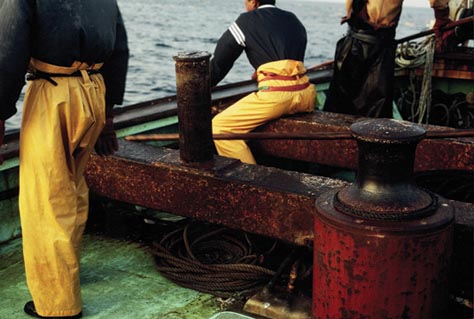
une exposition de Mathieu Copeland présentée conjointement à Circuit, centre d’art contemporain et au Musée de l’Elysée
Né en 1933, Phill Niblock propose depuis plus de 50 ans au travers d’un « Art Intermedia » une oeuvre pluridisciplinaire. Associant musique minimaliste, art conceptuel, cinéma structurel, art systématique ou encore politique, Niblock s’active à transformer notre perception et notre expérience du temps.
Sur une proposition de Circuit, les photographies, films, installations et l’intégralité de sa musique enregistrée sont réunis au sein de cette première exposition rétrospective consacrée à l’entier de l’oeuvre de Phill Niblock. Cette exposition de Mathieu Copeland est présentée conjointement à Circuit, centre d’art contemporain et au Musée de l’Elysée à Lausanne.
Reconnu comme l’un des grands compositeurs expérimentaux de notre époque, Phill Niblock débute sa carrière artistique comme photographe. Originaire d’Indianapolis, passionné de jazz, il s’installe à New York en 1958. Niblock débute la photographie en 1960 et pendant quatre ans se spécialise dans les portraits des musiciens de jazz tels que Charles Mingus, Billy Strayhorn et Duke Ellington, qu’il accompagne fréquemment en enregistrement et en concert. Au milieu des années 1960, il passe de la photographie au film et, au contact de la chorégraphe et fondatrice d’Experimental Intermedia, Elaine Summers, devient caméraman pour les danseurs et chorégraphes du Judson Church Theater, dont Yvonne Rainer et Meredith Monk. À partir de 1968, Niblock se consacre à la musique et compose ses premières pièces qui doivent — comme le précise l’artiste — être écoutées à fort volume pour en explorer les surharmoniques (overtones).
Depuis le milieu des années 1960, son oeuvre photographique réalisée en argentique dépeint l’architecture et l’urbanisme new-yorkais. La séquence et l’agencement des vues proposent
une cartographie du lieu et de l’objet photographiés, tels que les édifices abandonnés de Welfare Island (aujourd’hui Roosevelet Island) en 1966, le quartier désaffecté au sud du Bronx en 1979 ou les façades du district de SoHo Broadway en 1988. A partir de 1966, Niblock s’engage dans une réflexion sur la production d’images en mouvement au travers de séries de films et suites de diapositives. Produit entre 1966 et 1969, Six Films, une suite de courts métrages sonores réalisés en 16 mm, annonce sa démarche expérimentale au travers de portraits d’artistes et musiciens, dont Sun Ra et Max Neuhaus.
Dès 1968, l’artiste expérimente l’association de ses productions visuelles à son oeuvre musicale pour créer des compositions architecturales et environnementales. La série des Environments, recréée au Musée de l’Elysée par l’artiste pour la première fois depuis sa dernière présentation en 1972, extrait, par l’image, la réalité de plusieurs environnements, tout en créant un environnement temporaire dense et intense d’images projetées, de musique et de mouvements dans l’espace du musée.
L’exposition à Circuit
Présentée pour la première fois dans son intégralité, rééditée et remasterisée par l’artiste pour la rétrospective, la série de films The Movement of People Working (Le mouvement des gens
qui travaillent) dépeint le travail humain dans sa forme la plus élémentaire. Filmé entre 1973 et 1991 en 16 mm couleur, puis en vidéo, dans des lieux comme le Pérou, le Mexique, la Hongrie, Hong-Kong, l’Arctique, le Brésil, le Lesotho, le Portugal, Sumatra, la Chine et le Japon — avec plus de 25 heures de film en tout, The Movement of People Working se concentre sur le travail pris comme une chorégraphie de mouvements et de gestes, sublimant la répétition mécanique et pourtant naturelle des actions des travailleurs. Phill Niblock explique avoir commencé The Movement of People Working « par nécessité, car ma musique s’accompagnait de danse simultanée, et c’était trop laborieux et trop onéreux de tourner avec tout ce monde. Alors j’ai fait ces films, que je pouvais projeter pendant que je jouais. »
Les films sont accompagnés par la collection de lentes compositions musicales évolutives de Niblock, à l’harmonie si minimaliste, composées entre 1968 et 2012. Le volume sonore utilisé lors de la diffusion de ces longs drones en offre une expérience viscérale, et vient animer les harmoniques toutes scintillantes, palpitantes. Ses partitions, présentées dans l’exposition sous forme de photostats réalisés pour son exposition personnelle à l’ICA de Londres en 1982, sont les instructions de mixage du compositeur – celles-ci ne sont pas utilisées par le musicien lors de la performance, il joue avec les enregistrements, se déplaçant dans l’espace, en créant parfois des correspondances de tonalités sur l’enregistrement ou alors en créant des dissonances. Il en résulte un mouvement constant de rythme/pulsation battement, et des harmoniques changeantes en continu lors de ses déplacements dans l’espace. La superposition des tons vient faire écho à la répétitivité de l’activité des ouvriers ; sur chaque écran, la succession des films (qui changent tout au long de la journée), combinée avec un programme aléatoire qui choisit au hasard différentes compositions musicales, résultent en un renouveau permanent des formes, proposant sans cesse de nouvelles juxtapositions de son et d’images.
The Movement of People Working tient un propos fort, politique et social, que le titre met bien en évidence et qui se manifeste par la proximité avec les travailleurs. En cela, cette série de films peut faire écho au travail de certains cinéastes comme Jean-Luc Godard et Chris Marker qui, dès 1967, donnèrent la caméra aux ouvriers en leur expliquant les rudiments techniques du cinéma afin qu’ils puissent réaliser leurs propres films. Dans un fascinant retournement de la situation, plutôt que de faire de la fiction ou du pur documentaire, certains ouvriers formèrent les groupes Medvedkine et décidèrent de se filmer en train de travailler.
-- TEXT IN ENGLISH --
Born in 1933, Phill Niblock has produced, for over more than fifty years, a multidisciplinary work. His “Intermedia Art” features a combination of minimalist music, conceptual art, structural cinema, systematic or even political art, and has actively contributed to transform our perception and experience of time.
Upon a proposal by Circuit, the photographs, films, installations and all his recorded music are brought together for the first time in a retrospective exhibition dedicated to Phill Niblock’s entire artistic endeavour. This exhibition by Mathieu Copeland is presented simultaneously at the Contemporary Art Center Circuit and at the Musée de l’Elysée in Lausanne.
Admittedly one of the greatest experimental composers of our time, Phill Niblock initiated his career as a photographer and film director. Born in Indianapolis, a jazz afficionado, he moved to New York in 1958 where he started photography in 1960, specializing in portraits of jazz musicians such as Charles Mingus, Billy Strayhorn and Duke Ellington, that he frequently accompanies in studio and during concerts. In the middle of the 60s, he shifts from photography to film: encouraged by Elaine Summers, the choreographer and founder of the Experimental Intermedia, he becomes the cameraman for the dancers and choreographers of the Judson Church Theatre, such as Yvonne Rainer and Meredith Monk. From 1968 on, Niblock focused on music and composed his first pieces, which, according to the artist, should be listened to at loud volume in order to explore their overtones.
Since the mid-60s, his analogue photographic work explores New York’s architecture and urban planning. The sequencing and layout of his images offer a mapping of the location and object photographed, such as the abandoned buildings of Welfare Island (today Roosevelt Island) in 1966, the disused district of South Bronx in 1979, or the facades of SoHo Broadway district in 1988. From 1966, Niblock undertakes a thorough consideration on the production of moving images through his series of films and slideshows. Produced between 1966 and 1969, Six Films, a series of short films with sound realized with 16 mm film, heralds his experimental method through portraits of artists and musicians such as Sun Ra and Max Neuhaus.
In 1968, the artist began experimenting a combination of his visual productions with his musical scores in order to create architectural and environmental sound compositions. Recreated by the artist for the first time since its last presentation in 1972 for the retrospective, the Environments series extracts the reality of different surroundings through images, all the while generating a dense and intense temporary environment of projected images, music and movements throughout the museum’s space.
Exhibition at the Contemporary
Art Center Circuit
Presented for the first time in its entirety, re-edited and remastered by the artist for the retrospective, the series of films The Movement of People Working portray human labour in its most elementary form. Filmed on 16mm colour film, and later on video, in locations including Peru, Mexico, Hungary, Hong Kong, the Arctic, Brazil, Lesotho, Portugal, Sumatra, China and Japan – with more than 25 hours of film footage, The Movement of People Working focuses on work as a choreography of movements and gestures, dignifying the mechanical yet natural repetition of labourers’ actions. Phill Niblock said of these that The Movement of People Working «came out of necessity because I was doing music performances with live dancers, and it was too cumbersome and expensive to tour with so many people. So I started doing those films that I could project when performing».
These films are accompanied by the whole corpus of Niblock’s slowly evolving, harmonically minimalist music, realised between 1968 and 2011. The sound level of these compositions offers a visceral experience of the long drones and inhabits the ringing, beating overtones. These scores, presented in the exhibition as photostats realized for his personal exhibition at London’s ICA in 1982, are the composer’s mixing instructions and are not used by the musician during the performance. While moving through space, he plays with the recorded material, sometimes creating tonalities that coincide with the recording or, on the contrary, that produce dissonances. The result is a constant movement of beat, rhythm and pulsation, as well as changing and continuous harmonics during his own motion through space. The layering of tones echoes the repetitions of the workers’ actions; the evolution of the films on each screen (changing throughout the day), combined with a program that randomly plays back different music pieces, results in a constant renewal of forms, continuously offering an exhibition of new juxtapositions of sound and image.
The Movement of People Working offers a strong social and political comment, as highlighted by the title and represented by the closeness with the workers. In this, the series of film echoes the work of several filmmakers including Jean Luc Godard or Chris Marker who as from 1967 gave workers the cameras and informed them of cinematic techniques so that they could actually make their own films. In a fascinating turn of events, rather than doing fictional or pure documentary film, some workers formed the Groupes Medvekine and decided to film themselves working.
50 PARTITIONS
14.12.2012 – 26.01.2013
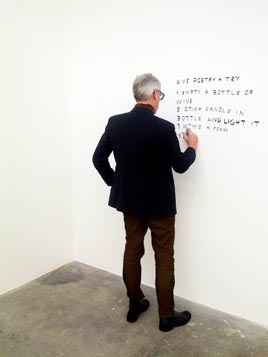
Avec
John M Armleder, George Brecht, John Cage, David Cunningham, Philippe Decrauzat, Jimmie Durham, Robert Fillliou, Henry Flynt, Ken Friedmann, Gilles Furtwängler, Alois Godinat, Jean-Christophe Huguenin, Alison Knowles, Laurent Kropf, George Maciunas, Gustav Metzger, Phill Niblock, Yoko Ono, Mai Thu Perret, Michael Portnoy, Lili Reynaud Dewar, Thomas Schmit, Mieko Shiomi, Ben Vautier, Alan Vega, La Monte Young…
et
Louise Bailat, Thomas Baud, Johana Blanc, Mathias Brugger, Timothee Calame, Martine Gingras, Harold Jefferies, Tayeb Kendouci, Lamya Moussa, Virginie Portier, Magalie Tracqui, Gaia Vincensini, étudiant-e-s à la Head – Genève
Une exposition de Mathieu Copeland et Yann Chateigné
Mise en mots par Karl Holmqvist
Une exposition par le mot, à lire et à interpréter.
Une exposition fragmentée de 50 partitions pour 50 jours par 50 artistes, mais aussi pour 50 ans.
Il est aussi malaisé de cerner avec précision la date de naissance officielle du mouvement Fluxus que de dessiner les contours précis de la constellation d’artistes qui y participe. Par définition, ce groupe d’artistes qui, influencé autant par John Cage, la philosophie orientale que Dada, se rassemble, au début des années 1960, autour des notions de flux et de mouvement, d’interprétation et de circulation.
Aujourd’hui, Fluxus se refuse encore aux cadres établis de l’historiographie y préférant l’intelligence partagée de la création collective et de l’interprétation continue d’un répertoire commun. Prenant comme prétexte la date du «Fluxus-Festspiele Neuester Musik» organisé à Wiesbaden en septembre 1962 par George Maciunas, cette exposition célèbre alors un « non-anniversaire », en posant un regard non pas rétrospectif mais prospectif, sur cette expérience.
Cinquante « partitions » (events, textes, définitions, poèmes, instructions, pièces) sont réunies avec la complicité de John M Armleder, acteur essentiel de la scène genevoise, et dont le groupe ECART, à la fin des années 1960, peut être considéré comme un écho immédiat de Fluxus en Suisse. Durant cinquante jours, celles-ci sont offertes à l’interprétation de cinquante artistes, qu’ils soient liés au groupe ou directement influencés par Fluxus, qu’ils soient des héritiers possibles de cette famille artistique ou dont le travail entre en résonance avec celui des artistes du mouvement, qu’ils soient en formation dans le cadre de l’école.
La forme exposée de ces cinquante partitions est confiée à l’artiste suédois Karl Holmqvist. Le poète et performeur a dessiné une police de caractère basée sur sa propre écriture, mettant ainsi indirectement par écrit ces mots dans l’espace. Sur cette écriture typographiée, il intervient ensuite à la main au travers de notes, textes et dessins, à même les murs de la galerie. Base continue de l’exposition, à partir de laquelle elle s’anime continûment, cette intervention fait écho aux dimensions conceptuelles, performatives, mentales mais aussi musicales, théâtrales, poétiques et vivantes des oeuvres Fluxus. Ce projet active ainsi, en la (re)jouant, une archive potentielle, dont le lieu devient dès lors la chambre d’échos. Cet hommage choral, pris en charge par un réseau d’artistes, accueille en son coeur un groupe d’étudiant-e-s de la Head – Genève, impliqué à divers niveaux du projet: conceptuel, artistique et curatorial. Car ce qui importe ici n’est pas de revivre le passé, mais bien de prolonger cette expérience, voire de la projeter, aujourd’hui, dans le futur.
Vernissage & Performances
Jeudi 13.12.2012 dès 18 h
Rencontre
John M Armleder et Raimundas Malakauskas
Mercredi 19.12.2012 dès 19 h
Suite à un ennui de santé, John Armleder ne sera pas présent pour cette rencontre qui aura tout de même lieu entre Raimundas Malakauskas et Mathieu Copeland et qui sera suivie d’une projection des films ECART, de la collection du FMAC.
Concert
Douze heures de musique en trois actes :
Le répertoire Fluxus et au-delà, interprété et abusé par des artistes aujourd’hui.
Mercredi 16.01.2013 de 12h à 00h
LiveInYourHead, Institut curatorial de la Head – Genève, rue du Beulet 4, 1203 Genève
MARRAKECH PRESS - (les halles) espace d'art contemporain, Porrentruy - CH, 01/12/2012 - 20/01 2013 // Vernissage le Samedi 1er Decembre à Partir de 18h00
MARRAKECH PRESS
Mathieu Copeland & Philippe Decrauzat
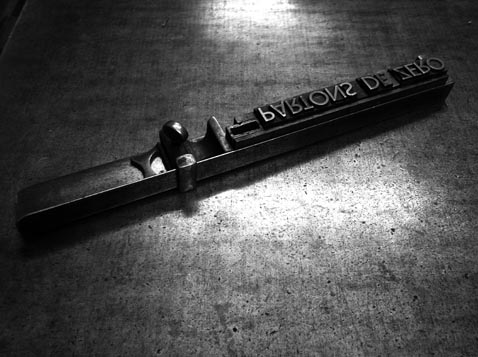
Du 2 décembre au 20 janvier 2013
Vernissage samedi 1er décembre à 18h00
Rencontre avec Mathieu Copeland et Philippe Decrauzat dimanche 2 décembre à 13h30.
Heures d’ouverture :
jeudi : de 17h00 à 19h00
samedi : de 10h00 à 12h00 et de 13h30 à 17h30
dimanche : de 13h30 à 17h30
0u sur rendez-vous 032 420 84 02
Marrakech Press
Marrakech Press est un label de production et d’expérimentation cofondé par le curateur indépendant franco-britannique Mathieu Copeland et l’artiste suisse Philippe Decrauzat. Actif depuis le 1er Janvier 2011, son champ d’action s’étend à l’édition, les expositions, la publication, les manifestes et les films.
L’exposition à l’espace d’art contemporain (les halles), à Porrentruy, s’envisage comme une exposition de peintures, des screenings des deux premiers films produits et réalisés par Marrakech Press, un dessin de Gustav Metzger, et la présentation d’une série de manifestes publiés et distribués à cette occasion.
FILMS
Deux courts-métrages s’articulent et se développent autour du désir de filmer le son et de travailler la superposition et la fragmentation de l’image. Filmés et montés en 16mm, ils suivent à chaque fois la même partition : La surimpression de deux situations dont la première est systématiquement un musicien filmé au moment même où il produit la bande sonore du film. La deuxième, non prédéfinie, est choisie selon les logiques de la dérive et du collage.
Filmé dans le loft new-yorkais du musicien minimaliste Phill Niblock (et enregistré par ce dernier) et à Marrakech dans l’imprimerie régionale, ce premier film rend compte de la surimpression des images du musicien expérimental, le guitariste américain d’avant-garde Alan Licht et des presses de Marrakech, engagées pour l’occasion à faire tourner leur machine, pour ne rien imprimer sur des papiers de format A4 et vierge. Ces mêmes machines ont été utilisées par la suite pour l’impression des manifestes distribués dans l’exposition.
Le second film a été tourné à la frontière Austro-Allemande et dans les montagnes du haut Atlas marocain. Il présente le musicien et percussionniste Allemand F.M Einheit (ex-Einstürzende Neubaten – groupe phare de la musique industrielle post punk créée à Berlin en 1980) au travail chez lui, dans son garage, détruisant briques et miroirs, jouant du son des pierres et du sable sur une large plaque en métal amplifiée. F.M Einheit compose et crée une architecture de ruine abstraite et temporaire, qui se voit superposées à des vues de paysages du Sahara et de l’Atlas.
Ces films sont projetés sur des monochromes noirs de format identique, rythmant l’espace, ces deux peintures-écran s’offrent en écho à un troisième tableau – une composition abstraite de l’artiste Suisse Francis Baudevin repeint en noir pour devenir le tableau test, ici recouvrant sa réalité de ‘peinture’.
MANIFESTES
Bruce McClure, Delphine Coindet, David Cunningham, Peter Downsbrough, Gilles Furtwängler, Kenneth Goldsmith, Lionnel Gras, Scott King, François Kohler, MR Lucy, Gustav Metzger, Raffaella della Olga, Loreto Martinez Troncoso, Diego Santomé, Nick Thurston, et Dan Walsh ont tous été invités à composer et rédiger un manifeste publiés par Marrakech Press, et offert à la lecture dans le cadre de l’exposition.
Tous ces manifestes suivent le même mode de réalisation : Les artistes, curateurs, écrivains, ou encore musiciens ont composé un manifeste, sur le recto d’un format A4. Cette page est ainsi donnée directement aux presses de Marrakech qui les interprète tels une partition et les mettent en page de manière typographique. Ils sont ensuite distribués aux visiteurs de l’exposition.
Finalement, et pour revenir au début, un dessin de Gustav Metzger est présenté dans l’exposition. Réalisé pour la couverture de l’ouvrage ‘Partons de zéro’, première publication de Marrakech Press etprésenté ici en parallèle à son original, ce dessin annonce autant un programme à venir que le contenu d’un livre à considérer comme la partition d’une exposition.
Une édition sera produite dans le cadre de l’exposition.
LE CONFORT MODERNE - Le Confort Moderne, Poitiers, du 16 Mai au 19 Août 2012 // Vernissage le Mercredi 16 Mai à Partir de 18h30
LE CONFORT MODERNE
Une exposition avec Francis Baudevin / Stefan Brüggemann / Henry Codax / Philippe Decrauzat & Alan Licht / Gaylen Gerber / Kenneth Goldsmith / Marc Hurtado & Sébastien Vitré / Martina Klein / Jutta Koether / Sadie Laska / Franck Leibovici / Olivier Mosset / Charlotte Moth / Mai-Thu Perret & Ik ue Mori / Stephen Prina / Florian & Michael Quistrebert / Claude Rutault / Giorgio Sadotti / Hugo Schüwer-Boss / Susan Stenger & F.M. Einheit / Alan Vega / Jacques Villeglé
Commissaire associé : Mathieu Copeland
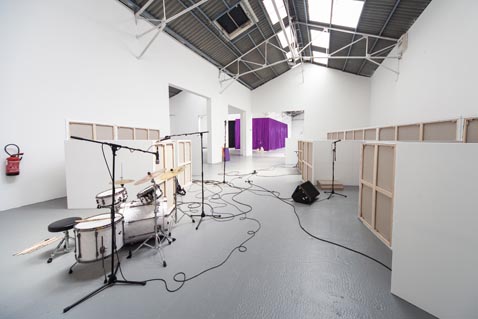
"Le Confort Moderne" au Confort Moderne parle de soi(lui)-même. Une exposition dont l’intitulé porte l’appellation même de l’espace (autant scène musicale mythique que centre d’art contemporain) ne peut que nous ramener à ses enjeux, ces enjeux, nos enjeux!
Mathieu Copeland
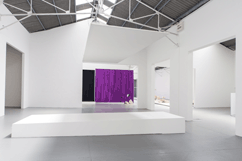
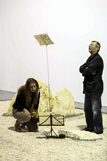
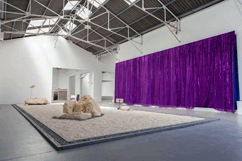
L’exposition est née d’une rencontre avec Mathieu Copeland et la lecture ou plutôt l’écoute commune d’un lieu : Le Confort Moderne. A la fois salle de concerts pionnière et centre d’art depuis plus de vingt ans, le lieu agit comme matrice de l’exposition. L’exposition opère un glissement d’objets picturaux ou conceptuels vers des objets praticables ou réceptacles. L’exposition s’organise en cinq sections : les actions, les partitions, les films, les concerts et la peinture. Les peintures deviennent écran, les concerts activent les oeuvres, les films sont réalisés en collaboration entre artistes et musiciens.
Travaillant une pensée de l’exposition et son rapport entre le "praticable" et "l’objet" (le praxis et l’objekt) – l’oeuvre et l’action de l’oeuvre – "Le Confort Moderne" affirme cette compréhension de l’activation du lieu par les oeuvres, et son corollaire du lieu donnant autant la forme que le contenu. En somme, plus qu’une exposition offrant un confort de l’objet, celle-ci insiste sur le présent de l’action et sa constante modernité.
L’exposition fait dialoguer les oeuvres de près de trente artistes internationaux, de la scène au salon de peinture, de la partition au live, du jardin au cinéma pour la construction d’une oeuvre totale.
--
"Le Confort Moderne" at Le Confort Moderne speaks for itself : an exhibition named after the venue where it takes place (both a mythic music venue and art center) can only bring us back to these issues, its issues, our issues!
Mathieu Copeland
The exhibition arose from a meeting with Mathieu Copeland and from the common feel, or rather the common listening, of the place. Le Confort Moderne has been a music venue and art centre for over 20 years, and its space acts as a matrix of Le Confort Moderne. These modern comforts slides between pictorial or conceptual, through practical objects or receptacles, and is organized into five parts: actions, scores, films, concerts and a painting salon. Paintings become screens, the concerts activate the pieces, the films were made in collaboration between artists and musicians.
Envisaging the exhibition and its link between the 'practicable' and the 'object' (the praxis and the objekt) - the art work and the action of the art work - Le Confort Moderne asserts a reading of a gallery activated by the works within it, while the corollary of the gallery provides the content as much as the form. So to say, more than an exhibition showing comfortable objects, Le Confort Moderne explores the topicality of the action and its continuous modernity. From the stage to the salon de peinture; from the score to the live performance, and from the garden to the cinema, a total work is constructed.
Du 16 mai au 19 août 2012
Entrepôt-galerie du Confort Moderne
Du mercredi au dimanche de 14h00 à 19h00 et les soirs de concerts
Vernissage mercredi 16 mai à partir de 18h30
Performances & Concerts / Susan Stenger & F.M. Einheit / Laetitia Sadier / Rhys Chatham / Nico Vascellari / Martin Rev / James Chance
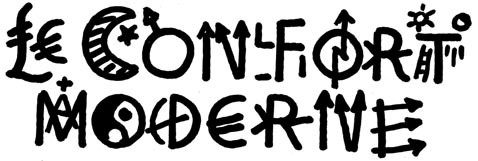
An Exhibition to Hear Read
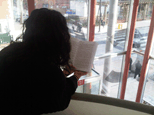
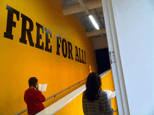
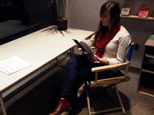
Hear ICA’s interstitial spaces shaped by a polyphony of voices. This spring the Institute of Contemporary Art (ICA) at the University of Pennsylvania will host a unique performative event. Penn students will collaborate with students from HEAD - Geneva to continuously read a selection of textual artworks every day for a week in February.
An exhibition to hear read proposes the notion of speech as material gesture, in which both the texture of the word and its spoken quality are inscribed in space and time through the act of reading. The vocal interpretation of these artworks constructs an abstract and ephemeral reality that can be said to sculpt the spaces in which it occurs. This ongoing investigation into the materiality of artwork as a question of word and speech is crystallized through a series of publications that act as both score and memory.
This event at the ICA will be the fourth in a series of “volumes,” each presented at a different venue. An exhibition to hear read is curated Mathieu Copeland and is realized in partnership with Kenneth Goldsmith, Penn’s Center for Programs in Contemporary Writing, HEAD (Haute école d’art et de design Genève / Geneva University of Art and Design), and the Cultural Services of the French Embassy in the USA. This fourth volume, hosted by the ICA, is the first to be presented in the United States. The first volume was commissioned by the contemporary art center La Synagogue de Delme in France, a second in Geneva by HEAD’s curatorial institute Live In Your Head, and a third by the David Roberts Art Foundation in London.
An exhibition to hear read will be performed by students from the yearlong seminar Writing Through Art and Culture at Penn and from the WORK.MASTER at Geneva University of Art and Design. It features textual works by the following Penn students: Yolanda Carney, Ana Maria Gomez Lopez, Alexander Hovnanian, Staci Kaplan, Ellie Levitt, Christina Lisk, Isabel Oliveres, Sarah Richter, Alexander Schwartz, and Naomi Shavin. It also features written works by artists including: Marí Alessandrini, Robert Barry, Sacha Béraud, Emma Bjornesparr, Jérémy Chevalier, Keren Cytter, Chloé Delarue, Amélie Dubois, Jarrod FowlerNicolas Garait, Goldin + Senneby, Kenneth Goldsmith, Anne-Sylvie Henchoz, Karl Holmqvist, Jean-Christophe Huguenin, Bethan Huws, Livia Johann, Tom Johnson, Franck Leibovici, Benoît Maire, David Medalla, Charlotte Moth, Falke Pisano, Véronique Portal, Lili Reynaud Dewar, Tatiana Rihs, Daphné Roulin, Yann Sérandour, Cally Spooner, Irena Tomažin, Sue Tompkins, Anne Le Troter, and Martina-Sofie Wildberger.
Timed to coincide with Penn’s conference on abstraction (co-sponsored by ICA and the Department of the History of Art), An exhibition to hear read commences on February 10 and runs through February 19.
A Conversation with Mathieu Copeland at the University of Pennsylvania - Kelly Writers House (3805 Locust Walk - Philadelphia, PA 19104) - 02/16/2012 @ 6pm
Mathieu Copeland talks at The Curatorial Hub at ICI (401 Broadway, Suite 1620 ; New York, NY 10013) on February 21st @ 7pm
Reprise #1 - Studies for a catalogue / a study for an exhibition on violence in contemporary art (reprise 1964/2011) - Flat Time House, London - Friday 24 June - Sunday 31 July
Closing Bbq & Publication Launch - Sunday 31 July, 2-6pm
Reprise #1
Studies for a Catalogue: a Study for an Exhibition of Violence in Contemporary Art (Reprise 1964/2011)
with Karel APPEL – Jean ARP – Francis BACON – Enrico BAJ – Elena BAJO – Giacomo BALLA – Davide BALULA – BALTHUS – Erica BAUM – Max BECKMANN – Tom BENSON – Hans BELLMER – George BELLOWS – Emma BJORNESPARR – Peter BLAKE – Umberto BOCCIONI – Frank BOWLING – Georges BRAQUE – Victor BRAUNER – Stefan BRÜGGEMANN – Edward BURRA – Alberto BURRI – Reg BUTLER – Alexander CALDER – Guiseppe CAPOGROSSI – Carlo CARRA – CESAR – Paul CEZANNE – Lynn CHADWICK – DADO – Salvador DALI – Alan DAVIE – Giorgio DE CHIRICO – Willem DE KOONING – Niki DE SAINT–PHALLE – Philippe DECRAUZAT – André DERAIN – Otto DIX – Jean DUBUFFET – Marcel DUCHAMP – James ENSOR – Max ERNST – Peter FILLINGHAM & Charlotte MOTH – Lucio FONTANA – Sam FRANCIS – Alberto GIACOMETTI – Juan GRIS – Arshile GORKY – Georg GROSZ – Renato GUTTUSO – Richard HAMILTON – Raoul HAUSMANN – Rudolph HAUSNER – John HEARTFIELD – Erich HECKEL – Anne-Sylvie HENCHOZ – Camille HENROT – Maurice HENRY – Roger HILTON – David HOCKNEY – Hans HOFMANN – Allen JONES – Asger JORN – Frida KAHLO DE RIVERA – Wassily KANDINSKY – Ellsworth KELLY – R.B. KITAJ – Paul KLEE – Oskar KOKOSCHKA – Alfred KUBIN – KUKRYNSKI – Felix LABISSE – Wilfredo LAM – John LATHAM – Fernand LEGER – Pablo LEON DE LA BARRA – Wyndham LEWIS – Roy LICHTENSTEIN – Max LINDNER – Jacques LIPSCHITZ – LUCEBERT – René MAGRITTE – André MASSON – Umberto MASTROIANNI – Georges MATHIEU – Henri MATISSE – Mark MCGOWAN – MATTA – F.E. McWILLIAM – Henri MICHAUX – Manolo MILLARES – Joan MIRO – Piet MONDRIAN – Henry MOORE – Edvard MÜNCH – Antonio MUSIC – R. MUTT (Marcel Duchamp) – Paul NASH – Warren NEIDICH – Sidney NOLAN – José Clemente OROZCO – Eduardo PAOLOZZI – Peter PHILLIPS – Francis PICABIA – Pablo PICASSO – Edouard PIGNON – John PIPER – Philomene PIRECKI – Jackson POLLOCK – POSADA – Mel RAMOS – Man RAY – Odilon REDON – RICHARDS – Germaine RICHIER – Bridget RILEY – Diego RIVERA – RODIN – Theodore ROSZAK – Georges ROUAULT – Henri ROUSSEAU – Antonio SAURA – Giorgio SADOTTI – Gerald SCARFE – Karl SCHMIDT–ROTLUFF – SCHROEDER-SONNENSTERN – Kurt SCHWITTERS – Gino SEVERINI – Ben SHAHN – SINE – David Alfaro – SIQUEIROS – Richard SMITH – Chaim SOUTINE – Saul STEINBERG – Graham SUTHERLAND – Rufino TAMAYO – Yves TANGUY – Dorothea TANNING – Jean TINGUELY – Henri de TOULOUSE-LAUTREC – Clovis TROUILLE – Fritz VAN DEM BERGHE – Victor Vincent VAN GOGH – VASARELY – Renzo VESPIGNANI – Andy WARHOL – Neal WHITE – WOLS and Ossip ZADKINE.
An Exhibition by Mathieu COPELAND.
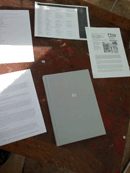
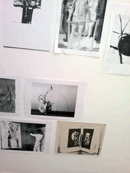
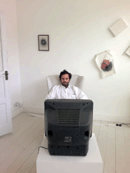
Reprise /ri’pri:z/ n. & v. : n. 1 A repeated passage in music. 2. A repeated item in a musical programme. v.tr. repeat (a performance, song, etc.); restage, rewrite. [French, fem. past part. of reprendre]
What remains of an exhibition, once it has run its course, is crystallised in its catalogue, the materials it generated, and the memories of those who experienced it. Yet the exhibition that once was is also a material – equal to any other – and as such can be reprised weeks, months or years later, and in different contexts.
A catalogue generally makes available the details of the works that were included in an exhibition. It ‘reproduces’ images of the artefacts that made it be and/or views of the exhibition itself. Catalogues are at best the memory of an exhibition, at worst its checklist. To reprise an exhibition can be seen as an attempt to envisage its memory, to re-insert it in reality, by using its catalogue as a score for another exhibition to be.
Past realities are revisited and appropriated by the presentation of an entire ‘bootleg’ of an exhibition. To do so is to curate an exhibition without choosing any of the works. The original artworks are copied, their reproductions insisting on their equivalence to the original. From the catalogue's checklist, an approximation of all the artworks is gathered and united in a format that only has to be printed in order to generate another bootleg ; a distant echo of the original, an exhibition evolving from what once was and in constant expansion.
Mathieu Copeland, July 2011
Studies for an Exhibition, David Roberts Art Foundation - London 07/04 - 11/06 2011
Opening: 06/04 @ 18.30
curators’ series # 4
Studies for an Exhibition
07.04.2011 -11.06.2011.
please join us for the opening: 06.04. 2011 from 6.30
With Elena Bajo, Robert Barry, Emma Bjornesparr, Jarrod Fowler, Nicolas Garait, Karl Holmqvist, Bethan Huws, David Medalla, Gustav Metzger, Roman Opalka, Julia Rometti & Victor Costales, Karin Sander, Yann Sérandour, Cally Spooner, Sue Tompkins, and Niele Toroni.
an exhibition by Mathieu Copeland.
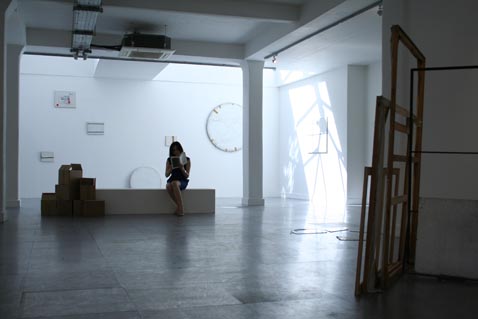
Mathieu Copeland is the fourth guest curator invited by The David Roberts Art Foundation to be part of the Curators’ Series. Studies for an Exhibition, explores how exhibitions are to be envisaged in regard to transient thoughts – an art that reveals itself through time, as movements of transitions, as possible studies giving the feeling of what is, and what can be.
Following a desire to not fix in form an exhibition to be, Studies for an Exhibition brings together practices that explore the possibilities of immateriality and the temporal nature of an art object. The question of time and accumulation is adamant to an exhibition that considers a recycling of our current reality as the means to generate transitory new forms.
Moments of history are revisited, as with the recreation of Gustav Metzger’s 1956 display/appropriation of the posters advertising the seminal show at the Whitechapel Gallery This Is Tomorrow, which he used to cover the entire shop windows of his then second hand shop/exhibition space 30Queens in Kings Lynn. A means to advertise what was tomorrow then, the posters can be read in parallel to the altered exhibition posters by Niele Toroni, who painted over posters advertising his own exhibitions, thereby blurring the moment of the original shows and when these are painted, and shown. Past realities are again revisited and appropriated when confronted with the entire ‘bootleg’ of a 1964 ICA exhibition entitled Study for an exhibition of violence in contemporary art.
In relation to these works of past and present readings, the ‘mailed paintings’ by Karin Sander create in the space of the gallery an unstable hanging as these are being mailed back and forth to the artist in Berlin for the duration of the exhibition. The paintings capture their own reality by acquiring marks as they travel unprotected from one place to the next. As an echo to this reality in motion for an exhibition to be, Emma Bjornesparr addresses the location of the gallery and the habits of consumption. Through a temporary sculpture that frames the entire time of an exhibition in saving the accumulated waste, the artist creates the inversed portrait of the host institution.
Since 1972 Roman Opalka marks time through the progressive inscription of numbers painted from one to infinity. The constant evolution of these paintings is accompanied by a tape recording of his own voice saying the numbers out loud as he writes them. By disseminating these recordings in the space of the gallery we are projected into an ephemeral experience of time.
Accumulation of knowledge is the focus of Julia Rometti and Victor Costales’ work. Exotismo Ordinario Internacional Neotropical is an archive based on their ongoing research into plants from the neotropical region. As part of this continuous study, a series of booklets will be handed out. Elena Bajo’s commission is to be dreamt, forgotten, drawn on a wall or indeed erased. Showing the process of becoming, it is a piece that is all of its studies, changes and potentialities, echoing the exhibition in becoming a study for all that it can and could be.
And as yet another possible study discussing the form of an exhibition, Mathieu Copeland has edited a new publication, the third volume of his series entitled An Exhibition to Hear Read/Une Exposition à être lue. The book will be read out at 2pm every day for the duration of the exhibition. This publication features text based artworks by Robert Barry, Jarrod Fowler, Nicolas Garait, Karl Holmqvist, Bethan Huws, David Medalla, Yann Sérandour, Cally Spooner, and Sue Tompkins. These contributions consider the relation between a text as an art piece to be and its spoken realisation, questioning the ‘performativity’ of the act of reading from a book.
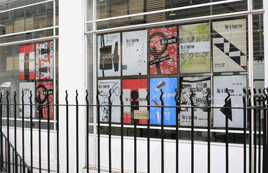
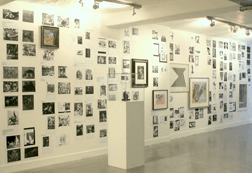
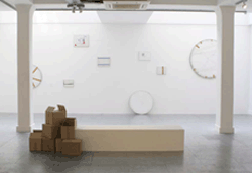
The exhibition is supported by the National Lottery through Arts Council England, the French Institute, London, Swedish Embassy in London and Accion Cultural Espanola, London.
the DAVID ROBERTS ART FOUNDATION -FITZROVIA
111 GREAT TITCHFIELD STRET , LONDON W1W 6RY
TEL : +44 20 7637 0868, WWW.DAVIDROBERTSARTFOUNDATION.COM
OPENING HOURS : TUESDAY -FRIDAY 10AM - 6PM , SATURDAYS 11AM - 4PM
Une Chorégraphie Polyphonique & Une exposition à être lue (volume 2), LiveInYourHEAD Genève 13/01/2011 - 29/01/2011
VERNISSAGE: 13/01/2011 @ 18.00
UNE CHOREGRAPHIE POLYPHONIQUE & UNE EXPOSITION A ETRE LUE (VOLUME 2)
Avec Marí Alessandrini, Sacha Béraud, Emma Bjornesparr, Jérémy Chevalier, Chloé Delarue, Kenneth Goldsmith, Anne-Sylvie Henchoz, Jean-Christophe Huguenin, Livia Johann, Tom Johnson, Franck Leibovici, Véronique Portal, Lili Reynaud Dewar, Tatiana Rihs, Daphné Roulin, Cally Spooner, Irena Tomažin, Anne Le Troter et Martina-Sofie Wildberger
Une exposition de Mathieu Copeland
Vernissage le jeudi 13 janvier à 18 heures
Exposition du 14 au 29 janvier 2011
Du jeudi au samedi de 14 à 19 heures
LiveInYourHead
Institut curatorial de la Head – Genève
Rue du Beulet 4, 1203 Genève
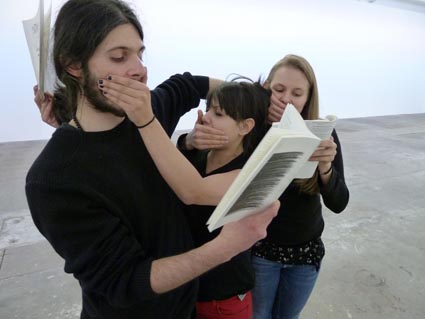
Une Chorégraphie Polyphonique & Une Exposition à Etre Lue (Volume2) est la première d’une série de lab.zones (ateliers) conçues par Mathieu Copeland au sein du programme work.master de la Head – Genève, en collaboration avec un groupe d’étudiant-e-s-artistes et avec les contributions de différentes figures invitées.
L’exposition s’articule autour de la question du mot, des mots imprimés dans un livre à être lu aux mots lus dans un mouvement à trois voix, pour former une Chorégraphie Polyphonique. Le pouvoir évocateur des trois mouvements est interprété par la voix, que ce soit à l’unisson, dans la simultanéité, la répétition, ou encore la succession et le geste. L’exposition est uniquement composée d’oeuvres textuelles, écrites par les artistes et conçues pour être lues à trois voix en permanence durant les horaires d’ouverture de l’espace LiveInYourHead. L’exposition est envisagée comme une forme vivante, minimale, continue, vocale autant que mentale, intellectuelle autant que corporelle.
Sa réalité textuelle, la texture du mot et sa qualité lue posent les questions de la gestuelle de la parole, du mouvement des mots et celle de l’inscription du geste de lire dans l’espace d’exposition lui-même. L’interprétation des oeuvres écrites révèle autant l’architecture sensible de l’espace qu’une réalité abstraite et éphémère, portée par la voix, une polyphonie constructive et destructive du contenu intelligible, dans l’espace et le temps.
Approchant l’oeuvre par sa matérialité, et envisageant par là même la matérialité de l’exposition au travers du mot et de la parole, cette Exposition à être lue se cristallise au sein d’une publication. Celle-ci regroupe des oeuvres – écrites par les étudiant-e-s-artistes et les artistes, musiciens ou encore poètes internationaux invités pour l’occasion – qui constituent autant sa partition que sa mémoire.
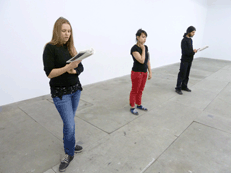

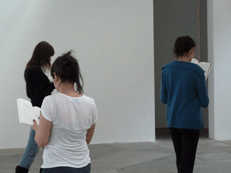
Plus d'informations - http://head.hesge.ch/IMG/pdf/LIYH_Mathieu_Copeland-2.pdf
An exhibition of the word(s) on UbuWeb - August 2010
AN EXHIBITION OF THE WORD(S)
A. Dziga Vertov Group - Letter to Jane
B. Michael Snow - So this is
C. Franck Leibovici - 9+11 [PDF]
D. Karl Holmqvist - Rockland
E. Meredith Monk - As if it came from an oral tradition from Chicago '82: A Dip in the Lake
F. James Lee Byars - Pronounce perfect until it appears, 1979, 0'03" from Happy New Ear
G. Salvador Dali - La Méthode Paranoïaque Critique from Je Suis Fou De Dalí!
H. Gilbert and George - Ten Commandments for Gilbert and George
I. Keren Cytter - Der Spiegel
J. Bob Cobbing - Performing Concrete Poetry [here] and [here]
K. Erica Baum - Body Language [PDF]
L. Bern Porter - The Last Acts of St. Fuck You [PDF]
An exhibition of the word(s), Featured Resources for August 2010 selected by Mathieu Copeland for UbuWeb
UNE EXPOSITION (DU) SENSIBLE
Avec/With, par ordre d'apparition/in order of appearance, Gustav Metzger, Cildo Meireles, Dexter & Sinister, Franck Leibovici, Kenneth Goldsmith, Cesare Pietroiusti, Benoit Maire, Goldin + Senneby, Keren Cytter, Amélie Dubois, Charlotte Moth, Cally Spooner, Falke Pisano
Une exposition de/An exhibition by Mathieu Copeland
La synagogue de Delme
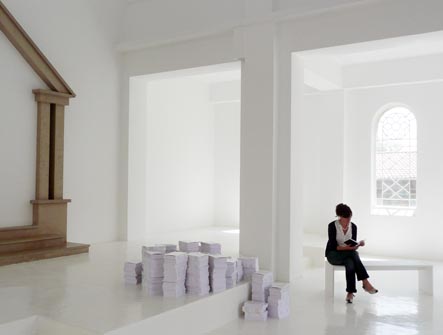
Mathieu Copeland s’est précédemment illustré dans la conception d’expositions renégociant le rapport du spectateur aux œuvres, et des œuvres aux lieux censés les rendre visibles. Vides, une rétrospective, au Centre Pompidou à Paris rassemblait ainsi neuf expositions « vides » de l’histoire de l’art. Une Exposition Chorégraphiée, au Centre d’art de la Ferme du Buisson présentait des œuvres conçues pour être dansées par trois performeurs, selon une partition d’enchaînements écrite par le commissaire. Dans Une Exposition Parlée, elles étaient lues et activées par l’équipe du centre d’art Baltic de Newcastle upon Tyne. Évoquons enfin Soundtrack for an exhibition au Musée d’Art Contemporain de Lyon, immense partition musicale étirée sur plusieurs mois, où la musique devenait l’exposition à proprement parler. D’exposition en exposition, Mathieu Copeland dessine une manière de faire et de pousser la forme artistique tout comme l’institution dans leurs retranchements. Qu’elles soient musicales, parlées, chorégraphiées, les œuvres placent le spectateur en position de jouer à son tour sa partie, tout du moins de dépasser le vide apparent pour écouter, se mouvoir, capter de tous ses sens l’air et la réalité qui l’entoure.
Partant d’une conversation avec l’artiste Gustav Metzger, pionnier de l’Art Autodestructif depuis 1959, Mathieu Copeland réaffirme avec lui qu’il ne s’agit pas d’utiliser l’exposition pour montrer des objets dans un espace physique déterminé, mais de réaliser ces objets, envisageant alors la synagogue de Delme comme le lieu d’où l’on part, et non plus comme une fi n en soi ni un point d’arrivée. Plutôt un passage...
Les œuvres produites s’affranchissent des limites habituelles de l’exposition pour s’insérer dans la vie et l’économie d’un territoire. Les réseaux locaux, qu’il s’agisse de médias, d’évènements ou de services, deviennent tout à la fois le support et le lieu d’apparition des œuvres. C’est le cas du film de Franck Leibovici projeté tout l’été en première partie des films de cinéma itinérant en Lorraine, de la pièce radiophonique de Kenneth Goldsmith diffusée chaque jour via des radios locales, des interventions hebdomadaires de Cesare Pietroiusti dans le journal, sous forme de « pensées non fonctionnelles », ou encore du Bulletin Municipal 2010 de la commune de Delme, revisité par le duo Dexter & Sinister et à partir duquel sont déclinés les supports de communication pour Une exposition (du) sensible. Le titre renvoie à l’ancrage de tout le projet dans une réalité sensible, qu’elle soit entre les quatre murs blancs du centre d’art ou dans les boîtes aux lettres des habitants de Delme, qui ont reçu chez eux le fameux Bulletin.
Si le centre d’art devient la caisse de résonnance d’œuvres qui ont lieu ailleurs, il est aussi une structure vivante, qui rassemble des objets mouvants, activés et activables : l’œuvre que Cildo Meireles a conçu en 1970, intitulée Insertions dans des circuits idéologiques, consiste à « enregistrer des informations et des opinions critiques sur des billets de banque et les remettre en circulation ». L’artiste s’employait alors à tamponner les billets, avec ce titre et cette phrase, assortis de messages militants, avant de les réinjecter dans le flux des échanges bancaires. L’œuvre est ainsi réactivée dans le cadre d’Une exposition (du) sensible. Si le texte, le langage, la lecture et la parole sont conviés au fil des œuvres de multiples manières, le livre édité spécialement pour l’exposition, intitulé Une exposition à être lue, condense tout particulièrement cette dimension. Il rassemble les contributions de Keren Cytter, Amélie Dubois, Goldin+Senneby, Benoît Maire, Charlotte Moth, Falke Pisano et Cally Spooner : narrations, descriptions d’espaces imaginaires, protocoles de lecture, scripts d’œuvres filmiques renvoient à la matière textuelle au cœur du travail de ces artistes, fascinés par le langage et sa puissance d’évocation. La lecture des œuvres écrites révèle autant l’architecture sensible d’un espace, celui de la synagogue, mais pas seulement : une réalité sensible et éphémère, portée par la voix. Une exposition (du) sensible déjoue les cadres spatiaux et temporels dans lesquels on circonscrit les œuvres, ainsi que le fonctionnement lissé des institutions, une sorte de science aigüe du glissement et de la dissémination des formes. Certaines œuvres ont déjà eu lieu, d’autres auront lieu après-coup, comme c’est le cas de l’intervention de Gustav Metzger dans la presse locale en octobre. Le centre d’art se fait articulation, de temps et de lieux, mais aussi de mots et de phrases, qu’elles soient écrites, lues ou parlées.
Marie Cozette
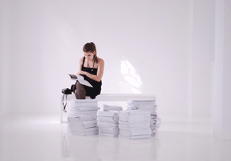
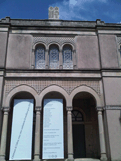
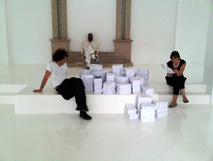
Engaging with a practice that often considers immateriality, Mathieu Copeland proposes exhibitions that renegotiate the relationship between the spectators and the works, and between the works and the venues supposed to give them visibility. “Voids, a Retrospective” at the Centre Pompidou in Paris brought together nine historical “empty” exhibitions; “A Choreographed Exhibition” at the Ferme du Buisson Contemporary Art Centre presented artworks as gestures and movements that were danced by a trio, written in time by the curator; in “A Spoken Word Exhibition” the works were read aloud by the staff of Baltic, Newcastle upon Tyne’s contemporary art centre; or again with “Soundtrack for an Exhibition”, a seemingly timeless score stretched out over several months at the Museum of Contemporary Art in Lyon, the music actually becoming the exhibition.
From one venture to the next, Mathieu Copeland has outlined a way of working that subjects artistic forms and institutions to radical challenges. May these be of sound, to be spoken or danced, the works place the viewer in the situation of having to play his own part in turn – or at the very least of having to transcend a seeming void so as to listen, move about and tune in sensorially to an atmosphere and its surrounding reality.
Referencing a conversation with Gustav Metzger, the seminal activist and pioneer of auto destructive art, Copeland joins the artist in reaffi rming that the exhibition should serve not to show things in a predefifi ned physical space, but to realise them; the Synagogue de Delme is thus taken as a point of departure, and not as an end in itself nor a destination. More a transient place.
Breaking out of the usual exhibition boundaries, the works inhabits the specifi c life and economy of a given territory. Local networks – media, events, services – become simultaneously the medium and the venue for the works. Such is the case for Franck Leibovici’s fi lm, shown before all the features that will be shown this summer as part of the itinerant cinemas circuit in Lorraine; Kenneth Goldsmith’s daily piece on local radios; Cesare Pietroiusti’s weekly “non-functional thoughts” in the press; and the Municipality of Delme’s Bulletin for 2010, revisited by the duo Dexter & Sinister and serving as the publicity basis accompanying “Une Exposition (du) Sensible”. The title, that could be translated as “A Sensibility Exhibition” or “An Exhibition of the Sensible”, refers us to the project’s roots in a perceptible reality, may this be within the art centre’s four white walls or through the letter boxes of Delme, as every inhabitant of the town received a copy of the Bulletin.
While the art centre thus becomes a resonance chamber for works happening elsewhere, it is also a living structure, an assembly point for mobile objects both activated and activatable: Cildo Meireles’ Insertions into Ideological Circuits from 1970 which involves “recording information and critical opinions on banknotes and reintroducing them into circulation”. At the time the artist stamped the notes with this title, as a call to the addition of political messages, before reintroducing them into the fl ow of the banking system. This work, is, once again, reinserted for the time of the exhibition.
If text, language, reading and speech appear to be the basis of the works composing this exhibition, the book specially published for the exhibition and titled An Exhibition To Hear Read provides a singular condensation in the form of contributions by Keren Cytter, Amélie Dubois, Goldin+Senneby, Benoît Maire, Charlotte Moth, Falke Pisano and Cally Spooner: narratives, descriptions of imaginary spaces, reading protocols and fi lm scripts (...) all reference the textual matter central to the work of these artists fascinated by language and its powers of evocation. A reading of the written works reveals not only the perceptible architecture of any given space – that of the synagogue – but also a perceptible and ephemeral reality channelled through the voice.
“Une Exposition (du) Sensible” thwarts both the circumscribing of works by spatial and temporal frameworks and the bland functioning of art institutions, that highly developed pseudo-science of displacement and dissemination of forms. Some of the works have already taken place, others will happen at a later stage: Gustav Metzger’s contribution via the local press is scheduled for October. The art centre thus functions as a point of articulation for times and places, but also for words and phrases, whether written, read or spoken.
Marie Cozette
AUTOUR DE L’EXPOSITION
Visite commentée avec Mathieu Copeland : dimanche 12 septembre à 16h
Visites commentées avec Laurène Macé, chargée des publics : tous les dimanches à 16h
INFORMATIONS PRATIQUES
Vernissage de l’exposition vendredi 11 juin à partir de 18h30,
en présence des artistes et de Mathieu Copeland.
Exposition ouverte du 11 juin au 19 septembre 2010.
Mercredi-samedi : 14-18h & dimanche : 11-18h. Entrée libre et gratuite.
Le centre d’art sera ouvert le 14 juillet et le 15 août.
POUR SE RENDRE À LA SYNAGOGUE DE DELME
ACCÈS DEPUIS PARIS (1h30):
TGV Est, arrivée Metz ou Nancy
ACCÈS DEPUIS METZ (1/2h):
D955, ancienne route de Strasbourg
ACCÈS DEPUIS NANCY (1/2h):
N74 direction Château-Salins
puis D955 vers Metz
Visuels disponibles sur demande
Contact presse: Agathe Borgne communication@cac-synagoguedelme.org / +33(0)3 87014342
"... avant il n'y avait rien, après on va pouvoir faire mieux.", une exposition de motifs et desseins à Circuit, Lausanne 18/06 - 04/09 2010
VERNISSAGE: 18/06 @ 18.30
CIRCUIT
Centre d’art contemporain
Av. de Montchoisi 9, accès quai Jurigoz
case postale 303, CH - 1001 Lausanne
+41 21 601 41 70
www.circuit.li
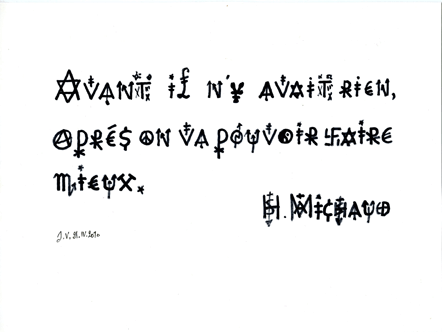
Une exposition de motifs et desseins d’Alan Vega et Antonin Artaud, Kurt Seligmann, Ad Reinhardt, Paul Sharits, Emma Kunz, Glenn Branca, Gustav Metzger, Wallace Berman, Phoebe Unwin, Claude Parent, Jon Savage, Unica Zürn, Madelon Vriesendrop, Charles Burns, Judy Chicago, Brion Gysin, Amélie Dubois, Savage Pencil, Hans Hartung, Asger Jorn, André Masson, Max Kohler, Henri Michaux, Mel Bochner, Steve Albini, Dinos Chapman, Jake Chapman, Jean Tinguely, Max Ernst, Gerhard Rühm, Tadeusz Kantor, NPA, Bruce Conner, Marty Rev, Bob Cobbing, Linder Sterling, Frank Kozik, George Maciunas, Leonora Carrington, Henry Flint, Henri Chopin, Georges Brecht, Le Freistilmuseum, Loulou Picasso, Yoko Ono, Scott King, Rudolph Grey, A.R. Penck, Michael Snow, J.G. Ballard, Salvador Dali, Paul “Cool P” Liebegott, Wyndham Lewis, Jacques Villeglé, Karl Holmqvist, Jacques Bonnard, Ric Ocasek, Marian Zazeela, Delphine Coindet, Genesis Breyer P-Orridge, Warren Neidich, Hans Bellmer, Natacha Anderes, Peter Fischli, Roland Topor, Virginia Overton, Andrea Merkx, W. C. Westermann, Fabrice Stroun et tant d’autres.
un inventaire partiel de Mathieu Copeland et Circuit
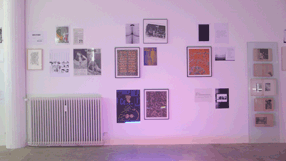
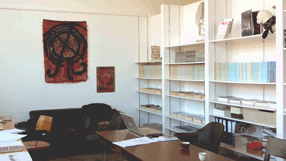
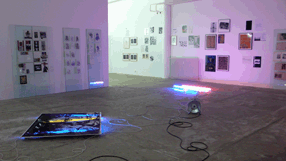
* Préambule d’Henri Michaux à son film “Images du monde visionnaire” de 1964
Le dessin, dans toute sa complexité et sa diversité, existe peut-être et avant tout par son apparente économie. La simplicité possible d’une feuille et d’une technique, un moment pris, une surface remplie. Envisageant le motif et son dessein, l’exposition offre une ouverture nécessaire sur l’écriture et l’art imprimé au travers du dessin et de ces formes possibles de diffusion.
Cette exposition s’offre au regard d’une large sélection d’œuvres dessinées et imprimées d’Alan Vega (né en 1938 à Brooklyn), et accompagnant la sortie de l’ouvrage rétrospectif sur l’œuvre de cette figure mythique de la scène alternative artistique New Yorkaise et pionner du rock électronique minimal en tant que cofondateur avec Martin Rev du groupe culte Suicide. Sur plus de 40 ans de création et d’intensité, Alan Vega s’est affirmé comme l’un des artistes et musiciens les plus influents, faisant du Punk le manifeste d’une raison de vivre.
Cofondateur en 1969 de MUSEUM A Project of Living Artists à New York, un des premiers lieux alternatifs « artist-run spaces » new-yorkais et ouvert 24h/24, MUSEUM était dédié à toutes les formes d’art, aussi bien visuelles que musicales et cinématographiques, devenant rapidement un tremplin pour un grand nombre d’artistes et de musiciens. Vega écrit alors les « Requêtes du Front de Libération du MUSEUM », une série d’injonctions nécessaires et tellement actuelles incluant par exemple ce cri pour que « les systèmes d’exposition, y compris les sélections pour les expositions collectives, soient abolis. » ou encore donnant « le droit à n’importe quel artiste de retirer une œuvre, de modifier une œuvre, de détruire une œuvre de n’importe quel autre artiste présentant son travail dans l’espace » - un texte signé par un Artiste Américain Anonyme du 20e siècle- qui accueille aujourd’hui les visiteurs entrant à CIRCUIT.
À la fin des années 50, Alan Vega étudie notamment avec Ad Reinhardt et Kurt Seligmann au Brooklyn College, et se concentre dans un premier temps sur la peinture, puis le dessin. À la fin des années 60, son intérêt se porte sur la lumière : il crée ses premières « light sculptures », des sculptures lumineuses faites d’assemblage d’objets divers composées d’ampoules, de câbles, de télévisions et de néons de toutes formes et couleurs. Anti-esthétique, antiforme, le pendant d’un Arte Povera « Made in USA », son œuvre embrasse la réalité contemporaine dans laquelle il vit.
L’exposition se concentre principalement autour de son œuvre graphique. Vega insiste comment « pour (lui), le dessin a toujours été un devoir, (et) la peinture une douleur ». Dessinant quasi uniquement des visages, il déclare avoir toujours « aimé dessiner des personnes âgées. Elles ont l’image de la vie gravée sur leur visage ». Activité parallèle et nécessaire à son travail musical, Vega ne peut écrire sans dessiner : « Tout comme l’écriture, dessiner constitue une obsession quotidienne. Comme pour l’écriture, faire un dessin surgit subitement. Avec le dessin, il faut partir ailleurs, quelque part où je n’en ai rien à foutre. Je m’assois, l’esprit absent et en paix (…). C’est une manière de mettre à plat
des idées ».
L’exposition se propose ainsi comme un écho suicidaire au désir d’une exposition qui n’est autre qu’un inventaire morcelé et subjectif.
Son agencement reflète le système d’écriture possible d’une exposition entendue comme le manifeste concrétisé d’une poésie qui se montre. Le chant de mille voix entamant un anthem ou le dessin est l’égale de sa reproduction. Envisageant l’ensemble des œuvres présentes ou suggérées comme un environnement sensible, toutes s’écrivent dans l’espace comme une partition à lire abstraitement.
Oscillation sensée de pièces ultra-figuratives qui (se) composent de nouvelles figures et identités poétiques, au contrepoids composé d’une large sélection d’œuvre abstraite, toutes s’offrent à être lues comme la « carte mentale d’une exposition ». Cette phrase devient à son tour le titre de l’ouvrage photocopié mis à disposition au public, un recueil ou se retrouve mis au même niveau toutes les œuvres constituant cette exposition.
Les rapports, cohésions ou rejections qui s’opèrent entre chacune des parties constituantes de se regroupement temporaire insistent sur la base qui les unies toutes - le dessin, et ses modes possibles de diffusion. D’un médium à l’autre s’affirme une équivalence sur la valeur nécessaire des œuvres présentées.
Hasard arrangé par la géométrie, hors d’une utopie moderne, cet agencement éphémère offre un va-et-vient d’objets référencés, et reproduits… Et si ce qui au départ s’offrait comme un vide premier laissant toutes formes de futures possible, permettons nous de conclure avec une autre phrase d’Henri Michaux, une phrase autant tiré de son magnifique ouvrage de 1948 ‘Meidosems’
qu’extraite – pour l’instant – de l’exposition :
« Ils ont abouti ici. Et il n’y a rien à ajouter ».
Mathieu Copeland et Philippe Decrauzat
NEWS : SWISS EXHIBITION AWARD 2010 to "…avant il n’y avait rien, après on va pouvoir faire mieux…"
L'exposition Continue
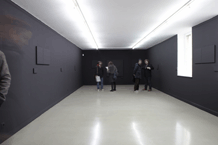
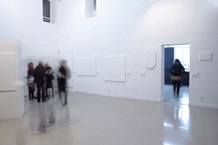
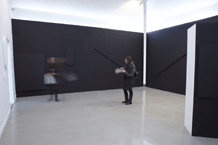
Des peintures de Birgir Andresson, Francis Baudevin, Jean-Sylvain Bieth, Stefan Brüggemann, Michel Castaignet, John Cornu, Stéphane Dafflon, Philippe Decrauzat, Noël Dolla, Olivier Mosset, Christian Robert-Tissot, Josh Smith, Evi Vingerling, Robert Barry, Ditte Ejlerskov (…) repeintes de la même couleur que le mur par Claude Rutault.
Une exposition de Mathieu Copeland.
Du 09/02 au 18/04 2010
Inauguration dimanche 07/02 de 14h à 18h
Navette gratuite Place du Châtelet 13h30
cneai =
tél : 01 39 52 45 35, fax : 01 39 52 43 78,
cneai@cneai.com, île des impressionnistes, 78400 chatou, france
"L’exposition présente des peintures de Birgir Andresson, Francis Baudevin, Jean-Sylvain Bieth, Stefan Brüggemann, Michel Castaignet, John Cornu, Stéphane Dafflon, Philippe Decrauzat, Noël Dolla, Olivier Mosset, Christian Robert-Tissot, Josh Smith, Evi Vingerling, Robert Barry, Ditte Ejlerskov (…) repeintes de la même couleur que le mur par Claude Rutault .
S’offrant comme une réflexion sur ce qu’est la peinture, l’exposition se fragmente en plusieures expositions concomitantes. En premier lieu, une exposition classique de peintures de différents artistes ; peintures qui sont, suivant le principe fondamental de l’œuvre de Claude Rutault initié en 1972, repeintes de la même couleur que le mur, affirmant ainsi une deuxième exposition. En écho s’offre une troisième exposition fantôme, des toiles monochromes de Claude Rutault au format identique aux peintures repeintes insérées au sein même de l’architecture du Cneai. Une exposition en miroir (et en échange), qui s’inscrit ainsi comme un écho vide du présent des œuvres."
Mathieu Copeland
Co-production : Circuit & 1m3 – Lausanne Suisse
Paintings painted over with the same colour of the wall by Claude Rutault.
" The exhibition shows paintings by Birgir Andresson, Francis Baudevin, Jean-Sylvain Bieth, Stefan Brüggemann, Michel Castaignet, John Cornu, Stéphane Dafflon, Philippe Decrauzat, Noël Dolla, Olivier Mosset, Christian Robert-Tissot, Josh Smith, Evi Vingerling, Robert Barry, Ditte Ejlerskov (…) painted over with the same colour of the wall by Claude Rutault.
Thought out as a reflexion on the nature of painting, the exhibition is fragmented in a couple of echoing exhibitions. To begin with, there is a classical exhibition of paintings by different artists ; these paintings are, following the fundamental principle of Claude Rutault's work started in 1972, paintd over with the same colour of the wall on which they are hung, affirming thus a second exhibition. Echoing these, a third, fantomatic exhibition is given constituted by monochrome paintings by Claude Rutault of the same formats than the ones painted over inserted within the cneai's architecture. A mirror exhibition, such as an empty echo of the works' present." Mathieu Copeland
Co-production : Circuit & 1m3 – Lausanne Suisse
Toutes les photographies © CNEAI
Voids, Eine Retrospektive
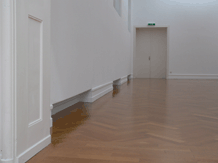
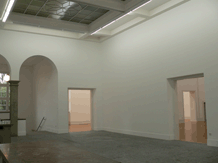
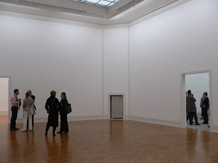
With VOIDS, EINE RETROSPEKTIVE the Kunsthalle Bern offers an opportunity to explore a crucial chapter in the history of art. Following Yves Klein’s exhibition at the Iris Clert gallery in 1958, the empty space became a recurrent artistic theme. This chronological retrospective exhibition brings together nine empty exhibitions by Yves Klein, Art & Language, Robert Barry, Robert Irwin, Stanley Brouwn, Bethan Huws, Maria Eichhorn, and Roman Ondák.
Yves Klein’s 1958 emblematic exhibition ‘The Specialization of Sensibility in Raw Material State into Stabilized Pictorial Sensibility’, which was subsequently referred to as The Void, is widely considered as a turning point in modern art history. The empty space exhibited as such thus became, in a way, a classic of radicalism, and would be repeated and remade in other contexts, other places and other times by other artists whose intentions might be similar, different or even opposed to Klein’s.
The principle of the exhibition at the Kunsthalle Bern is to present only exhibitions where the space is left rigorously empty, without the addition or subtraction of anything, thus excluding, for instance, shows or works involving the modification of lighting, the installation of sound, the construction of partitions or the exclusion of the public. And it is no part of its goal to reconstruct the original physical space, as rather than representing the historical void by the artists, the retrospective - working closely with the artist and their estate - considers the void itself, and not the architecture that hosted the void.
Also, all forms of historical documentation or memorabilia related to the original exhibition (such as posters, photos, invitations, photo-documentation, press reviews, original texts) are excluded from the exhibition; all such elements being included in the exhaustive catalogue published alongside the exhibition, edited by the curators John Armleder, Mathieu Copeland, Mai-Thu Perret, Clive Phillpot, Gustav Metzger, together with Laurent Le Bon and Philippe Pirotte.
Each void offers a different reading of the empty space, representing, perhaps, a claim, a renunciation, or, indeed, a celebration of the museum or gallery’s space. Contemplating emptiness, one confronts nothingness and absence, the invisible and the ineffable, destruction and negation. VOIDS are offered for what they are, and for what they allow. This accumulation of empty spaces, similar in appearance but radically different in reality, has echoes and implications beyond its walls. More than a radical and conceptual exhibition, the retrospective is an invitation to explore and experience, in a very physical manner, the different texture of each different space. The visitor encounters the empty exhibitions now in 2009, exactly 40 years after ‘When Attitude Become Form’ organised by Harald Szeeman when director of the Kunsthalle Bern. It was such exhibition that enabled this retrospective to be, and one could dream that with the voids, the attitudes, literally, are the forms.
This exhibition brings together the work of artists who have attempted this extreme gesture, to exhibit without showing an object, without making any intervention but a single announcement. The exhibition begins with Yves Klein’s 1958 exhibition, and from then on envisages how entirely empty exhibitions have defined different kinds of emptiness, sometimes as a means to signal sensibility as for Klein, sometimes as the peak of a conceptualist or minimalist practice as with Robert Barry’s ‘Some places to which we can come, and for a while “be free to think about what we are going to do (Marcuse)”’ (1970). Sometimes as the desire to explore our understanding of exhibition & exhibition spaces as for Art & Language’s ‘Air Conditioning Show’ (1966-67), or in the case of Robert Irwin’s ‘Experimental Situation’ (1970) as the appraisal of the space, and the affirmation that there is no such thing as nothing. Sometimes as the desire to empty an institution & focus on the experience of walking through it as for Stanley Brouwn, or with Laurie Parsons’ exhibition at the Lorence-Monk Gallery in New York in 1990, announced by a card bearing only an address, with neither dates nor the name of the artist, as a means to announce the artist’s complete withdrawal. Sometimes as the affirmation that there is no need to introduce in a space a work of art as it is already there, as with Bethan Huws’ ‘Haus Esters Piece’ (1993). And again as with Maria Eichhorn’s ‘Money at the Kusnthalle Bern’ who in emptying the Kusnthalle in 2001 worked with the void out of necessity, devoting the exhibition budget to the renovation of the building. And sometimes it is the means to remind us that the most important aspect of any void is the notion of trust and belief, as with Roman Ondak’s ‘More Silent Than Ever (room fitted with eavesdropping devices)’ (2006), a piece that deceives the public in making one believe that there is more when indeed there is nothing.
In this respect, from the search for a renewal of perception, through political or ideological statement, to the deconstruction of the very principle of exhibition, these exhibitions pose a range of crucial questions about the role of the institution, and this unprecedented marshalling of eloquent emptiness within the Kunsthalle Bern represents a true challenge to the institution.
For an unprecedented exhibition, a unique curatorial team. VOIDS, A RETROSPECTIVE, which is both an exhibition in the most traditional sense and an art event in its own right, has been put together by John Armleder, who has always been interested in nothing; Gustav Metzger, a key figure in auto-destructive art, Mai-Thu Perret, a young conceptual artist, Mathieu Copeland, a curator who explores the limits of the exhibition, Clive Phillpot, a writer; together with Philippe Pirotte, director of the Kunsthalle Bern.
Accompanying and simultaneously to the retrospective at the Kunsthalle Bern, the Museum Haus Lange, Krefeld, will be entirely empty and open to the public for a week (20th - 27th of September) as an invitation to visit Yves Klein’s ‘Raum der Leere’, a permanent void realized in 1961.
Accompanying events will also include an evening of performance by Ben Vautier, a screening of films curated by Stuart Comer, a discussion with Mr Jose Miguel Jimenez from CERN, a listening session by Francis Baudevin, and "Absenz - (k)ein konzert" a concert by Ensemble Neue Horizonte. For more information on dates and locations in Bern on all these events, please refer to www.kunsthalle-bern.ch.
VOIDS, EINE RETROSPEKTIVE is coproduced by the Centre Pompidou, Paris, and the Kunsthalle Bern.
Toutes les photographies © Céline Bertin
Friday 11 September 8pm: FLUXUS & NOTHING by Ben Vautier
Date: Friday, 11 September 2009
Time: 20:00 - 21:00
Location: Calvinhaus, Grosser Saal
Street: Marienstrasse 8
FLUXUS AND NOTHING by Ben Vautier
He recently told us that ‘Less is More, but I prefer Nothing’! It is therefore with great pleasure that we welcome Ben Vautier to realise a too rare performance by this Fluxus hero and ever so influential artist for an evening considering nothing and the void. Performing his own pieces intertwined with pieces taken from the extensive Fluxus repertoire, Ben creates a program that look into the apparent impossibility of doing nothing, and furthermore (or rather furtherless), doing nothing on stage. A fascinating event that will cast a beautiful light on what his mother used to tell him, that there is no such thing as nothing.
Ben Vautier was Born in Naples, Italy, on the 18 July 1935. He lives in Nice France.
--
Projecting the Void curated by Stuart Comer
Projecting the Void curated by Stuart Comer
This programme is a celebration and a critical consideration of the filmic void, a projection of possible impossibilities. An empty frame or an imageless film can attempt to articulate absence, but paradoxically they also call attention to the presence of the viewer, the materiality of the cinematic apparatus, and the space of projection. The films in the programme echo the notions of evacuation, destruction, emptiness and invisibility in the exhibition, Voids, Eine Retrospective. As relationships between sound, image, representation and film stock are gradually broken down, cinema is revealed as an exhibition space of its own, a set of celluloid ‘rooms’ whose flirtation with the matter of voids might generate its own unique and contradictory set of concerns.
--
Saturday 3rd of October : A discussion with Mr Jose Miguel Jimenez from CERN’s Vacuum, Surfaces and Coatings Group (TE/VSC)
--
Saturday 3rd of October : There Singularly Nothing by Francis Baudevin
Francis Baudevin’s Listening Session : There Singularly Nothing
Titled after a composition by Petr Kotik, There Singularly Nothing is a program curated by artist Francis Baudevin established through the medium of the recorded music. Articulated through Baudevin’s extensive collection of music, it considers openly the thoughts of the exhibition as an invatation to envisage the many possible echo of the voids. A program will be edited & given away whilst we will be invited to hearing recordings that envisages both the recorded silence, and musicians singing on silence!
Francis Baudevin was born in 1964 in Bulle, and lives in Lausanne.
--
Sunday 4th of October : « Absenz - (k)ein konzert » by Ensemble Neue Horizonte
« Absenz - (k)ein konzert » is a concert considering the void in music performed by the renowned Ensemble Neue Horizonte, and offers a reflection on what could be ‘silent music’. The concert will include pieces from John Cage, Dieter Schnebel, Toshiro Mayutumi, Peter Streiff, Roland Moser, Urs Peter Scheider, and again Mieko Shiomi.
--
Accompanying and simultaneously to the retrospective at the Kunsthalle Bern, the Museum Haus Lange, Krefeld, will be entirely empty and open to the public for a week (20th - 27th of September) as an invitation to visit Yves Klein’s ‘Raum der Leere’, a permanent void realized in 1961. for more information please go to: www.kunstmuseenkrefeld.de
"Infinite Mercy", Alan Vega's Retrospective at the Musée d'Art Contemporain de Lyon
15/05 - 02/08 2009
ALAN VEGA
INFINITE MERCY
15.05 > 02.08.09
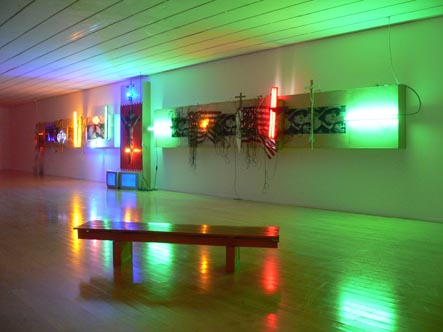
ALAN VEGA, CONNU POUR ÊTRE L’UN DES PIONNIERS DU ROCK ÉLECTRONIQUE MINIMALISTE, COFONDATEUR AVEC MARTIN REV DU GROUPE MYTHIQUE « SUICIDE » AU DÉBUT DES ANNÉES 70, EST AVANT TOUT UN ARTISTE PLASTICIEN ACTIF SUR LA SCÈNE ARTISTIQUE NEW-YORKAISE DÈS LA FIN DES ANNÉES 60.
En 1969, Alan Vega (né en 1938 à New York, où il vit et travaille) est l’un des fondateurs du « Projet des Artistes Vivants » (Project of Living Artists), un des premiers lieux alternatifs new-yorkais, tenu par des artistes et ouvert 24h/24. Dédié à toutes les formes d’art, aussi bien à la musique qu’au cinéma, ce lieu devient vite un tremplin pour un grand nombre d’artistes, tels que New York Dolls, Television et Blondie. Dans cet univers saturé, Alan Vega trouve un environnement idéal pour son oeuvre et poursuit simultanément sa carrière musicale et artistique. Il étudie avec Ad Reinhardt au Brooklyn College et se concentredans un premier temps, sur la peinture. À la fin des années 60, son intérêt se porte sur la lumière et il crée ses premières « light sculptures », assemblages d’objets divers composés d’ampoules, de câbles, de télévisions et de néons de toutes formes et couleurs.
/ LA PREMIÈRE FOIS QUE J’AI RÉALISÉ UNE « SCULPTURE LUMIÈRE » JE TRAVAILLAIS SUR UNE PEINTURE DE GRAND FORMAT DE COULEUR VIOLETTE. UNE SEULE AMPOULE ÉCLAIRAIT LA PIÈCE, ET COMME J’ALLAIS ET VENAIS, J’AI REMARQUÉ QUE LA PEINTURE PRENAIT DIFFÉRENTS ASPECTS. JE N’ARRIVAIS PAS À OBTENIR L’UNITÉ DE COULEUR QUE JE CHERCHAIS […], J’AI DÉCROCHÉ L’AMPOULE DU PLAFOND, ET JE L’AI LITTÉRALEMENT PLANTÉE SUR MA PEINTURE. CELA M’A OUVERT À L’IDÉE MÊME DE COULEUR, ALORS QUE JE VOULAIS LA CONTRÔLER, J’AI COMMENCÉ À VOIR À QUEL POINT LA LUMIÈRE POUVAIT MODIFIER UNE PEINTURE : C’EST LA LUMIÈRE QUI DÉTERMINE LA PEINTURE […]. DÈS QUE J’AI COMMENCÉ À TRAVAILLER AVEC L’ÉCLAIRAGE, J’AI UTILISÉ DE PLUS EN PLUS D’AMPOULES, À LA PLACE DE PIGMENTS. LES AMPOULES DE COULEUR SONT DEVENUES MA PROPRE PALETTE. /
Alan Vega
Anti-esthétique, anti-formelle, son œuvre embrasse la réalité contemporaine dans laquelle il évolue. Faisant fi de toute préciosité, pour l’une de ses toutes premières expositions à New York en 1972, Alan Vega récupère dans la rue les matériaux qui constitueront des éléments de son oeuvre et les présente dans la galerie. À l’issue de l’exposition, il les rend à leur réalité première, les retournant à la rue.
Composée d’un large corpus d’oeuvres créées depuis 1971, cette rétrospective présente un ensemble de sculptures lumineuses, dont les célèbres « crucifix », série initiée au début des années 80. Une version « monumentale » est créée spécifiquement pour l’exposition au Mac LYON.L’exposition présente également un large choix de peintures et plus d’une centaine de dessins exécutés au stylo-bille, totalement inédits :
/ JE DESSINE EXCLUSIVEMENT DES GENS, LES VISAGES M’INTÉRESSENT PLUS QUE TOUT LE RESTE. JE JETTE LA PLUPART DE MES DESSINS. IL FAUT QUE L’INSPIRATION VIENNE DE FAÇON NATURELLE. ELLE VIENT QUAND J’ÉCRIS DES CHANSONS OU DES POÈMES. IL FAUT JUSTE ESSAYER DE PLONGER AU PLUS PROFOND DE SOI-MÊME. POUR ÊTRE FRANC, JE DÉTESTE ÉCRIRE, ET CURIEUSEMENT, JE NE PEUX M’Y METTRE QU’À CONDITION DE DESSINER UN PORTRAIT. /
Alan Vega
Dans la logique de son travail de récupération et d’utilisation de matériaux préexistants, l’exposition comme les oeuvres, recycle, réintègre, un grand nombre de « matériaux » des expositions antérieures : verres, murs, structures…
/ MON ART, C’EST L’ART DE L’OBJET TROUVÉ, ET C’EST AUSSI DE LA RÉCUPÉRATION. /
/ IL NE S’AGIT PAS D’UN ART LISSÉ ET J’APPRÉCIE LE FAIT QU’ELLES SOIENT COMPOSÉES À PARTIR DE DÉCHETS OU DE REBUTS. /
Alan Vega
Légendes vivantes de l’histoire du rock et du punk, précurseurs avant-gardistes, avec Suicide, Alan Vega et Martin Rev sont les premiers musiciens rock à introduire systématiquement le beat millimétré de la batterie électronique dans leurs compositions. Alan Vega est cependant beaucoup moins connu comme artiste plasticien, c’est pourquoi, le mac LYON lui consacre ici, sa première grande exposition personnelle rétrospective, présentant plus de 40 ans de création et d’intensité.
Mathieu Copeland
ALAN VEGA, KNOWN TO BE ONE OF THE PIONEERS OF MINIMALIST ELECTRONIC ROCK AS THE CO -FOUNDER WITH MARTIN REV OF THE MYTHICAL BAND “SUICIDE”, IS FIRST AND FOREMOST A VISUAL ARTIST ACTIVE ON THE NEW YORK SCENE SINCE THE END OF THE 1960S.
In 1969, Alan Vega (born in 1938 in NY, where he still lives & works) was one of the founding members of the “Project of Living Artists”, one of the first alternative artist-run spaces in NY open 24/7. Dedicated to all forms of art, music and cinema, it quickly became a showcase for groups such as the New York Dolls, Television and Blondie. In this saturated universe, Vega found an ideal environment for his work, and pursued his musical and artistic careers in parallel. He studied with Ad Reinhardt at Brooklyn College, initially focusing on painting. Toward the end of the 1960s, his interests shifted toward light as he created his first “light pieces”— assemblages of diverse objects including bulbs, wires, televisions and neon tubes of every shape and colour.
/ THE FIRST TIME I DID A LIGHT PIECE WAS WHEN I WAS WORKING ON A VERY BIG PURPLE PAINTING. THERE WAS ONE LIGHT BULB IN THE ROOM, AND AS I WALKED AROUND I NOTICED HOW THE PAINTING ACQUIRED DIFFERENT ASPECTS. I WANTED IT TO BE ONE COLOUR, SO […] I TOOK THE LIGHT OUT OF THE CEILING AND REALLY STUCK IT ON THE PAINTING. THAT STARTED ME WITH THE WHOLE IDEA OF LIGHT BECAUSE I WANTED TO CONTROL THE COLOUR, BUT THEN I SUDDENLY BEGAN TO REALIZE JUST HOW MUCH LIGHT AFFECTS A PAINTING — ALL PAINTING IS ABOUT LIGHT. […] AS I STARTED WORKING WITH LIGHT, I STARTED GETTING MORE AND MORE INTO DIFFERENT COLOURS OF LIGHT INSTEAD OF USING PAINT. I STARTED USING LIGHT BULBS OF COLOUR THAT BECAME MY PAINT. /
Alan Vega
Anti-aesthetic, anti-formal, Vega’s work embraces the contemporary reality in which he is immersed. For one of his first exhibitions in New York in 1972, eschewing all preciosity, he looked to the streets for the materials that would become the elements of his work, and presented them in the gallery. At the end of the exhibition, he gave them back to their primary reality, returning these to the street.
This retrospective comprises a large corpus of works created since 1971. Presenting numerous light pieces from all periods, among them the famous series of “crucifixes” which Vega began in the mid-1980s, and a “monumental” version created specifically for the exhibition at the mac LYON.The retrospective also presents a large body of paintings, and more than a hundred ballpoint drawings that have not previously been exhibited :
/ I DRAW JUST PEOPLE. TO ME A FACE IS EVERYTHING ANYWAY. MOST OF THE DRAWINGS I THROW OUT. IT JUST HAS TO COME OUT WITHOUT THINKING […] WHEN I WRITE LYRICS, OR POETRY, IT COMES FROM MY MIND. IT’S JUST TRYING TO GET DEEP INTO YOURSELF. TO BE HONEST WITH YOU, I HATE WRITING, AND IRONICALLY THE ONLY WAY I CAN SIT DOWN AND WRITE IS IF I DRAW A PORTRAIT. /
Alan Vega
In the logic of Vega’s work, including the retrieval and re-use of pre-existing objects, it is not just the works, but the exhibition format itself, that recycles and reintegrates various “materials” from previous exhibitions : glass, walls, structures, etc.
/ MY ART IS AN ART OF THE FOUND OBJECT, AND IT’S ALSO THAT OF SALVAGE. /
/ IT’S NOT SMOOTHED-OUT ART, AND I APPRECIATE THE FACT THAT IT’S COMPOSED OF GARBAGE AND DISCARDED OBJECTS. /
Alan Vega
As living legends of rock and punk history, and avant-garde precursors with Suicide, Alan Vega and Martin Rev were the first rock musicians to systematically introduce electronic drums into their compositions. Alan Vega is however less well known as an artist, this is the reason why mac LYON proposes his first major solo retrospective, representing more than 40 years of creativity and intensity.
Mathieu Copeland
Dossier de presse Alan Vega - Infinite Mercy // Service presse Élise Vion-Delphin T +33 (0)4 72 69 17 25 // communication@mac-lyon.com
ALAN VEGA - INFINITE MERCY. Toutes les photographies © Céline Bertin, 2009
VIDES, Une rétrospective
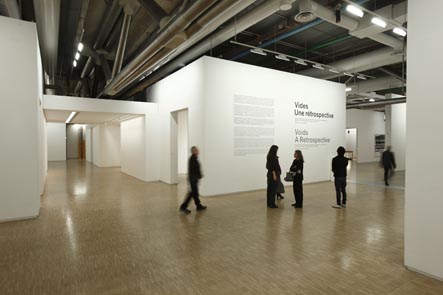
Manifestation exceptionnelle, « Vides » est une rétrospective des expositions vides depuis celle d'Yves Klein en 1958. Dans une dizaine de salles du Musée national d'art moderne, elle rassemble, de manière inédite, des expositions qui n'ont rigoureusement rien montré, laissant vide l'espace pour lequel elles étaient pensées.
L'idée d'exposer le vide est récurrente dans l'histoire de l'art de ces cinquante dernières années, au point d'être presque devenue un cliché dans la pratique artistique contemporaine. Depuis l'exposition d'Yves Klein La spécialisation de la sensibilité à l'état matière première en sensibilité picturale stabilisée à la galerie Iris Clert, à Paris, en 1958, les expositions entièrement vides affirment différentes conceptions du vide.
S'il est pour Yves Klein un moyen de signaler l'état sensible, il représente en revanche l'apogée de l'art conceptuel et minimal pour Robert Barry avec Some places to which we can come, and for a while "be free to think about what we are going to do." (Marcuse), [« Des lieux où nous pouvons venir, et pour un moment, ' être libre de penser à ce que nous allons faire '. (Marcuse) »], œuvre initiée en 1970. Il peut aussi résulter du désir de brouiller la compréhension des espaces d'expositions, comme dans l'œuvre The Air-Conditioning Show d'Art & Language (1966-1967), ou de vider une institution pour modifier notre expérience comme dans l'oeuvre de Stanley Brouwn.
Il traduit également la volonté de faire l'expérience des qualités d'un lieu d'exposition, comme pour Robert Irwin et son exposition réalisée à la ACE Gallery en 1970, ou pour Maria Nordman lors de son exposition à Krefeld en 1984. Le vide représente aussi une forme de radicalité, comme celui créé par Laurie Parsons en 1990 à la galerie Lorence-Monk, qui annonce son renoncement à toute pratique artistique. Pour Bethan Huws et son œuvre Haus Esters Piece (1993), le vide permet de célébrer l'architecture du musée, signifiant que l'art y est déjà présent et qu'il n'est pas nécessaire d'y ajouter des œuvres d'art. Le vide revêt presque le sens d'une revendication économique pour Maria Eichhorn qui, laissant son exposition vide à la Kunsthalle Bern en 2001, permet d'en consacrer le budget à la rénovation du bâtiment. Avec More Silent than Ever (2006), Roman Ondak, quant à lui, laisse croire au spectateur qu'il y a plus que ce qui est laissé à voir.
Comité Curatorial : John Armleder, Mathieu Copeland, Gustav Metzger, Mai-Thu Perret, Clive Phillpot.
Commissaire au Centre Pompidou: Laurent Le Bon
VIDES. Une rétrospective. Toutes les photographies © Centre Pompidou, Georges Meguerditchian, 2009
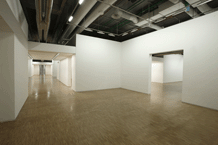
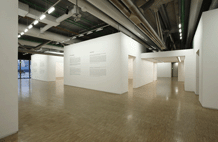
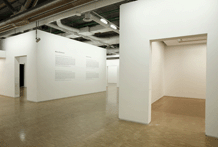
A Spoken Word Exhibition - Baltic, Newcastle Upon Tyne, opening Friday 16/01
A Spoken Word Exhibition
Friday 16 January – Sunday 15 March 2009
A Spoken Word Exhibition is composed of worded artworks (artworks only made of words to be spoken), to be read by BALTIC Crew members to visitors who ask to hear the pieces.
Acting as a voice when addressed throughout the building, the Crew repeat the words, sentences or paragraphs, the texts or haikus as written and instructed by the invited artists. Not performing, only using language through the act of reading, the works are available only on demand, initiating an exchange between visitors and BALTIC Crew.
The exhibition inhabits the realm of the spoken word, addressing the possibilities of art, memory & exhibition making. The exhibition is constituted of artworks that are to be spoken and exchanged as a verbal gesture from one person to another. Artworks that only last for the time it takes to read them, generating ultimately an exhibition that only lasts for the time it takes to listen.
A Spoken Word Exhibition is an exhibition of the same nature & material as that of the artworks that constitutes it, which are words. Contributing artists are Vito Acconci, Fia Backström, Robert Barry, James Lee Byars, Nick Currie (aka Momus), Douglas Coupland, Karl Holmqvist, Maurizio Nannucci, Yoko Ono, Mai-Thu Perret, Emilio Prini, Tomas Vanek, Tris Vonna-Michell, Lawrence Weiner, and Ian Wilson.
Please ask to hear the artworks.
An exhibition by Mathieu Copeland
Une Exposition Chorégraphiée
Avec Jonah Bokaer, Philipp Egli, Karl Holmqvist, Jennifer Lacey, Roman Ondak, Michael Parsons, and Fia Backstrom & Michael Portnoy. Interprétée par Le Clubdes5. Une exposition de Mathieu Copeland.
Une Exposition Chorégraphiée est une exposition composée exclusivement de mouvements. Pendant un mois et demi, six heures par jour, trois danseurs interprètent les partitions écrites par huit artistes. L’ensemble de ces partitions est orchestré par le commissaire d'exposition qui crée le déroulé général, sorte de mouvement chorégraphique ou musical à plusieurs thèmes.
En l’absence de décor, de lumière dramatique ou de musique, les gestes résonnent dans la galerie déserte. S’enchaînant dans un continuum sans fin, ils se déploient dans l’espace et dans le temps.
Les danseurs, tels des sculptures vivantes, concentrent toute l'attention, bouleversant le rapport au spectateur. La proximité troublante avec les interprètes, et leurs déplacements souvent imprévisibles, obligent à se mettre soi-même en mouvement, à se repositionner en permanence. Une exposition chorégraphiée invite à une expérience inédite de l'espace et de la durée. Elle se forme et se déforme sous nos yeux. Elle ne se fixe jamais sinon dans la mémoire.
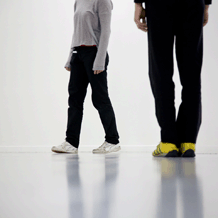
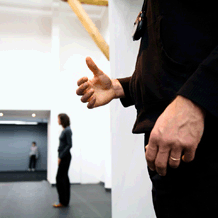
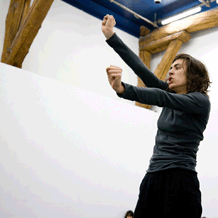
Photographies by T Caron
Le geste est notre état d’esprit / A gesture is our state of mind
Centre d'art de la Ferme du Buisson
Scène nationale de Marne-la-Vallée
Allée de la Ferme – Noisiel
77448 Marne-la-Vallée Cedex 2
tél : 01 64 62 77 00 / fax : 01 64 62 77 99
contact@lafermedubuisson.com
www.lafermedubuisson.com
Horaires
Vendredi, samedi, dimanche 14h-20h
Accès depuis Paris
RER A, dir. Chessy / Marne-la-Vallée, arrêt Noisiel (20 min)
Porte de Bercy, A4 dir. Marne-la-Vallée, sortie Noisiel-Torcy puis Noisiel-Luzard (15 min)
Le Centre d'art contemporain de la Ferme du Buisson bénéficie du soutien de la Drac Ile-de-France/Ministère de la Culture et de la Communication, du SAN Val-Maubuée et du Conseil Général de Seine-et-Marne. Il est membre des réseaux tram et d.c.a.
‘A Choreographed Exhibition’ is an exhibition curated by Mathieu Copeland and co produced by the Kunsthalle St Gallen (http://www.k9000.ch/) and La Ferme du Buisson (http://www.lafermedubuisson.com/).
L'exposition Continue
Une exposition de Mathieu Copeland pour 2 centres d’art (Circuit & 1m3) avec
David Cunningham,
On Kawara,
Charlemagne Palestine,
et des peintures de Birgir Andresson, Jean-Sylvain Bieth, Francis Baudevin, Michel Castaignet,
John Cornu, Philippe Decrauzat, Noel Dolla, Olivier Mosset, Christian Robert-Tissot, Evi Vingerling,
repeintes de la même couleur que le mur par Claude Rutault.
vernissage le vendredi 3 octobre à 18h
du 4 octobre au 22 novembre 2008
je-ve-sa de 14h à 18h et sur rendez-vous
Concert de Charlemagne Palestine
mercredi 1er octobre à 20h30, Eglise St-François, Lausanne
Concert de David Cunningham et Mika Vainio
samedi 4 octobre à 22h, Le Bourg, rue de Bourg 51, Lausanne
Lecture de One Million Years, On Kawara
chaque samedi à 16h durant l’exposition, Circuit, Lausanne
Lausanne, Switzerland
www.galerie1m3.com & http://www.circuit.li/
The Saints, and Music & Films by Amy Granat
With Fia Backström, Jutta Koether, Amy O’Neill, Mai-Thu Perret, Emily Sundblad, Stefan Tcherepnin, Angel Turner
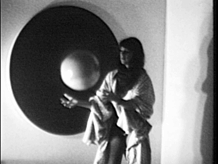
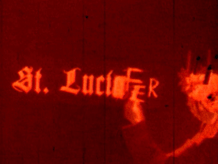
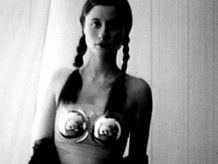
Opening the 26th of April, at 14.00, with ‘Emotional Music’ a performance with Amy Granat, Emily Sundblad and Stefan Tcherepnin.
The exhibition runs until the 14th of June 2008, 10am – 5pm
An exhibition curated by Mathieu Copeland
26 April to 14 June 2008
Sketch Gallery, London
9 Conduit Street
London, W1S 2XG, UK
Le Dojo, La Villa Arson et le laboratoire de mémoires présentent
Une exposition de mémoires
Une discothèque silencieuse
vernissage vendredi 2 mai à 18h
exposition du 3 mai au 9 mai 2008
Exposition collective de & avec BENJAMIN BICHARD, ANNA BYSKOV, ZORA CAHUSAC, MARION CHARLET, CAMILLE DEBRAY, ALYS DEMEURE, MAILYS D.PERRET, LOUP GANGLOFF, SOPHIE GRANIOU, LAURIE GERARDO, YASMINA HATEM, CINDY LELAURIN, SANDRA LORENZI, AURELIE MENALDO, MARYLINE M'GAIDES, STEPHANIE RAIMONDI, COLINE VECTEN, sur une proposition de MATHIEU COPELAND, avec NOËL DOLLA & PASCAL PINAUD
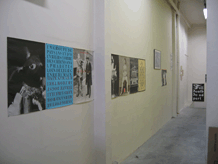
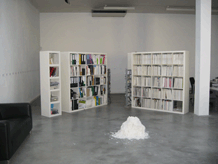
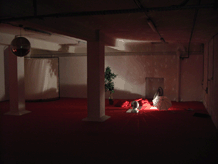
LE DOJO
22 bis bd Stalingrad
F-06300 Nice
Tel 04 97 08 28 14
Fax 04 97 08 28 19
www.le-dojo.org
info@le-dojo.org
A Spoken Word Exhibition / Mluvené slovo - TranzitDisplay Prague
18th of March - 20th of April 2008
A Spoken Word Exhibition - Tranzit/Display - 18th of March - 20th of April 2008
tranzitdisplay
resource centre of contemporary art / zázemí současného umění
cordially invite you / vás srdečně zve na
A Spoken Word Exhibition / Mluvvené Slovo
Vito Acconci, Robert Barry, James Lee Byars, Nick Currrie, Douglas Coupland, Karl Holmqvist, Maurizio Nannucci, Yoko Ono, Mai-Thu Perret, Emilio Prini, Tomáš Vaněk, Lawrence Weiner, Ian Wilson
a Series of Spoken Word Events will take place during the course of the exhibition
Spoken Word Events by King Mob (17. 4.), Susan Stenger (18. 4.), Karl Holmqvist (19. 4.) and Fia Backström (20. 4.)
please contact the gallery or visit the gallery website for more information / součástí výstavy je program živých vystoupení zúčastněných umělců
mimo jiné vystoupí Nick Currie aka Momus (18. 3.), Tomáš Vaněk (19. 3.), Boris Ondreička (10.4.), King Mob (17. 4.), Susan Stenger (18. 4.), Karl Holmqvist (19. 4.) and Fia Backström (20. 4.)
pro bližší informace prosím sledujte web www.tranzitdisplay.cz
Exhibitions view - far right still of INSTANT EXTRA+, a spoken word event by Fia Backström
A Choreographed Exhibition / Eine Choreographierte Ausstellung
With Jonah Bokaer, Philipp Egli, Karl Holmqvist, Jennifer Lacey, Roman Ondak, Michael Parsons, and Fia Backstrom & Michael Portnoy. An exhibition by Mathieu Copeland.
‘A Choreographed Exhibition’ is an exhibition only composed of movements. For over a month and a half, three dancers from the Tanzkompanie Theater St. Gallen are present in the kunsthalle during the opening hours to perform in space the choreography of movements, patterns and choreographed gestures, following the scores and instructions as provided by the invited artists, dancers, and choreographers.
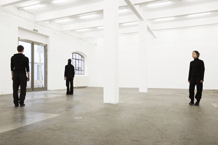
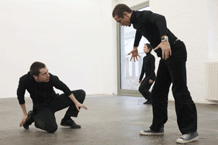
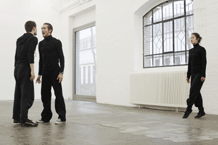
Photographies by Anna-Tina Eberhard
Le geste est notre état d’esprit / A gesture is our state of mind
Kunsthalle St Gallen, Davidstrasse 40, CH-9000 St. Gallen
Open from Wednesday until Sunday: Wed/Thur/Fri: 14-18 ; Sat & Sun: 13-17
‘A Choreographed Exhibition’ is an exhibition curated by Mathieu Copeland and co produced by the Kunsthalle St Gallen (http://www.k9000.ch/) and La Ferme du Buisson (http://www.lafermedubuisson.com/).
A Spoken Word Exhibition & A Series of Spoken Word Retrospectives
1st / 7th of November 2007
A Spoken Word Exhibition, and a Series of Spoken Word Retrospectives
Guest curator Mathieu Copeland presents “A Spoken Word Exhibition” at the Swiss Institute - NY. The exhibition consists of artworks repeated by the Institute‘s staff. By leaving the gallery space empty and making works available only on demand, an exchange is initiated between spectators and the gallery staff. An exhibition of the same nature & material as that of the artworks that it is constituted of, which are words. Artworks only spoken, exchanged as a verbal gesture from one person to another, generating ultimately an exhibition that only last the time it takes to hear it.
Artists contributing to “A Spoken Words Exhibition” include Vito Acconci, Robert Barry, James Lee Byars, Nick Currie (aka Momus), Douglas Coupland, Karl Holmqvist, Maurizio Nannucci, Yoko Ono, Mai-Thu Perret, Emilio Prini, Tomas Vanek, Lawrence Weiner, and Ian Wilson.
Through the artist’s voice and words, The Spoken Word Retrospectives present us with the whole of an artist’s career, generating a mental retrospective in the mind of the one who hears it, as said & seen by the artist. A spoken word retrospective begins with everything, and produces nothing more, only everything.
Artists contributing to “A Series of Spoken Words Retrospectives” include David Medalla and Gustav Metzger.
Swiss Institute [SI] - 495 Broadway 3rd Floor - New York NY 10012
Biennale d'art contemporain de Lyon, 19 septembre 2007- 6 Janvier 2008- artiste invitée Mai-Thu Perret avec 'An Evening of the Book'
www.biennale-de-lyon.org/bac2007/fran/
L’œuvre pensée pour la biennale par Mai-Thu Perret se trame avec en toile de fond ‘An Evening of the Book (une Soirée pour le Livre)’ (1924), une pièce de théâtre agit-prop. Mis en scène par Vitalii Zhemchuzhnyi, cette propagande pour le livre aux décors et costumes conçus par Varvara Stepanova s’organisait comme une expérimentation dans l’agitation artistique pour les masses par le livre avec des étudiants de l’Académie de l’Education Communiste. De plus, il est à noter le parallèle entre cette histoire et le présent livre d’histoire, autant formellement de par l’importance de leurs graphismes que dans cette volonté d’écrire au présent une histoire en cours. Tout comme ‘An Evening of the Book’ présente le conflit entre les héros des livres pré-révolutionnaire et ceux de la nouvelle révolution, les personnages sortant tous au fur et à mesure des pages d’un livre géant présent sur scène ; Cette biennale se matérialise dans un livre ou l’histoire de l’exposition devient l’histoire d’un livre d’histoire (d’histoires ?). Il nous reste à espérer que tout comme dans cette pièce des années vingt, l’écriture en cours voit la victoire revenir aux héros révolutionnaires.
Filmstills "An Evening Of The Book", © Mai-Thu Perret, 2007
Mai-Thu Perret’s installation ‘An Evening of the Book’ finds its origins in the agit-prop theatre piece ‘An Evening of the Book’ from 1924. Directed by Vitalii Zhemchuzhnyi, this propaganda for the book whose costume and set was designed by Varvara Stepanova was organised as an experimentation on mass artistic agitation through the book, with the students from the Communist Education Academy.
An exhibition with Loris Gréaud and Arnaud Michniak, by Mathieu Copeland
Hong Kong, Hong Kong City Hall, 14th of May - 27th of May 2007 - Launch : Sunday the 13th of May, 7.15, Agnes b Cinema / Hong Kong Arts Centre - Screening followed by a public discussion
exhibition views / vues d'exposition
The exhibition appears as a moment frozen in time. A place where the viewers constantly celebrate the opening of an exhibition in a gallery whose size is gradually reduced, and that in turn reduces the view over the city.
The first movement of the exhibition comes with the present DVD that acts as a catalogue. Widely available, it features two new-commissioned films by Loris Gréaud and Arnaud Michniak both filmed in Hong Kong. The film ‘Celador, un goût d’illusion’ by Loris Gréaud is an advertising for a candy that taste of illusion. The film by Arnaud Michniak “Sound take in a hospital” focuses on arrested moments in the midst of a city in constant movement.
The exhibition at the Hong Kong City Hall appears minimal, if not empty. The films realised for the exhibition are shown sporadically throughout the exhibition. Our experience in the gallery is somehow what we are told of these works. There, everything remains, but nothing is left. Nothing seems to happen. The only element that evolves throughout the exhibition is, paradoxically, the space itself. The art is simply everything else.
Film Stills
« Exhibitions’ Ruins / Emotional Landscapes »
« Tilfinningalandslag (rotnandi sýning) »
With / Sýningin er unnin á grunni verka frá eftirfarandi listamönnum
Birgir Andrésson, Stefan Brüggemann, Nicolas Garait, Loris Gréaud, Elin Hansdottir, M/M (Paris) & Gabriela Fridriksdottir, Gustav Metzger, Jeremy Millar, Francois Morellet, Olivier Mosset, & Claude Rutault.
An exhibition by / Sýningarstjóri Mathieu Copeland.
At the SAFN Collection / Í Safni; samtímalistasafni, Reykjavik, 17/03 – 12/05/2007
« Exhibitions’ ruins / Emotional Landscapes » is a discursive exhibition on the nature of exhibitions, or rather on what remains of exhibitions; Somehow a necrophagous & cannibal exhibition – not only is this exhibition composed of remains, or fragments, of exhibitions, but it feeds itself from these.
The artworks are as many autonomous elements that articulate themselves around their past histories, past moments of exhibitions. Assembled, they generate an exhibition constituted of elements that fundamentally belongs to itself, literally creating its support structure.
To use a common analogy, as opposed to the idea of a ghost, here we only deal with a shell, the rests of a decomposing corpse. Here the exhibition is constituted of remains, here only the exhibition remains. An exhibition that becomes the shadow of a corpse, the corpse becoming its form. Similar to a constant expectation, this temporary recreation of diverse exhibitions uses bribes of the past as as-many fundamental elements for an exhibition to come. Similarly to decomposition being an active process, the artworks that compose the exhibition are as many invitations to engage with the landscape they contributed, and contribute, to form.
These emotional landscapes, these artworks are somehow referent to imaginary (or extinguished) landscapes. These environments emotionally charged refer to the creation of abstract environments, landscapes that reveals themselves as we are presented with them. Illusory as they are personal and mental, these moments characterise all the reactions that we experience when confronted to this temporary grouping of art works (an exhibition) – artworks that constitute an exhibition that embodies itself in the mind of the one who sees it. Each artwork draws a part of the environment of an exhibition, and further more offers an environment in itself.
“The Movement of People Working”
An exhibition of the films by Phill Niblock,
Curated by Mathieu Copeland
Images © Phill Niblock
AN INTERVIEW WITH PHILL NIBLOCK (22/11/2006)
The opening on January 20th featured flautist/bassist Susan Stenger (Band Of Susans/Big Bottom) and guitarist Robert Poss (Band Of Susans), long-time performers of Niblock's music, playing 4 pieces (some of which were composed especially for them).
Sketch Gallery, London, 20th of January until the 10th of March 2007.
IT IS WITH GREAT PLEASURE THAT WE ANNOUNCE THE LAUNCH OF THE SHOW TITLES WEBSITE. ACCOMPANYING THE EXHIBITION ‘THE TITLE AS THE CURATOR’S ART PIECE’, AN EXHIBITION THAT USES ONE OF THE SHOW TITLES WRITTEN BY MEXICAN BORN, LONDON BASED ARTIST STEFAN BRÜGGEMANN, THIS WEBSITE OFFERS THE POSSIBILITY TO VIEW, AND TO HEAR, ALL 728 SHOW TITLES WRITTEN TO DATE.
THE SHOW TITLES IS A WORK IN PROGRESS BY STEFAN BRÛGGEMANN OF TITLES FOR EXHIBITIONS. FREELY AVAILABLE, THESE ARE TO BE USED AS ONE WISH. WITHOUT ANY NEED TO ASK FOR ANY AUTHORISATION, THESE ARE TO BE USED AS THE SHOW TITLE, AND CREDITED AS AN ART PIECE BY STEFAN BRÛGGEMANN (SHOW TITLE, #XXX BY STEFAN BRÜGGEMANN). A COPY OF THE INVITATION CARD, AND ANY PRINTED MATERIAL, IS TO BE SENT TO THE FOLLOWING ADDRESS: SHOWTITLES, FLAT 3, 84 BLACKFRIARS ROAD, SE1 8HA, LONDON, UK.
Online now.
The title as the curator's art piece* A summer Show by Mathieu Copeland
A painting exhibition with Jaroslaw Flicinski & Claude Rutault
A spoken word exhibition with Douglas Coupland, Nick Currie (aka Momus), Karl Holmqvist, Tomas Vanek, Lawrence Weiner & Ian Wilson
*Show title #347, by Stefan Brüggemann
Exhibition running from the 21st of June until the 2nd of September
Blow de la Barra, 35 Heddon Street, London W1B 4BP
Tel + 44 (0) 2077347477 info@blowdelabarra.com
A publication accompanies the exhibition featuring discussions with artist and musician Nick Currie (aka Momus), curator Raimundas Malasauskas, and artist Claude Rutault.
Soundtrack composed by/composée par Susan Stenger [Band of Susans] with contributions by/avec des contributions de Robert Poss [Band of Susans] , Alan Vega [Suicide], Alexander Hacke [Einstürzende Neubaten], F.M. Einheit [ex Einstürzende Neubaten], Kim Gordon [Sonic Youth], Mika Vainio [Pan Sonic], Bruce Gilbert [Wire], Ulrich Krieger, Warren Ellis [The Dirty Three, The Bad Seeds], Jim White [The Dirty Three], Jennifer Hoyston [Erase Errata], Andria Degens (Pantaleimon), Spider Stacy [Pogues]
Paintings by/Peintures par John Armleder, Steven Parrino
Feature film by/Film par Kristian Levring
An exhibition by/Une exposition de Mathieu Copeland
Exhibition View / Vues d'exposition :
Soundtrack for an Exhibition comprises three main elements: a specially commissioned sound
score, an exhibition of paintings and a feature film. The soundtrack is broadcast both inside and
outside of the museum for 96 days, whilst the paintings and feature film are presented in the
gallery space for 69 days.
The sound piece, composed by Susan Stenger and featuring contributions from a stellar list of
international musicians, employs an archetypal pop song structure ‘exploded’ in form to last 96
days.
During this period a feature film [The King Is Alive, by Danish filmmaker and Dogme95 signatory
Kristian Levring], screened not in its final, edited version, but as the entire footage shot in its
making - will be shown in the gallery. Presented alongside in the gallery space will be an
exhibition of paintings, including the late American painter Steven Parrino’s Slow Rot works and
large scale commissioned Puddle Paintings and Pour Paintings realised in situ by Swiss artist
John Armleder – all unstable paintings that both evolve and decay over time.
It is in the confrontation of these exhibition components with the soundtrack and with each
other that this project is essentially defined: not as a singular experience, but as a score evolving
over time. Whilst the soundtrack lasts 96 days, the film and paintings are presented for only part
of this period, thus the sound piece exists and evolves as a soundtrack for an exhibition, for a
film, or again for an empty space.
soundtrack for an Exhibition (fr - eng) - 8th March until 11th June 2006 - Musée Art Contemporain Lyon
EA C / Expat Art Centre is an ongoing exhibition that takes place when the art centre, the museum... is closed, inserting itself between two exhibitions. With Brian Eno, Pierre Huyghe, Ben Kinmont, Claude Leveque, Didier Marcel, Olivier Mosset, Shimabuku, Dan Walsh, Ian Wilson.
An exhibition by Mathieu Copeland
Exhibitions Views / Vues d'expositions :
Exhibitions Views: ICA London, Musée Art Contemporain Lyon, Muzeum Sztuki Lodz, CAC Contemporary Art Centre Vilnius, Kunstihoone Tallinn. © The Artists & Mathieu Copeland.
Expat-art Centre / EA C
An exhibition happening everywhere, at all times, with everyone.
Expat-Art Centre / EA C is an exhibition that takes place when the galleries of an art institution, i.e. a museum or an art centre are closed. It takes place in the time that follows the closure of an exhibition leading to the installation of the following one, or during those moments of inaction dictated by financial circumstances, refurbishment or other reasons.
EA C bears all the constitutive parameters that define an exhibition, yet altering only one when in switching the context of space to non space. This curatorial model simultaneously becomes both an exhibition in a moment of time and an exhibition of a moment of time, situated in the in-between; the in-between of times, of spaces as well as the in-between of exhibitions and venues.
Ian Wilson's work, 'There was a discussion' (2004), could literally signify this schism - the interstice between time and exhibition - as a result of passing discussions, encompassing several continuums such as the discussion between two exhibitions within this momentary pause, and the passing discussions throughout Wilson's career who in 1968 hailed discussion as his art form. This inbetween becomes the social and democratic interstice of art production and the reintroduction of a moment of conviviality in a cold economic factor.
EA C does not only take the usual and pre-formatted exhibition calendar of an exhibition venue (inward look) into consideration, but the entire system that is created by the multitude of institutions (outward look). EA C is both the negative of the exhibition calendars and schedules as well as the exponential accumulation of previously unused time.
'Exhibition like Moon' (2004), to borrow the title of Shimabuku's contribution to the exhibition, EA C is an exhibition whose path mirrors that of the moon. In the empirical believe that we will see the moon the following night, this exhibition has the potential to simultaneously be everywhere, travelling the globe, becoming an exhibition happening everywhere, at all times, with all people. This in turns echoes beautifully with how Brian Eno envisaged his piece for EA C, 'a self generative art work travelling the globe'.
Since EA C is self contained and generative, portraying the model of an exponential exhibition, the outcome is easily identifiable. Since this is an exhibition that happens when the art institution is closed, as such it only exists in this form through the work of the artists, and only the ignition of the process will enable its permanent movement. An exhibition of time with no date, of place with no space.
Artist Pierre Huyghe reintroduces the notion of time and locality, characterising the moment in which this exhibition takes shape. In each of the subsequent venues, a local newspaper cover will be stripped bare of its entire contents, with only the dates of the exhibition remaining, and an indication of the idea of the location through the name of the newspaper. While Huyghe models the remaining shred that defines this exhibition (time and location), in his work 'This isn't it' (2004), the artist Ben Kinmont leaves the art institution with only a trace of evidence that an event has taken place. Visitors are then invited to sign up to a subscription of photographs taken of each occurrence of the same event in subsequent venues. Ultimately only the accumulation of Pierre Huyghe's newspaper front covers, and the cumulative publication co-ordinated by Kinmont, will reveal the time and place that constitute the exhibition.
In equally considering the monochrome, the sign and the motif, Olivier Mosset considers painting in an environment denying paint. In stacking two model chairs one on top of the other in an environment denying space, Didier Marcel has created both an abstract drawing and a model that reflects the status of the closed art institution. Claude Lévêque, in his piece 'Elise Van Elise' (2004), has conceived the 'unifying factor' of an exhibition. Through an economy of means, Lévêque presents us with the artificial recreation of a space.
Dan Walsh's glass panel will gradually crack and break over time though its longevity will be sustained, as through each presentation it will decay and disappear, enabling its permanent existence. This combined with its inherent transparency offers a beautiful parallel to the thinness and fragility of an exhibition simply defined by two moments in time.
By Mathieu Copeland
PDF Leaflet of the exhibition
ICA London - English
Musée d'Art Contemporain Lyon - Francais
Muzeum Sztuki - Polish
CAC - Lithuanian
Kunstihoone - Estonian
Bizart - Chinese
David Cunningham / Sebastien Roux
Wall paper music - Sebastien Roux (LOT Bristol)
Exterior - David Cunningham (AA London)
Meanwhile... across town - Cerith Wyn Evans
Meanwhile... across town - Cerith Wyn Evans (Centre Point London)
"Meanwhile…across town", by Cerith Wyn Evans, permeated the centre of London with a Morse code message transmitted from the neon signs of the landmark Centre Point Tower on Oxford Street. Produced by Forma and curated by Mathieu Copeland, witnessed by hundreds of thousands of people who see the Centre Point Tower from across London every day, Wyn Evans used the letters 'o' and 'i' from Centre Point's signs to transmit an extract from The Visible and the Invisible, an unfinished book by the French existentialist philosopher, Maurice Merleau-Ponty [1908-1961]. The building may be seen as a host organism infected with a virus - the code of a dying language that has taken up temporary residence. The text became buried in the urban landscape, where the pulsating narrative of the Morse code signal might even suggest that every other flashing light might be beaming out its own story.
This invasion of the social fabric of the City was at the core of the artist's intentions. "Meanwhile…across town" appeared as an elegant and subtly perverse way of pointing to no more than the communication itself; through the archaic communication tool of Morse code, broadcasted across town, its message became, ultimately, temporarily, an intrinsic part of the cityscape.
14 Feb – 31 Mar 2004 | Centre Point Tower, London, UK
An exhibition by Mathieu Copeland
Phill Niblock – Nothing but working
Edited, written and designed by Mathieu Copeland
Published by Verlag der Buchhandlung Walther und Franz König
April 2023
165 x 220 mm
112 pages
185 image
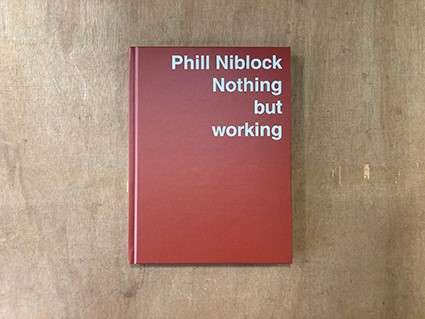
One of the great experimental composers of our time, Phill Niblock has during his sixty-year career produced minimalist music, structural cinema, dance performance, improvised theatre, systematic art, and ethnographic photography.
Since 1985, Niblock has served as director of Experimental Intermedia, a foundation for avant-garde music based in New York, and curator of the foundation’s record label XI.
This catalogue is devoted to Niblock’s wide intermedia art, including his masterpieces the Six Films (1966-69), the Environments (1968-72) and The Movement of People Working (1973-91).
A thorough publication that includes Charles Mingus, Billy Strayhorn and Duke Ellington, Elaine Summers, Yoko Ono, Sun Ra, The Open Theatre, Muna Tseng and Arthur Russell.
www.buchhandlung-walther-koenig.de
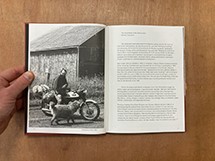
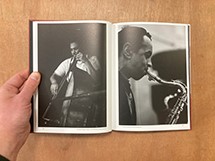
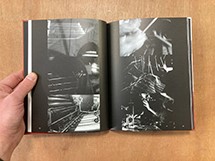
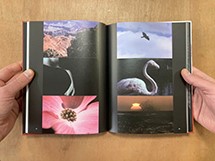
--LAUNCH @ CENTRE POMPIDOU, PARIS--
Projection and discussion
Phill Niblock
Environments
19 Apr 2023
À l’occasion de la parution du catalogue Phill Niblock. Nothing but working (Walther Koenig, 2023), le compositeur américain rencontre le commissaire d’expositions Mathieu Copeland pour discuter de la place de l’image en mouvement dans son œuvre.
À partir de 1968, Phill Niblock commence à expérimenter en combinant des productions visuelles et des partitions musicales pour créer des compositions architecturales et environnementales, qu’il nomme les « Environments ». Le premier des Environnements est présenté à la Judson Church de New York en décembre 1968, suivi, entre 1969 et 1972, de trois autres, conçus comme une série d'événements de « théâtre non verbal » avec danse, musique et films. Chacun des Environnements consiste en une chorégraphie de projections de films et de diapositives, entrecoupées par l’intervention de danseurs exécutant des mouvements simples. Décrivant l’événement pour les lecteurs du Village Voice, Jonas Mekas écrit à propos de Environments II que ce dernier « présentait des mouvements et des images contenant de l'énergie vitale à l’état presque pur ». Pour son collègue compositeur Gordon Mumma, la série Environments produisait « un son massif sans la moindre trace de geste musical », conduisant selon ses termes à une forme de « cinéma lyrique ».
Pour chaque événement, Niblock extrait la réalité d'un territoire donné et, avec ses collaborateurs, génère un environnement temporaire dense d'images projetées, de musique et de mouvement à l'intérieur d'un espace de performance ou de musée. Ten Hundred Inch Radii/Environment IV, dont le film est présenté lors de cette séance au Centre Pompidou, pousse à son paroxysme ce format, en y rendant la nature plus abstraite « par la proximité de l’image, par l'exclusion de l’arrière-plan, et surtout par la façon dont [il] utilise la lumière » comme le souligne le compositeur. Présenté pour la première fois les 8 et 9 Avril 1972 au Everson Museum of Art de Syracuse (NY), Ten Hundred Inch Radii/Environment IV (aussi intitulé THIR) a été tourné en utilisant uniquement une lumière directe et naturelle. Elle devient pour Niblock autant le sujet du film que les fleurs et les insectes, les montagnes et les ruisseaux.
Programme :
Ten Hundred Inch Radii/Environments IV, 1972, film 16 mm (numérisé), couleur, sonore, 43 min
La projection est suivie d’une signature.
La séance se prolonge aux Instants Chavirés, le 21 avril 2023 à 21h, avec un concert de Phill Niblock et Katherine Liberovskaya. NuDaf, sa pièce de 65 minutes pour basson composée pour et interprétée par Dafne Vicente-Sandoval, est présentée en première mondiale accompagnée de Sumatra 1990, une œuvre film/vidéo, nouvellement éditée et encore inédite en Europe
Remerciements : Phill Niblock, Mathieu Copeland, Laurent Ligavant et l’association La Fabrique Agitée, ainsi que les équipes de La librairie du Centre Pompidou.
Phill Niblock (1933, vit à New York) a produit, au cours de ses soixante ans de carrière,une œuvre musicale minimaliste et son équivalent visuel au travers d’un cinéma structurel, de performances de danse, du théâtre improvisé, d'art systématique et de photographie ethnographique. Depuis 1985, Niblock est directeur d’Experimental Intermedia, une fondation pour la musique d’avant-garde installée à New York, et directeur artistique du label de la fondation XI.
Philippe Decrauzat–DELAY
Edited by Mathieu Copeland
Published by Verlag der Buchhandlung Walther und Franz König
Designed by Inge Ketelers
January 2022
225 x 300 mm
448 pages
1280 images
Authors: Jimena Canales, Mathieu Copeland, Philippe Decrauzat, Lydie Delahaye, Genesis Breyer P-Orridge, Michel Gauthier, Peter Kubelka, Tan Lin, Joaquim Moreno, Bob Nickas, Arnauld Pierre, Jonathan Pouthier, Peter Saville
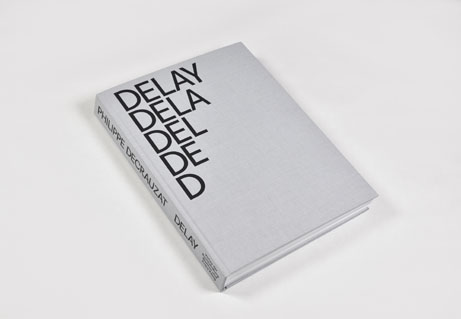
“Decrauzat’s work can be understood as the unique encounter between a form of ‘referential abstraction’ and a ‘self-reflexive optics’. As such, it is necessary to understand the reexamination that it henceforth carries out. When abstract painting referred to itself, as Greenberg desired, or when it referred to vision, as with optical kinetics, it did not look to an external referent; and when it was referential or citational, as with appropriation art, it was neither meta-pictorial nor metascopic. In other words, the juxtaposition that Decrauzat creates in his art is rare and the effects of the two logics at work remain to be evaluated.”
–Excerpt from Michel Gauthier’s Histories of the Autoscope, published in the publication
“The relationships between catalogue and exhibition, book and artist, monograph and oeuvre, underpin this structuralist, minimalist, repetitive, and systematic study, presented here as a distant echo of an ongoing oeuvre. The Delay posited by Philippe Decrauzat, a recurrent motif in his work, goes hand in hand with the urge to create a monograph that thinks through and extends the origins of the work itself.”
–Excerpt from Mathieu Copeland’s introduction, published in the publication
This important book is not an ordinary monograph publication but was thought of as a tool allowing both to apprehend the work of Philippe Decrauzat, but also and above all, to deepen the research fields and themes that the Swiss artist summons or evokes. Edited by Mathieu Copeland, author of numerous exhibitions and publications, and published in English and French by König Books, this book is the first major publication devoted to the work of Philippe Decrauzat. It presents a series of original texts by Jimena Canales, Lydie Delahaye, Genesis Breyer P-Orridge, Michel Gauthier, Peter Kubelka, Tan Lin, Joaquim Moreno, Bob Nickas, Arnauld Pierre, Jonathan Pouthier and Peter Saville, as well as an important iconography of the artist’s films, paintings, installations and sculptures from the past fifteen years.
www.buchhandlung-walther-koenig.de
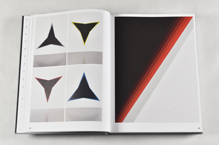
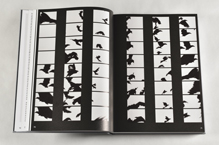
Philippe Decrauzat (Lausanne – Switzerland, 1974) is co-founder of the contemporary art centre CIRCUIT in Lausanne. He is a professor at the Ecole Cantonale d'Art de Lausanne (ECAL). His work has been the subject of numerous solo exhibitions including: Portique regional center for contemporary art in Le Havre, 2021–2022; Blueproject Foundation, Barcelona 2019; Le Magasin, Grenoble, 2014; Le Plateau/Frac Ile-de-France, Paris, 2011; Musée Cantonal des Beaux-Arts, Lausanne, 2010; Museum Haus Konstruktiv, Zürich, 2009; Secession, Vienna, 2008; Centre d’art contemporain Genève, 2006; Mamco, Geneva, 2005. It has also been shown in numerous group exhibitions, notably at the Kunsthaus in Zürich, at the Grand Palais in Paris, at MoMA New York and at the Musée d'Art Moderne de la Ville de Paris. His works are in numerous public and private collections including the Albright-Knox Art Gallery in Buffalo, Musée d’Art Moderne Centre Georges Pompidou in Paris, MoMA New York, Musée d’Art Moderne de la Ville de Paris, Kunsthaus Zürich, Kunsthaus Aarau, MAMCO in Geneva and Musée Cantonale des Beaux-Arts de Lausanne. The laureate of numerous prizes including the 2018 Aurélie Nemours Prize, Philippe Decrauzat is nominated for the 2022 Marcel Duchamp Prize.
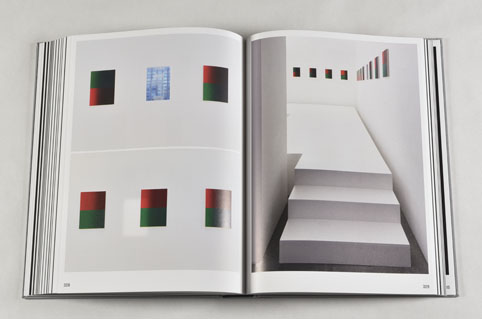
Philippe Decrauzat - DELAY
sous la direction de Mathieu Copeland
publié par Verlag der Buchhandlung Walther und Franz König
designé par Inge Ketelers
date de parution: janvier 2022
225 x 300 mm
448 pages
1280 images
Auteurs: Jimena Canales, Mathieu Copeland, Philippe Decrauzat, Lydie Delahaye, Genesis Breyer P-Orridge, Michel Gauthier, Peter Kubelka, Tan Lin, Joaquim Moreno, Bob Nickas, Arnauld Pierre, Jonathan Pouthier, Peter Saville
« L’oeuvre de Philippe Decrauzat se présente comme la singulière rencontre d’une abstraction référentielle et d’une optique autoréflexive. Il faut prendre la mesure de la redistribution qui ainsi s’opère. Quand la peinture abstraite s’occupait d’elle-même, comme le souhaitait Greenberg, ou quand elle s’intéressait à la vision, comme avec l’optico-cinétisme, elle ne cultivait pas les références externes. Et quand elle était référentielle, citationnelle, comme chez les appropriationnistes, elle n’était ni méta-picturale, ni méta-scopique. En d’autres termes, la conjoncture créée par l’art de Decrauzat n’est pas commune et les effets du croisement des deux logiques à l’œuvre restent à mesurer. »
– Extrait du texte de Michel Gauthier, Les Histoires de l’autoscope, publié dans l’ouvrage
« Le rapport du catalogue à l’exposition, du livre à l’artiste, de la monographie à l’œuvre, est la base de la construction de cet ouvrage structuraliste, minimaliste, répétitif et systématique, qui se présente comme un écho distant d’une œuvre en cours. Ce delay affirmé par Philippe Decrauzat, et qui est en soi un motif récurrent de son travail, va de pair avec la volonté de proposer un outil monographique qui pense et prolonge les origines même de l’œuvre. »
– Extrait de l’introduction de Mathieu Copeland, publié dans l’ouvrage
Cette importante publication n’est pas un catalogue monographique ordinaire mais a été pensée comme un outil permettant à la fois d’appréhender le travail de Philippe Decrauzat, mais aussi et avant tout, d’approfondir les champs de recherche et les thématiques que l’artiste suisse convoque ou évoque. Dirigé par Mathieu Copeland, auteur de nombreuses expositions et publications, et publié en anglais et français par König Books, ce livre constitue le premier ouvrage d’envergure consacré à l’œuvre de Philippe Decrauzat. Il présente un ensemble de textes inédits de Jimena Canales, Lydie Delahaye, Genesis Breyer P-Orridge, Michel Gauthier, Peter Kubelka, Tan Lin, Joaquim Moreno, Bob Nickas, Arnauld Pierre, Jonathan Pouthier et Peter Saville, ainsi qu’une importante iconographie des films, peintures, installations et sculptures de Philippe Decrauzat des quinze dernières années.
www.buchhandlung-walther-koenig.de
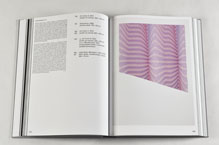
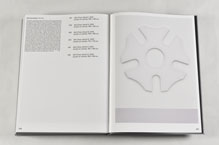
Philippe Decrauzat (Lausanne, 1974) est co-fondateur de l’espace d’art contemporain CIRCUIT à Lausanne et professeur à l’École Cantonale d’Art de Lausanne. Son travail a fait l’objet de nombreuses expositions personnelles dans des centres d’art et musées dont : Portique centre régional d’art contemporain du Havre (2021-2022) ; Blueproject Foundation, Barcelone (2019) ; Le Magasin, Grenoble (2014) ; Le Plateau/Frac Île-de-France, Paris (2011) ; Musée Cantonal des Beaux-Arts, Lausanne (2010) ; Museum Haus Konstruktiv, Zürich (2009) ; Secession, Vienne (2008) ; Centre d’art contemporain, Genève (2006) ; Mamco, Genève (2005). Ses œuvres ont également été présentées dans de nombreuses expositions collectives, notamment au Kunsthaus à Zürich, au Grand Palais à Paris, au MoMA à New York et au Musée d’Art Moderne de la Ville de Paris, et sont dans de nombreuses collections privées et publiques dont le Albright-Knox Art Gallery à Buffalo, le Musée national d’Art moderne Centre Georges Pompidou à Paris, le MoMA à New York, le Musée d’Art Moderne de la Ville de Paris, le Kunsthaus à Zürich, le Kunsthaus à Aarau, ou encore le MAMCO à Genève et le Musée Cantonale des Beaux-Arts à Lausanne. Lauréat de nombreux prix dont le prix Aurélie Nemours (2018), Philippe Decrauzat est nominé pour le prix Marcel Duchamp 2022.
MARIE-HÉLÈNE LEBLANC, JENNIFER LACEY, LÆTITIA SADIER, MATHIEU COPELAND
DIGRESSIONS 10
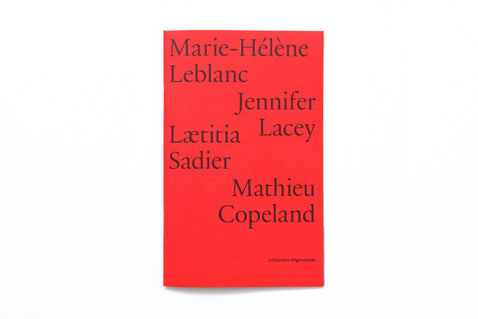
La collection Digressions accueille son dixième opus à l’occasion de la première de Une exposition mise en scène, samedi 11 septembre au théâtre de La Ferme du Buisson. Mathieu Copeland, commissaire d’exposition, questionne la signification de ce qu’il nomme « chorégraphier l’exposition » au fil de trois conversations avec Marie-Hélène Leblanc, commissaire, Jennifer Lacey, chorégraphe et Lætitia Sadier, musicienne. Envisageant la porosité des frontières entre les arts dits « plastiques » et ceux de la scène, au-delà d’une forme ou d’un vocabulaire dicté par l’espace d’un lieu, Mathieu Copeland poursuit ici sa réflexion sur la nature même de l’exposition qu’il transpose à la scène, le temps d’un spectacle. Se délestant de la réalité physique de l’objet, l’exposition existe uniquement par le prisme de l’expérience vécue par le·la spectateur·rice.
Un libretto est également édité par Mathieu Copeland en partenariat avec La Ferme du Buisson et Captures éditions. Il rassemble les retranscriptions des textes des treize artistes invités : Art & Language, Fiona Banner aka The Vanity Press, Robert Barry, Luis Camnitzer, Braco Dimitrijević, Coco Fusco, Giovanna, Joseph Grigely, Swetlana Heger, Florence Jung, Ghislaine Leung, David Medalla and Michael Portnoy dont les œuvres rêvées, réelles ou disparues sont interprétées par Jennifer Lacey et Lætitia Sadier sur un fond de scène de Gaylen Gerber.
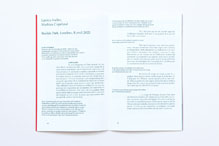
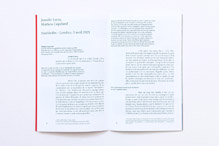
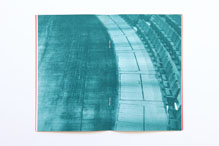
MARIE-HÉLÈNE LEBLANC, JENNIFER LACEY, LÆTITIA SADIER, MATHIEU COPELAND
DIGRESSIONS 10
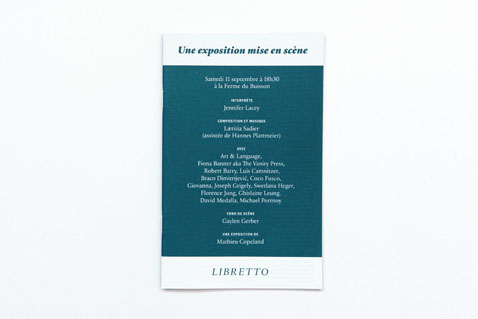
The Digressions series welcomes its tenth opus with A Staged Exhibition, which finds curator Mathieu Copeland delving into “choreographing exhibitions” in conversations with curator Marie-Hélène Leblanc, choreographer Jennifer Lacey and musician Lætitia Sadier.
In considering the porosity of the boundaries between the so-called plastic arts and the performing arts, and transcending the forms and vocabularies dictated by the space of an exhibition venue, Mathieu Copeland continues his probing of the very nature of the exhibition….”le temps d’un spectacle”…Dispensing with the physical reality of the object, the exhibition exists solely through the prism of the spectator’s experience. In partnership with La Ferme du Buisson and Captures éditions, Mathieu Copeland is also publishing a booklet containing transcriptions of the texts of the 13 guest artists – Art & Language, Fiona Banner aka The Vanity Press, Robert Barry, Luis Camnitzer, Braco Dimitrijević, Coco Fusco, Giovanna, Joseph Grigely, Swetlana Heger, Florence Jung, Ghislaine Leung, David Medalla and Michael Portnoy – whose dreamed, real or vanished works are interpreted by Jennifer Lacey and Lætitia Sadier against a backdrop by Gaylen Gerber.
In partnership with the Galerie UQO – Université du Québec en Outaouais and with the support of Fluxus Art projects
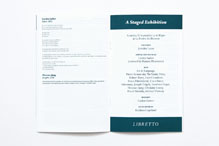
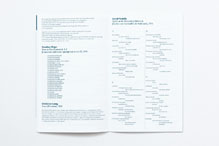
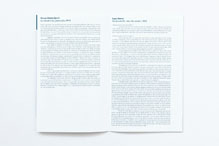
Writings (1953-2016)
Gustav Metzger
Mathieu Copeland (ed.)
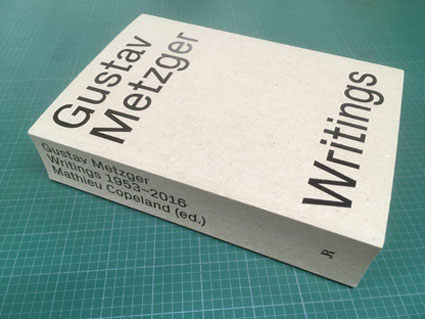
Bringing together more than 180 texts written between 1953 and 2016, this comprehensive volume establishes artist and activist Gustav Metzger as a towering figure of the 20th century, a long-overdue recognition of the artist's influential vision. Renowned for his use of unstable materials and chemical reactions to create artworks that embody processes of change, destruction, and renewal, Metzger was also a prolific writer, theoretician, and satirist. His interest in technology and science lead him to create such concepts as auto-destructive and auto-creative art—terms he coined with his manifestos on “Auto-Destructive Art” in 1959 and “Auto-Creative Art” in 1961. He put these ideas into action with artworks made to decay, desintegrate, or change following natural processes.
Edited by Gustav's long-time friend and curator Mathieu Copeland, this anthology of writings makes Metzger's key thinking from the 1950s onward available to a wide audience. It includes seminal writings such as his manifestos of auto-destructive and auto-creative art (1959 and 1961), “On Random Activity in Material/Transforming Works of Art” (1964), “The Possibility of Auto-Destructive Architecture” (1966), his inspiring interview with R. Buckminster Fuller from 1970, “The Artist in the Face of Social Collapse” (1998), and his legacy manifesto entitled “Remember Nature” from 2016, as well as art criticism, political satires, and lecture transcriptions. His writing allows a challenging reading of the contemporary (art) period as analyzed by one of its most discerning figures—a pioneering artist and thinker involved in environmental and societal issues very early on.
Edited by Mathieu Copeland
published in 2019
English edition
13,2 x 19 cm (softcover)
696 pages (91 b/w ill.)
25.00 €
ISBN : 978-3-03764-535-2
EAN : 9783037645352
https://www.lespressesdureel.com/EN/ouvrage.php?id=7141&menu=0
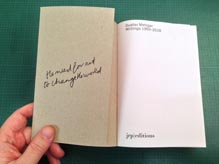
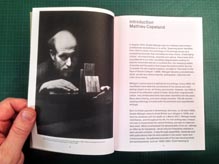
--
Writings (1953-2016)
Gustav Metzger
Mathieu Copeland (ed.)
Rassemblant plus de 180 textes écrits entre 1953 et 2016, ce volume complet positionne Gustav Metzger comme une figure parmi les plus influentes du XXe siècle, en tant qu'artiste, activiste, mais également écrivain, théoricien et satiriste prolifique.
Edité par Mathieu Copeland, ami de longue date et commissaire de plusieurs expositions de Gustav Metzger, cette anthologie dévoile l'évolution de la pensée de Metzger depuis les années 1950. Il comprend des écrits fondateurs tels que ses manifestes des années 1960 pour l'art autodestructeur et auto-créatif, un entretien avec R. Buckminster Fuller de 1970, « L'artiste face à l'effondrement social » (1998), et son manifeste patrimonial intitulé « Remember Nature » de 2016, ainsi que des critiques d'art, des satires politiques et des transcriptions de conférences. Une analyse stimulante de la période contemporaine par un artiste et un penseur pionnier impliqué très tôt dans les questions environnementales et sociétales.
Edité par Mathieu Copeland
paru en 2019
édition anglaise
13,2 x 19 cm (broché)
696 pages (91 ill. n&b)
ISBN : 978-3-03764-535-2
EAN : 9783037645352
https://www.lespressesdureel.com/ouvrage.php?id=7141&menu=0
HYPER-PALIMPSEST
Stefan Brüggemann
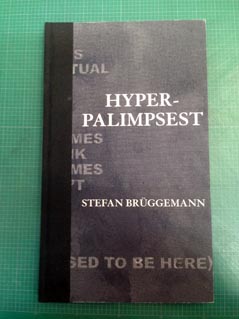
This publication reflects upon the exhibition of Stefan Brüggemann's nihilist statements read, sung, and screamed by Punk icon Iggy Pop, sculpting aurally the spaces of a seemingly empty gallery covered in densely painted black paneling paintings.
Stefan Brüggemann labours his work with words as the prime material. His medium is essentially pieces of text (statements, slogans, appropriated writing, poetry as a (w)hole…). Stefan's deepest desire was for Iggy Pop to incarnate these statements through his unique and mesmerizing voice. Iggy Pop has been a defining voice for generations, sparking a radical and uncompromising revolution whose effects can still be felt today. In October 2018, Brüggemann and Mathieu Copeland went to Miami to record him reading all of Stefan's text pieces and hyper-poems to date. The recording was later played in its entirety in the exhibition Hyper-Palimpsest at Hauser & Wirth, London in a room covered in densely painted black paneling, layered with text pieces repeated over and over again in black Letraset and spray painted over in black with newspaper headlines and the last lines of movies.
This publication reflects upon this experience, as it oscillates between being the memory of an exhibition and a book made of art to be read. It presents an opportunity for us to travel 360 degrees around the exhibition and then to approach the boards more closely to experience the materiality of the words. On the patio of the recording studio, under a heavy Miami sun, Brüggemann and Copeland also recorded a conversation with Iggy Pop, which is reproduced in these pages. Also included is a compelling essay by Norman Rosenthal and Jonathan P. Watts that reveals the politics behind the surface of Hyper-Palimpsest. Finally, all 69 of Stefan's text pieces are printed with black ink on black paper, as yet another negation disappearing into the void, a reaffirmation of Nothings.
Published following the eponymous exhibition at Hauser & Wirth, London, in 2019.
Edited by Mathieu Copeland.
Texts by Mathieu Copeland, Stefan Brüggemann, Iggy Pop, Norman Rosenthal, Jonathan P.Watts.
Published with B.C. Press.
published in September 2019
English edition
17,5 x 33,5 cm (hardcover)
136 pages (ill.)
ISBN : 978-2-37896-091-9
EAN : 9782378960919
https://www.lespressesdureel.com/EN/ouvrage.php?id=7444&menu=0
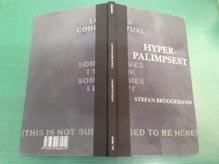
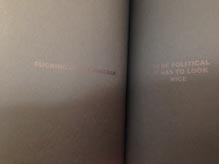
--
HYPER-PALIMPSEST
Stefan Brüggemann
Basée sur l'exposition des « Hyper-Poems » de Stefan Brüggemann, des déclarations nihilistes lues, chantées et hurlées par l'icône punk Iggy Pop, dont la voie emplissait les espaces d'une galerie en apparence vide, seulement recouverts de peintures noires, cette publication oscille entre le souvenir d'une exposition et un livre d'art à lire, proposant au lecteur de faire l'expérience de la matérialité des mots. L'ouvrage contient une conversation entre Stefan Brüggemann, Mathieu Copeland et Iggy Pop, un essai de Norman Rosenthal et Jonathan P. Watts, ainsi que les 69 textes de Brüggemann imprimés à l'encre noire sur papier noir, redoublant le geste de négation du palimpseste.
Publié suite à l'exposition éponyme à la galerie Hauser & Wirth, Londres, du 27 février au 27 avril 2019.
Edité par Mathieu Copeland.
Textes de Mathieu Copeland, Stefan Brüggemann, Iggy Pop, Norman Rosenthal, Jonathan P.Watts.
Publié avec B.C. Press.
paru en septembre 2019
édition anglaise
17,5 x 33,5 cm (relié, reliure toilée)
136 pages (ill.
ISBN : 978-2-37896-091-9
EAN : 9782378960919
A PERSONAL SONIC GEOLOGY
2017
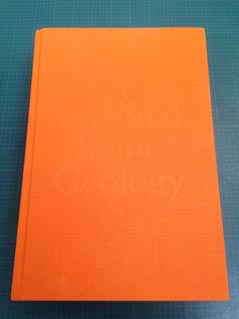
Since 2012, Mathieu Copeland & Philippe Decrauzat produce videos stemming from “a desire to film sound, record places, and dive into the process of a material construction and destruction.” This publication—between artist's book and critical essay—considers all films produced until then by the art critic and the artist, and offers a basis for reflexion and work for those to come. The 488 pages of this book includes over 2200 images from the films and exhibitions views. It includes critical texts as well as original statements by artists and musicians who collaborated with the duo.
The exhibition “A Personal Sonic Geology” gathers together the films realised by Mathieu Copeland and Philippe Decrauzat since 2012. Stemming from a desire to film sound, record places, and dive into the process of a material construction and destruction, these films are screened using a projection apparatus that integrates an exhibition of monochrome screens/paintings.
Invited to create a programme and events and exhibitions at le Plateau from march 2014 on, Mathieu Copeland and Philippe Decrauzat have each time used these spaces and this time to involve artists from the visual and music fields—using the exhibition format, or he denser format of the event—and film, their end purpose being to pursue their film collaboration to present to the eye and ear, in the form of an immersive arrangement, something that has already been seen, heard and experienced.
Creating a dialogue between filmed images, painting and sound production, these films bring together a constellation of artists, superimposing and fragmentating the 16 mm film stock. Filming musicians including Alan Licht, Ellen Fullman or FM Einheit as they realise the soundtrack for these films to be, creating a dialogue between works of art and the camera, with Marcia Hafif's drawings or a painting by Peter Halley, filming moments and places of creation such as the realisation of a painting by John M Armleder, the re-enactment of a lecture-demonstration by Gustav Metzger, Swiss artist and “researcher” Emma Kunz's Grotto, and production sites including a printing press in Marrakech, a textile manufacture or a paint factory, the film's components shape a linear assemblage of overlaid realities.
the exhibition catalogue combines critical texts of Michel Gauthier (Centre Pompidou), Jonathan Pouthier (Centre Pompidou) Paul Hegarty (Noise Music author), forewords by the filmmaker Charles de Meaux (Anna Sanders Films) and original statements by FM Einheit, Ellen Fullman, Ulrich Krieger, Alan Licht, Lydia Lunch, Agathe Max, Phill Niblock, Robert Poss and Susan Stenger.
A Personal Sonic Geology comes with five different covers (orange/green/blue/red/black), distributed randomly.
Foreword by Charles de Meaux.
Texts by Michel Gauthier, Jonathan Pouthier, Paul Hegarty, FM Einheit, Ellen Fullman, Ulrich Krieger, Alan Licht, Lydia Lunch, Agathe Max, Phill Niblock, Robert Poss, Susan Stenger.
Graphic design: Nicolas Eigenheer.
Published with Mousse Publishing.
published in December 2017
bilingual edition (English / French)
18,5 x 27,5 cm (hardcover, cloth binding)
488 pages (284 color & 2443 b/w ill.)
ISBN : 978-8-867493-43-2
EAN : 9788867493432
https://www.lespressesdureel.com/EN/ouvrage.php?id=6063&menu=0
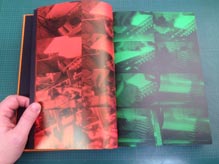
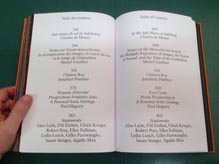
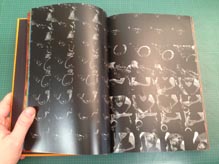
--
A PERSONAL SONIC GEOLOGY
Mathieu Copeland & Philippe Decrauzat
Depuis 2012, Mathieu Copeland et Philippe Decrauzat réalisent des vidéos nées du désir de « filmer le son, d'enregistrer des lieux et de plonger dans la matière des processus de fabrication et de destruction ». Cette publication – entre livre d'artiste et ouvrage critique – envisage l'ensemble des films produits à ce jour par le critique d'art et par l'artiste et s'offre telle une base de réflexion et de travail pour ceux à venir. Les 488 pages de l'ouvrage regroupent plus de 3000 images issues des vidéos et des vues d'exposition. Il comprend également une série de textes critiques et d'écrits d'artistes et de musiciens qui ont collaboré avec le duo par le passé.
L'exposition « A Personal Sonic Geology » regroupe l'ensemble des films coréalisés par Mathieu Copeland et Philippe Decrauzat depuis 2012. Nés du désir de filmer le son, d'enregistrer des lieux et de plonger dans la matière des processus de fabrication et de destruction, ces films sont présentés selon un mode de projection intégrant l'exposition de peintures écrans monochromes.
Invités à réaliser une programmation d'événements et d'expositions au plateau depuis mars 2014, Mathieu Copeland et Philippe Decrauzat ont à chaque fois utilisé ces espaces et ce temps pour faire intervenir des artistes du champ plastique ou musical – à travers le format de l'exposition ou celui, plus dense, de l'événement – et les filmer, avec comme finalité de poursuivre leur collaboration filmique pour donner à voir et à entendre sous la forme d'un dispositif immersif, ce qui aura déjà été vu, entendu et vécu.
Instaurant ainsi un dialogue entre image filmique, peinture et production sonore, les films, réalisés en relation avec une constellation d'artistes, mettent en œuvre les procédés de surimpression et de fragmentation de l'image au moyen de la pellicule 16 mm. Qu'il s'agisse de filmer des musiciens, tels Alan Licht, Ellen Fullman ou FM Einheit alors qu'ils réalisent la bande-son des films à venir, d'instaurer un dialogue œuvre-caméra avec les dessins de Marcia Hafif ou avec un tableau de Peter Halley, de filmer des moments ou des lieux de création – la réalisation d'une peinture de John M Armleder, la recréation d'une action/démonstration de Gustav Metzger ou la grotte de l'artiste et « chercheuse » suisse Emma Kunz – ou encore des lieux de production comme une imprimerie à Marrakech, une usine de filature textile ou une fabrique de peintures, les composantes de ces films forment ici un assemblage linéaire de réalités superposées.
Le catalogue de l'exposition réunit les textes critiques de Michel Gauthier (Centre Pompidou), de Jonathan Pouthier (Centre Pompidou) et de Paul Hegarty (auteur de Noise Music), la préface du cinéaste Charles de Meaux (Anna Sanders Films) et enfin, les « statements » inédits de FM Einheit, Ellen Fullman, Ulrich Krieger, Alan Licht, Lydia Lunch, Agathe Max, Phill Niblock, Robert Poss et de Susan Stenger.
A Personal Sonic Geology paraît sous cinq couvertures différentes (orange / vert / bleu / rouge / noir), distribuées aléatoirement.
Avant-propos de Charles de Meaux.
Textes de Michel Gauthier, Jonathan Pouthier, Paul Hegarty, FM Einheit, Ellen Fullman, Ulrich Krieger, Alan Licht, Lydia Lunch, Agathe Max, Phill Niblock, Robert Poss, Susan Stenger.
Conception graphique: Nicolas Eigenheer.
Publié avec Mousse Publishing.
paru en décembre 2017
édition bilingue (français / anglais)
18,5 x 27,5 cm (relié, couv. toilée)
488 pages (284 ill. coul. et 2443 ill. n&b)
ISBN : 978-8-867493-43-2
EAN : 9788867493432
THE ANTI-MUSEUM
2017
The Anti-museum book addresses the idea of anti-art in a broad sense, evoking attempts to disrupt rules and customs in diverse artistic disciplines. One must not forget that the notion of anti-art is set against the one that "everything is art"; they are conjoined. Both contradictory and provocative, they translate an artist’s desire to challenge art with its own means.
Mathieu Copeland and Balthazar Lovay, together with a stellar list of contributors, present the first extensive exploration of the radical and paradoxical concept that is ‘the anti-museum’ – a term so present in art history and yet that has never been the object of a detailed investigation and definition.
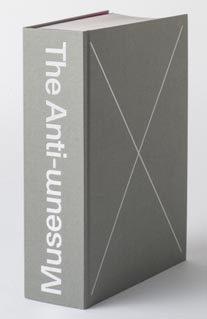
Artists surveyed include: John Armleder / Robert Barry / Andrea Branzi / Marcel Broodthaers / Daniel Buren / Graciela Carnevale / Maurizio Cattelan / Maria Eichhorn / Hanatarash & Yamatsuka Eye / Henry Flynt / Yona Friedman / Piero Gilardi / Swetlana Heger & Plamen Dejanov / Hi Red Center / Ishiko Junzo / GX Jupitter Larsen / Lefevre Jean Claude / Lydia Lunch / Sasaki Maki / Alessandro Mendini / Cady Noland / Lorraine O’Grady / Robin Page / Steven Parrino / Santiago Sierra / Robert Smithon / Ettore Sottsass / Takis / Jean Tinguely / Rirkrit Tiravanija / Ben Vautier / Matsuzawa Yutaka
Authors: Guillaume Apollinaire / Andrea Bellini / Zach Blas / Andrea Branzi / Erik Bullot / Billy Childish / Johannes Cladders / Iris Clert / Beatriz Colomina / Mathieu Copeland / Branislav Dimitrijevic / Jim Drobnick / Stanley Fisher / Véronique Follet / Yona Friedman / Michel Gauthier / Akasegawa Genpei / Michel Giroud / Kenneth Goldsmith / Richard Goldstein / Krist Gruijthuijsen / Katie Guggenheim / Storm van Helsing / Jon Hendricks / Hans Hollein / Ryan Holmberg / Stewart Home / Arnaud Labelle-Rojoux / Roberto Jacoby / Jakob Jakobsen / Gareth James / Déborah Laks / Balthazar Lovay / Boris Lurie / George Maciunas / Robert Morris / Achille Mbembe / Bob Nickas / Nicolas de Oliveira / Nicola Oxley / Mai-Thu Perret / Lil Picard / Yvonne Rainer / Georges Ribemont-Dessaignes / Matthieu Saladin / Fanny Schulmann / Sören Schmeling / Olivier Suter / Charles Thomson / Jean Toche / Reiko Tomii / Paulo Pires do Vale / Dora Vallier / Alan Wallach / Thibault Walter / Peter Weibel
A publication by Mathieu Copeland, together with Balthazar Lovay
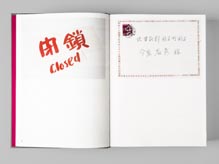
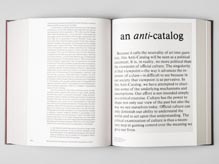
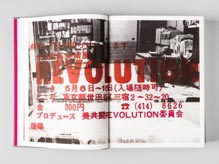
Graphic Design: Schaffter Sahli, Geneva
Published by: Fri Art & Koenig Books, London, in partnership with KW, Berlin
Distribution in Germany & Europe: Buchhandlung Walther Koenig, Köln
UK & Ireland: Cornerhouse Publications, Manchester
Outside Europe: D.A.P. Distributed Art Publishers, INC, New York
Language: English
225 color images
215 x 280 mm
794 pages
Order: books@fri-art.ch
40 CHF / 38 €
L'exposition d'un rêve / The Exhibition of a dream
Un livre de Mathieu Copeland
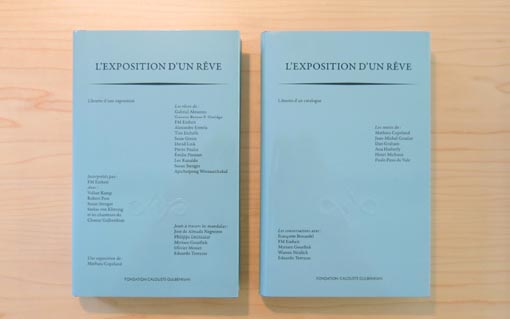
L’exposition telle qu’elle se propose s’inspire littéralement des rêves de cinéastes et de dramaturges, de poètes et d’écrivains. Leurs rêves ont été mis en musique par le musicien allemand F. M. Einheit puis enregistrés à la Fondation et dans son jardin, grâce à la contribution de nombreux musiciens et du Chœur Gulbenkian tout au long de 2017.
Un intéressant dialogue s’offre ici : le rêve et l’immatérialité d’une exposition et la matérialité très concrète d’une institution comme la Fondation Gulbenkian. L’architecture, l’institution, le jardin, selon les mots du commissaire Mathieu Copeland viennent « renseigner l’exposition et, en retour, l’exposition utilise l’institution ».
Le rêve – en tant que manifestation des désirs et des peurs (dans une lecture freudienne), support des voix de l’inconscient (parfois de voix de l’autre monde), mais aussi outil de création, le rêve comme élément constitutif de mythologies – est le fil conducteur de cette exposition.
Parallèlement, les abstractions géométriques (cf. Almada Negreiros) ou mystiques (les mandalas, des diagrammes symboliques qui jouent un rôle dans de nombreuses traditions religieuses ou même dans l’école jungienne de psychologie) tiennent ici une place importante. Ce projet donne lieu à ce que le commissaire appelle polyphonie, conçue par un « auteur-multiple », explorant les dimensions de l’immatérialité d’une exposition.
Textes: Les textes de Mathieu Copeland, Jean-Michel Goutier, Dan Graham, Ana Hatherly, Henri Michaux, Paulo Pires do Vale. Les conversations avec Françoise Bonardel, FM Einheit, Myriam Gourfink, Warren Neidich, Eduardo Terrazas. Les rêves de Apichatpong Weerasethakul, Lee Ranaldo, Emilie Pitoiset, Susan Stenger, Susie Green, David Link, Pierre Paulin, Alexandre Estrela, Tim Etchells, Gabriel Abrantes, FM Einheit et Genesis Breyer P-Orridge
Coordination éditoriale: Lore Gablier
Édité en: Maiadouro, 2017
Pages: 213
Dimensions: 14 x 21,7 cm
Langue: français
ISBN: 978-972-8462-94-9
Prix: €20
Pour commander / to purchase : calouste@gulbenkian-paris.org
Coreografiar exposiciones
Un libro de Mathieu Copeland
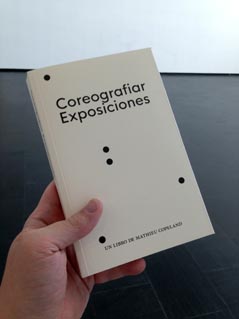
Más allá de la experiencia única que es Una exposición coreografiada, una multitud de preguntas surgidas de la exposición se han abierto camino hasta el libro Coreografiar exposiciones (2017, CA2M). El libro, a la vez un manifiesto y una antología, reúne a más de treinta artistas plásticos, coreógrafos, músicos, realizadores, teóricos y comisarios internacionales. Ahora se está traduciendo al español por primera vez, complementado con un nuevo prólogo de Mathieu Copeland y un ensayo de Manuel Segade. En Coreografiar exposiciones, se ofrece una notable perspectiva general de la relación existente entre la coreografía y las exposiciones y se analiza la organización de estas exposiciones a través del prisma de la coreografía, partiendo de los términos que la componen: partitura, cuerpo, espacio, tiempo y memoria.
Con la participación de: Kenneth Anger, Jérôme Bel, Julien Bismuth, Giovanni Carmine, Boris Charmatz, Mathieu Copeland, Tim Etchells, Barbara Formis, Maite Garbayo Maeztu, Kenneth Goldsmith, Amy Greenfield, Abbie Hoffman, Karl Holmqvist, Pierre Huyghe, Myriam van Imschoot, Jennifer Lacey, Leclubdes5, Franck Leibovici, Pablo León de la Barra, André Lepecki, Alan Licht, Raimundas Malašauskas, Loreto Martínez Troncoso, Malcolm McLaren, Gustav Metzger, Lilo Nein, Phill Niblock, Hans Ulrich Obrist, Michael Parsons, Julie Pellegrin, Mickaël Phelippeau, Claude Rutault, Manuel Segade, Irena Tomažin, Catherine Wood.
available at: ca2m@madrid.org
L'exposition d'un Film / The Exhibition of a film
Un livre de / A book by Mathieu Copeland
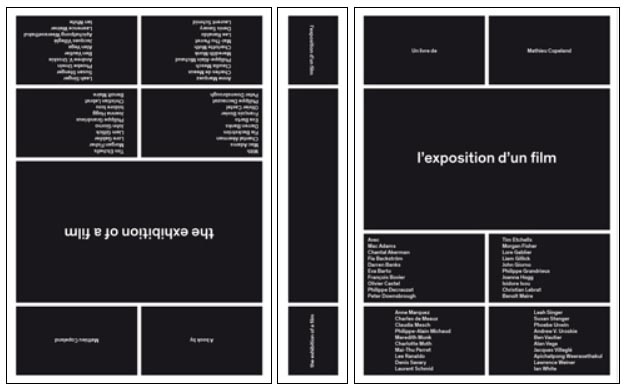
L'ouvrage L'Exposition d'un film fait suite à une exposition éponyme réunissant quarante-six artistes internationaux autour d'une même interrogation : que serait une exposition qui, au lieu de prendre place dans un musée ou dans une galerie, prendrait place au cinéma ? Une exposition prenant la forme d'un film présenté en salle de cinéma et contrainte par les propriétés intrinsèques de cet espace social, L'Exposition d'un film s'affirme à la fois comme un film exposé, le film d'une exposition ou encore comme une exposition filmée.
Prolongeant le questionnement amorcé au travers de L'Exposition d'un film, l'ouvrage se donne pour ambition, à partir d'un ensemble d'entretiens, de textes de commande et de textes republiés pour l'occasion, de revenir sur le rapport entre l'exposition et le film : leurs temporalités, leurs espaces, ou encore leurs modes de productions.
--
The book, The Exhibition of a Film, follows an eponymous exhibition that includes the work by forty-six international artists, and begun with a question: What would an exhibition be like if we changed the environment from the gallery, museum, or Kunsthalle, to that of the cinema? “The Exhibition of a Film”, an exhibition for a context, namely a film screened in a cinema and constrained by the properties particular to that social environment, is, at one and the same time, a film exhibited, a film of an exhibition and a filmed exhibition.
Expanding on the issues raised through the exhibition, the books is articulated through a series of interviews, commissioned text and reprints that examine the relationship between the exhibition and film: their temporalities, their space, their mode of production.
Contributions de / contributions by Mac Adams, Chantal Akerman, Fia Backström, Darren Banks, Eva Barto, François Bovier, Olivier Castel, Philippe Decrauzat, Peter Downsbrough, Tim Etchells, Morgan Fisher, Liam Gillick, John Giorno, Lore Gablier, Philippe Grandrieux, Joanna Hogg, Isidore Isou, Christian Lebrat, Anne Marquez, Charles de Meaux, Claudia Mesch, Philippe-Alain Michaud, Meredith Monk, Charlotte Moth, Mai-Thu Perret, Lee Ranaldo, Denis Savary, Laurent Schmid, Leah Singer, Susan Stenger, Phoebe Unwin, Andrew V. Uroskie, Ben Vautier, Alan Vega, Jacques Villeglé, Lawrence Weiner, Apichatpong Weerasethakul, Ian White.
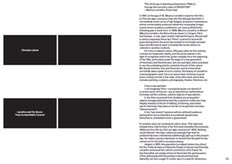
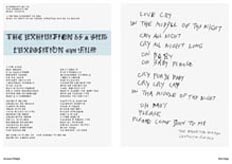
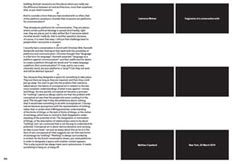
Graphic design: Nicolas Eigenheer and Jeremy Schorderet.
Published with the Geneva University of Art and Design. 2015.
édition bilingue (français / anglais) - bilingual edition (English / French)
17 x 24 cm (broché/softcover)
456 pages (16 ill. coul.)
30.00 €
ISBN : 978-2-84066-815-2
EAN : 9782840668152
Pour commander / to purchase : http://lespressesdureel.com/ouvrage.php?id=4399&menu=
Chorégraphier l’exposition / Choreographing Exhibitions
Un livre de Mathieu Copeland
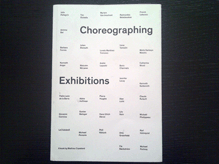
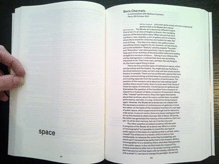
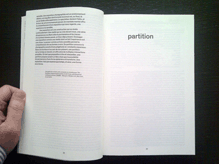
Un panorama des relations entre chorégraphie et exposition, à travers les contributions d'une trentaine d'artistes, chorégraphes, musiciens, cinéastes, théoriciens et commissaires d'exposition internationaux.
En 2008, le centre d'art contemporain La Ferme du Buisson accueillait le commissaire d'exposition Mathieu Copeland pour la présentation remarquée d'Une Exposition Chorégraphiée. Composée exclusivement de mouvements interprétés par trois danseurs pendant deux mois, l'exposition fit date dans l'histoire des relations entre danse et arts plastiques.
Au-delà de l'expérience unique qu'elle a constituée pour ceux qui l'ont vécue, Une Exposition Chorégraphiée a nourri une multitude de questions qui ont fait leur chemin pour donner naissance à un ouvrage intitulé Chorégraphier l'exposition.
Le livre réunit plus d'une trentaine d'artistes plasticiens, chorégraphes, musiciens, cinéastes, théoriciens et commissaires d'exposition internationaux. Formidable panorama des relations entre chorégraphie et exposition, il orchestre une polyphonie de points de vue à partir de cinq prismes : la partition, l'espace, le temps, le corps et la mémoire.
Contributions de Kenneth Anger, Fia Backström, Jérôme Bel, Julien Bismuth, Giovanni Carmine, Boris Charmatz, Mathieu Copeland, Tim Etchells, Barbara Formis, Maite Garbayo Maeztu, Kenneth Goldsmith, Amy Greenfield, Abbie Hoffman, Karl Holmqvist, Pierre Huyghe, Myriam Van Imschoot, Jennifer Lacey, LeClubdes5, Franck Leibovici, Pablo León de la Barra, André Lepecki, Alan Licht, Raimundas Malašauskas, Loreto Martínez Troncoso, Malcolm McLaren, Gustav Metzger, Lilo Nein, Phill Niblock, Hans Ulrich Obrist, Michael Parsons, Julie Pellegrin, Mickaël Phelippeau, Michael Portnoy, Claude Rutault, Irena Tomažin, Catherine Wood.
Publié avec Mathieu Copeland éditions, la Ferme du Buisson et la Kunst Halle de Saint-Gall.
paru en décembre 2013
édition bilingue (anglais / français)
16,8 x 23,8 cm (broché, sous jaquette)
424 pages
30.00 €
ISBN : 978-2-84066-682-0
EAN : 9782840666820
Disponible au Presses du Réel
--
Choreographing Exhibitions
A book by Mathieu Copeland
An overview of the relation between choreography and exhibition, through the contributions of over thirty international visual artists, choreographers, musicians, filmmakers, theorists, and curators.
In 2008, the Contemporary art centre La Ferme du Buisson, invited the curator Mathieu Copeland to present his work, Choregraphed Exhibition, composed of movements executed by three dancers over two months. This exhibition nourished a multitude of questions that gave birth to a book, Choreograping Exhibitions, overview of the relation between choreography and exhibition. It brings together over thirty international visual artists, choreographers, musicians, filmmakers, theorists, and curators.
Contributions by Kenneth Anger, Fia Backström, Jérôme Bel, Julien Bismuth, Giovanni Carmine, Boris Charmatz, Mathieu Copeland, Tim Etchells, Barbara Formis, Maite Garbayo Maeztu, Kenneth Goldsmith, Amy Greenfield, Abbie Hoffman, Karl Holmqvist, Pierre Huyghe, Myriam Van Imschoot, Jennifer Lacey, LeClubdes5, Franck Leibovici, Pablo León de la Barra, André Lepecki, Alan Licht, Raimundas Malašauskas, Loreto Martínez Troncoso, Malcolm McLaren, Gustav Metzger, Lilo Nein, Phill Niblock, Hans Ulrich Obrist, Michael Parsons, Julie Pellegrin, Mickaël Phelippeau, Michael Portnoy, Claude Rutault, Irena Tomažin, Catherine Wood.
Published with Mathieu Copeland editions, la Ferme du Buisson and Kunst Halle Sankt Gallen. Published in December 2013
bilingual edition (English / French)
16,8 x 23,8 cm (softcover, dust jacket)
424 pages
€30.00
ISBN: 978-2-84066-682-0
EAN: 9782840666820
Available via Les presses du réel
Genesis Breyer P-Orridge : 'Life as a Cheap Suitcase'
Genesis Breyer P-Orridge
Life as a Cheap Suitcase, 2000-2013.
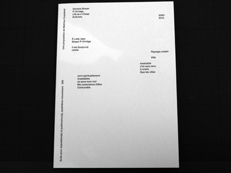
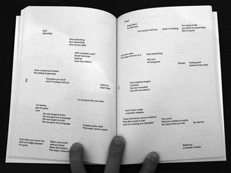
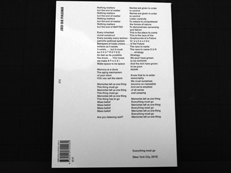
Available / Disponible via
Librairie du Jeu de Paume
1 place de la Concorde
75008 Paris
Tél. 01 47 03 12 50
Douglas Coupland : 'L'age des seismes. Guide de l'extreme présent'
Douglas Coupland
L’Age des seisme. Guide de l’éxtreme présent, 2013.
The Age of Earthquakes. A Guidebook to the Extreme Present, 2013.
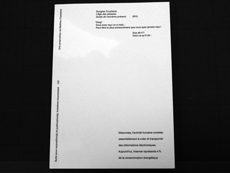
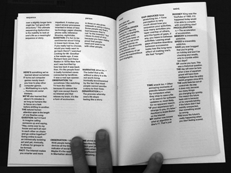
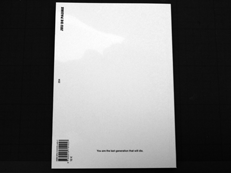
Available / Disponible via
Librairie du Jeu de Paume
1 place de la Concorde
75008 Paris
Tél. 01 47 03 12 50
http://www.librairiejeudepaume.org/
franck leibovici : 'filibuster (une lecture)'
Franck leibovici
filibuster (une lecture), 2012.
filibuster (a duration piece), 2012.
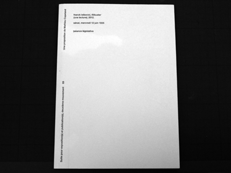
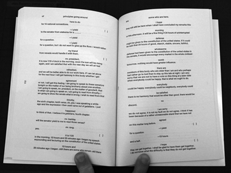
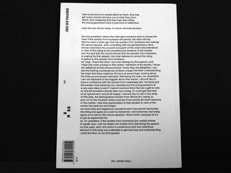
Available / Disponible via
Librairie du Jeu de Paume
1 place de la Concorde
75008 Paris
Tél. 01 47 03 12 50
http://www.librairiejeudepaume.org/
Kenneth Goldsmith : 'Je ne me tourne vers la théorie qu'apres avoir réalisé que quelqu'un a consacré toute sa vie à une question qui m'avait à peine traversé l'esprit jusqu'alors'
Kenneth Goldsmith
Je ne me tourne vers la théorie qu’après avoir réalisé que quelqu’un a consacré toute sa vie à une question qui m’avait à peine traversé l’esprit jusqu’alors, 2012.
I Look to Theory Only When I Realize That Somebody Has Dedicated Their Entire Life to a Question I Have Only Fleetingly Considered, 2012.
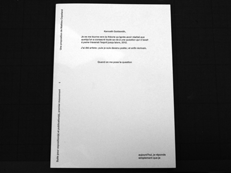
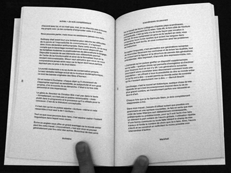
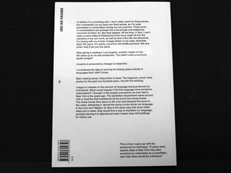
Available / Disponible via
Librairie du Jeu de Paume
1 place de la Concorde
75008 Paris
Tél. 01 47 03 12 50
http://www.librairiejeudepaume.org/
A Mandala Mental - Catalogue
A Mental Mandala
With texts by Luigi Amara, Mathieu Copeland, and Amanda de la Garza.
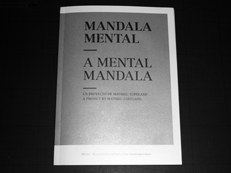
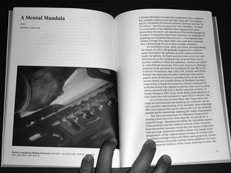
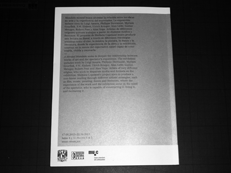
A Mental Mandala seeks to deepen the relationship between works of art and the spectator’s experience. The exhibition includes work by Luigi Amara, Philippe Decrauzat, Myriam Gourfink, and the partitions of F.M. Einheit, Ulrich Krieger, Alan Licht, Gustav Metzger, Robert Poss and Alan Vega. Artists of very different origins, who work in disparate media and formats. Mathieu Copeland’s project aims to produce a non-linear reading through different artistic strategies, such as film, music, painting, dance and literature, where the experience of the work and the exhibition occur in the mind of the spectator, who is capable of constructing it, living it, and recreating it.
Available at the MUAC /Museo Universitario Arte Contemporáneo
Insurgentes Sur 3000
Centro Cultural Universitario
Delegación Coyoacán
C.P. 04510
Ciudad de México
PROCURATION SUBORDONNÉE À UNE CONDITION SUSPENSIVE
Mathieu Copeland Presents
Procuration subordonnée à une condition suspensive
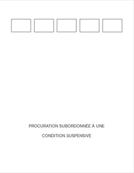
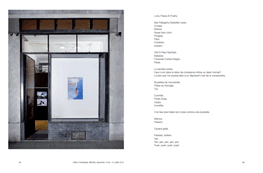
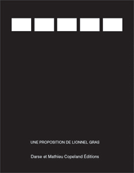
Procuration subordonnée à une condition suspensive vise non seulement à documenter les expositions organisées de septembre 2011 à juillet 2012 par Lionnel Gras à Darse, espace d'art dirigé par Fabrice Gygi à Genève, mais également à prolonger les enjeux artistiques et théoriques soulevés lors des diverses collaborations développées au cours ce projet. Chaque artiste ou partenaire est activement impliqué dans la conception de l'ouvrage qui s'offre comme un prolongement de l'espace d'exposition. Plusieurs auteurs ont également été conviés à proposer des approches complémentaires sur les œuvres exposées. Plus qu'un catalogue d'exposition, l'édition est augmentée par des pièces inédites qui se présentent comme autant de nouvelles et ultimes procurations.
Œuvres de François Curlet, Gilles Furtwängler, Fabrice Gygi, Lamya Moussa, Simon Nicaise, Emilie Parendeau, Stéphane Vigny. Textes de Paul Bernard, Mathieu Copeland, Lionnel Gras, Rebecca Lamarche-Vadel, Emmanuelle Maillard. Edité par Lionnel Gras.
--
Procuration subordonnée à une condition suspensive is not only meant to document the cycle of exhibitions organised by Lionnel Gras from September 2011 to July 2012 at Darse, the art space run by Fabrice Gygi in Geneva, but also to extend the artistic and theoretical issues which came up with the numerous collaborations that were developed for this project. Each artist and partner was actively involved in the design of an edition which is to be seen as an extension of the exhibition space. Several authors have also been invited to provide further discussions about the exhibited works. More than just another exhibition catalogue, this edition is also enhanced by a series of original pieces that are to be seen as further and ultimate procurations.
Works by François Curlet, Gilles Furtwängler, Fabrice Gygi, Lamya Moussa, Simon Nicaise, Emilie Parendeau, Stéphane Vigny. Texts by Paul Bernard, Mathieu Copeland, Lionnel Gras, Rebecca Lamarche-Vadel, Emmanuelle Maillard. Edited by Lionnel Gras.
Available via Les presses du réel
Mathieu Copeland Presents
Auto-creative Art
Gustav Metzger
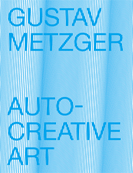
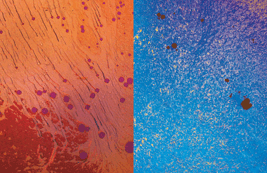
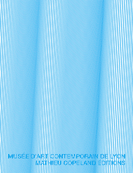
L'art auto-créatif est indissolublement lié à ce qui fut son corollaire, l'art auto-destructif, que Gustav Metzger définit dès novembre 1959 dans son premier manifeste auto-publié. Si son œuvre est souvent envisagé à travers le prisme prépondérant de l'auto-destruction, il nous apparaît aujourd'hui nécessaire de considérer l'envers de toute destruction : l'auto-création. Metzger associe dès ses débuts le développement d'une pensée théorique et philosophique radicale à une expérimentation artistique constante. Ce sont ces deux dimensions que l'exposition met en œuvre. S'y trouvent réunis pour la première fois, les cinq manifestes « historiques » publiés par l'artiste entre 1959 et 1964, ainsi qu'un ensemble de documents reflétant sa pensée et son engagement pour un art auto-créatif. Gustav Metzger le définit ainsi en 1962 : « Avec cette forme d'art comme avec l'art auto-destructif, le temps, l'espace, le mouvement, la métamorphose et le son jouent un rôle à la fois différent et beaucoup plus important dans la conception, la construction et l'appréciation de l'œuvre […] ». Ces documents inédits sont présentés avec Supportive, 1966-2011, une œuvre récemment acquise par le musée. Cet environnement monumental fait de cristaux liquides incarne l'auto-création, principe élaboré dès 1959, dans sa plus vaste mise en œuvre réalisée à ce jour.
Publié à l'occasion de l'exposition de Gustav Metzger « Supportive, 1966-2011 » au Musée d'art contemporain de Lyon, de février à avril 2013. Textes de Gustav Metzger, Thierry Raspail, Mathieu Copeland, Franck Popper.
--
Auto-creative art is inseparably linked to its corollary, auto-destructive art, which Gustav Metzger defined in November 1959 in his first self-published manifesto. His work is mainly considered through the prism of auto-destruction, yet it appears as necessary to now envisage the opposite of destruction, auto-creation. From the very beginning, Metzger combined the development of theoretical thought and radical philosophy with constant artistic experiment. These two dimensions are the core of the exhibition, which, for the first time, brings together the five “historic” manifestoes published by the artist between 1959 and 1964, as well as a set of documents reflecting his ideas and his commitment to auto-creative art, which he described as follows in 1962: “In this art form, as in Auto-Destructive Art, time, space, motion, metamorphosis and sound have a different far more important role in the conception, construction and appreciation of the work […].” Never previously exhibited, these documents are presented alongside Supportive, 1966-2011, a work recently acquired by the Museum. This monumental environment made of liquid crystals is the embodiment of auto-creation, as it was elaborated by Metzger from 1959 onwards. It is the most immersive implementation of these principles to date.
Published on the occasion of Gustav Metzger's exhibition “Supportive, 1966-2011” at the Lyon Museum of Contemporary Art, from February to April 2013. With texts by Gustav Metzger, Thierry Raspail, Mathieu Copeland, Franck Popper.
Available via Les presses du réel
ON KAWARA : ONE MILLION YEARS [PAST AND FUTURE] No. 69 & 70
It is with great proud that Mathieu Copeland Presents the release of On Kawara : One Million Years [Past and Future] No. 69 & 70. This edition of 4 audio CDs in a wooden case, realised at 250 copies, comprise of the reading of On Kawara’s One Million Years [Past and Future] covering 969 611 BC to 967 811 BC & 33 411 AD to 34 450 AD.
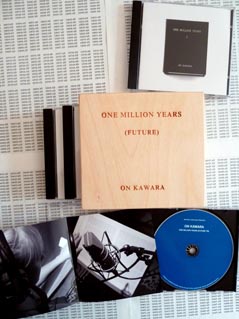
Partons de Zéro (EMPECEMOS DE CERO)
A publication curated by Mathieu Copeland & Philippe Decrauzat as the score for a future exhibition.
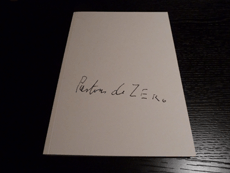
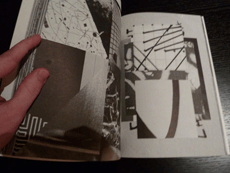
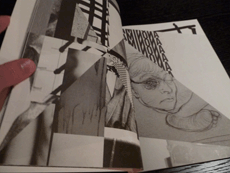
Available / Disponible via
Parra & Romero
Claudio Coello, 14 - 28001 Madrid Spain
Tel. +34 91 576 28 13
Fax: +34 91 577 42 46
info@parra-romero.com
Reprise #1 - Studies for a catalogue / a study for an exhibition on violence in contemporary art (reprise 1964/2011)
Reprise #1
Studies for a Catalogue: a Study for an Exhibition of Violence in Contemporary Art (Reprise 1964/2011)
The exhibition at Flat Time House of curator Mathieu Copeland’s ‘bootleg’ of the ICA show, and the very lack of an extensive catalogue of the original show, prompted this publication, Study for a Catalogue. It is an imagined version of what that catalogue might have been; and also of what the exhibition might be, if curated anew in 2011. It comprises photocopied reproductions of all the works from the show (with some free replacements where works were not identifiable from the original catalogue, or have not been readily available in reproduction); a text on the violence of curation by artist Warren Neidich; a downloadable screening programme, again liberally expanded from events that took place in 1964; and pages specially produced for the catalogue in the summer of 2011 by artists including Elena Bajo, Neal White, Davide Ballula, Erica Baum, Tom Benson, Emma Bjornesparr, Stefan Brüggemann, Philippe Decrauzat, Peter Fillingham & Charlotte Moth, Mark McGowan, Anne-Sylvie Henchoz, Camille Henrot, Pablo Leon de la Barra, Warren Neidich, Philomene Pirecki, and Giorgio Sadotti.
The catalogue, in B&W and A4 format, can be downloaded from http://www.flattimeho.org.uk or http://www.reprise.me ready to be printed. A page template will be freely available so that new pages and chapters can be added with the intention that these Studies for both an Exhibition and a Catalogue of Violence in Contemporary Art can extend the debate, begun in 1964, about the good and bad in violence and about the very image of violence itself.
Elisa Kay
27 July 2011
UNE CARTE MENTALE POUR UNE EXPOSITION
Edited to accompany the exhibition "...avant il n'y avait rien, après on va pouvoir faire mieux (…before there was nothing, after we can only do better…)", co-curated by Mathieu Copeland & Philippe Decrauzat for Circuit - Lausanne, Switzerland, “a mental map for an exhibition (une carte mentale pour une exposition)” is both the catalogue for an exhibition and a statement on the ad-equation between the original and its copy, and their inherent equality.
This ‘photocopy book’ (another Xerox book so to say) reproduces all the artefacts featured in the exhibition, cataloguing these quite literally as all are photocopied and reproduced at scale 1: by Nicolas Eigenheer. A mental map for an exhibition is akin to laying out a territory of thoughts, a cosmology of connections, attractions, or and again repulsions. Equally to how an exhibition ultimately exists through knowledge, in a mental space, a mental territory is thus to be mapped out.
This publication includes art works, drawing or again printed matters by artists including Alan Vega and Antonin Artaud, Kurt Seligmann, Ad Reinhardt, Paul Sharits, Emma Kunz, Glenn Branca, Gustav Metzger, Wallace Berman, Phoebe Unwin, Claude Parent, Jon Savage, Unica Zürn, Madelon Vriesendrop, Charles Burns, Judy Chicago, Brion Gysin, Amélie Dubois, Savage Pencil, Hans Hartung, Asger Jorn, André Masson, Max Kohler, Henri Michaux, Mel Bochner, Steve Albini, Dinos Chapman, Jake Chapman, Jean Tinguely, Max Ernst, Gerhard Rühm, Tadeusz Kantor, NPA, Bruce Conner, Marty Rev, Bob Cobbing, Linder Sterling, Frank Kozik, George Maciunas, Leonora Carrington, Henry Flint, Henri Chopin, Georges Brecht, Le Freistilmuseum, Loulou Picasso, Yoko Ono, Scott King, Rudolph Grey, A.R. Penck, Michael Snow, J.G. Ballard, Salvador Dali, Paul “Cool P” Liebegott, Wyndham Lewis, Jacques Villeglé, Karl Holmqvist, Jacques Bonnard, Ric Ocasek, Marian Zazeela, Delphine Coindet, Genesis Breyer P-Orridge, Warren Neidich, Hans Bellmer, Natacha Anderes, Peter Fischli, Roland Topor, Virginia Overton, Andrea Merkx, W. C. Westermann, Fabrice Stroun (…).
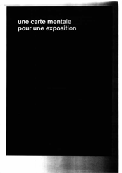
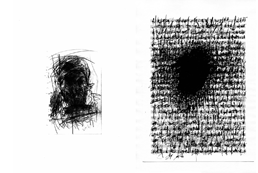
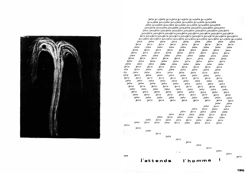
UNE EXPOSITION A ETRE LUE/AN EXHIBITION TO HEAR READ (VOLUME 3)
Avec/With, Robert Barry, Jarrod Fowler, Nicolas Garait, Karl Holmqvist, Bethan Huws, David Medalla, Yann Sérandour, Cally Spooner, et/and Sue Tompkins.
Une exposition de/An exhibition by Mathieu Copeland
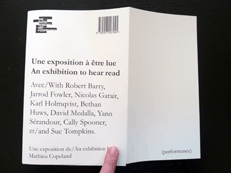
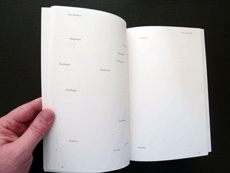
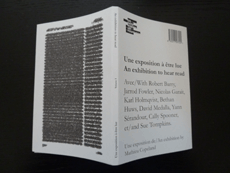
Available / Disponible via
the DAVID ROBERTS ART FOUNDATION -FITZROVIA
111 GREAT TITCHFIELD STRET , LONDON W1W 6RY
General information: info@davidrobertsartfoundation.com
UNE EXPOSITION A ETRE LUE/AN EXHIBITION TO HEAR READ (VOLUME 2)
Avec Marí Alessandrini, Sacha Béraud, Emma Bjornesparr, Jérémy Chevalier, Chloé Delarue, Kenneth Goldsmith, Anne-Sylvie Henchoz, Jean-Christophe Huguenin, Livia Johann, Tom Johnson, Franck Leibovici, Véronique Portal, Lili Reynaud Dewar, Tatiana Rihs, Daphné Roulin, Cally Spooner, Irena Tomažin, Anne Le Troter et Martina-Sofie Wildberger
Une exposition de Mathieu Copeland
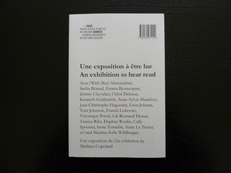
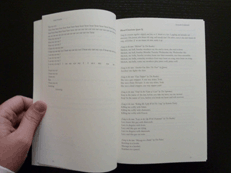
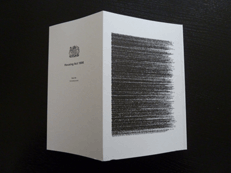
Available / Disponible via
LiveInYourHead
Institut curatorial de la Head – Genève
Rue du Beulet 4, 1203 Genève
UNE EXPOSITION A ETRE LUE/AN EXHIBITION TO HEAR READ (VOLUME 1)
Avec/With, Benoit Maire, Goldin + Senneby, Keren Cytter, Amélie Dubois, Charlotte Moth, Cally Spooner, Falke Pisano
Une exposition de/An exhibition by Mathieu Copeland
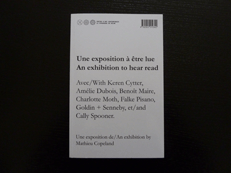
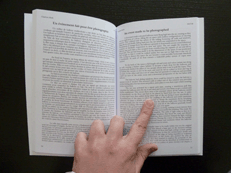
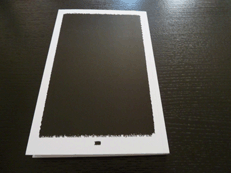
Available / Disponible via
Contact : communication@cac-synagoguedelme.org / +33(0)3 8701434
ALAN SUICIDE VEGA - INFINITE MERCY
Cette première monographie consacrée à l'œuvre plastique d'Alan Vega retrace, à travers une riche iconographie, un parcours artistique radical et sans compromis sur quarante ans. Le livre s'ouvre par la reproduction dans son intégralité en fac-similé du célèbre magazine Art Rite #13 élaboré par l'artiste en 1977, et se conclut par une nouvelle œuvre inédite de 16 pages réalisée spécialement pour le projet. L'ouvrage s'articule autour d'un long entretien réalisé avec Alan Vega et de contributions et discussions avec, entre autres, Edit Deak, Martin Rev, Ric Ocasek, Marc Hurtado, Philippe Grandrieux ou Henry Rollins.
Publié suite à l'exposition rétrospective éponyme au Musée d'Art Contemporain de Lyon, de mai à août 2009.
Figure mythique de la scène alternative artistique new-yorkaise, pionnier du rock électronique minimal et cofondateur, avec Martin Rev, du groupe culte Suicide, Alan Vega (né en 1938 à Brooklyn) fut également l'un des fondateurs, à la fin des années 1960, du Project of Living Artists à New York, lieu pluridisciplinaire tenu par des artistes et ouvert en continu qui accueillera les New York Dolls, Television ou Blondie. Depuis, Alan Vega développe, parallèlement à ses activités musicales qu'il poursuit en solo avec une vingtaine d'albums réalisés depuis les années 1980, une œuvre plastique anti-esthétique et anti-formaliste, assemblage d'objets divers récupérés dans la rue (ampoules, câbles, télévisions, néons...) qui embrasse la réalité contemporaine dans laquelle il évolue.
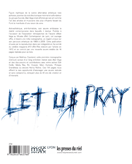
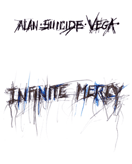
A seminal figure of the New York alternative art scene and a pioneer of minimalist electronic rock as the cofounder of the mythical band Suicide, Alan Vega has been since the late 60’s one of the most influential artist and musician, turning Punk into the manifesto of a reason to live.
Anti-aesthetic, anti-formalist, his work embraces the contemporary reality in which he is immersed. Published on the occasion of Alan Vega’s retrospective exhibition at the Musée d’art contemporain de Lyon, this publication offers, through a rich iconography, a unique look on his artistic life from 1969 to 2009. This book opens on the complete reproduction as a facsimile of the iconic magazine ArtRite #13 created by the artist in 1977, and is concluded with a new 16 pages piece created exclusively for this publication.
Edited by Mathieu Copeland, this first monograph consists of a long interview with Alan Vega and discussions and contributions with among others Edit DeAk, Marty Rev, Ric Ocasek, Marc Hurtado, Philippe Grandrieux or again Henry Rollins. These 144 pages offer the rare opportunity to envisage a radical and uncompromising commitment, envisaging more than 40 years of creation and intensity.
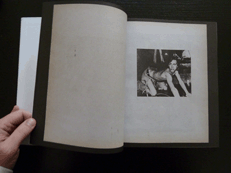
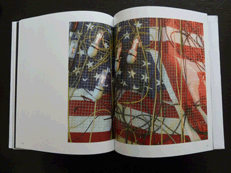
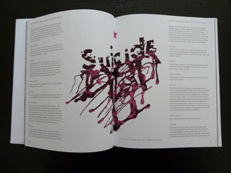
Sountrack for an Exhibition
A full colour, hardback publication that includes essays and discussions with participating artists and guest contributors. The catalogue reproduces the entire score of the soundtrack, includes film stills, installation shots and includes an audio DVD of excerpts of the soundtrack. Texts include an essay by Mathieu Copeland, curator of the exhibition; a discussion with Susan Stenger and Tony Conrad (composer, filmmaker and musician, co-founder of The Dream Syndicate with John Cale and La Monte Young); a discussion with Gustav Metzger (influential artist born in 1936 in Germany, lives and works in London, leading figure of Auto-Destructive-Art), John Armleder (painter born in 1948, influential Swiss artist and founder of Ecart, associated with Neo–Geo movement in the ’80s), and Mathieu Copeland; and a discussion with the filmmaker, Kristian Levring. (to order: www.forma.org.uk)
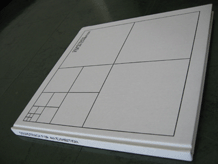
.gif)
.gif)
Soundtrack for an Exhibition - links to the exhibition information (eng) - Musée Art Contemporain Lyon
L'exposition Soundtrack for an Exhibition s'articule autour de trois éléments principaux : une bande-son, une exposition de peintures et un film. La bande-son est diffusée dans l'espace d'exposition ainsi qu'en différents endroits du musée et se poursuit un mois après la fermeture de l'exposition. Changeant de nature en fonction de l'environnent qu'elle qualifie, elle devient tour à tour la bande-son de peintures, d'un film ou d'un espace vide.
Cette pièce sonore reprend la structure d'une chanson pop traditionnelle dont la forme est conçue pour durer 96 jours. Ainsi, son introduction dure 4 jours, chaque refrain dure 8 jours et chaque couplet 16 jours. Elle est composée de 3 couplets qui font chacun référence à un genre musical différent (easy listening et vieux standards, folk et country blues, hard-rock et heavy metal), la musique expérimentale faisant le lien entre ces différentes parties.
Le catalogue, qui rassemble essais autour du projet et conversations entre les artistes et les organisateurs, reproduit l'intégralité de la partition de la bande-son, ainsi que les images de l'installation et des extraits du film et de la bande son sur DVD audio.
Soundtrack composed by/composée par Susan Stenger with contributions by/avec des contributions de Robert Poss, Alan Vega, Alexander Hacke, F.M. Einheit, Kim Gordon, Mika Vainio, Bruce Gilbert, Ulrich Krieger, Warren Ellis, Jim White, Jennifer Hoyston, Andria Degens, Spider Stacy
Paintings by/Peintures par John Armleder, Steven Parrino
Feature film by/Film par Kristian Levring
An exhibition by/Une exposition de Mathieu Copeland
VIDES
Edité par JRP-Ringier
Vides. Une rétrospective est une exposition paradoxale : à travers la réactualisation de neuf «expositions vides», elle apparaît simultanément comme un projet expérimental qui refuse les règles classiques des arts visuels et comme un objet historique qui confronte les réalisations de Art & Language, Robert Barry, Stanley Brouwn, Maria Eichhorn, Bethan Huws, Robert Irwin, Yves Klein, Roman Ondák et Laurie Parsons.
Support et prolongement de la manifestation, cet ouvrage dessine les contours du concept de «vide» dans l'art, l'esthétique, la philosophie, la religion, les sciences, la culture populaire, l'architecture et la musique, en abordant les problématiques du rien, de la vacuité, de l'invisible et de l'ineffable, du rejet et de la destruction. S'ouvrant sur un catalogue qui documente les neuf expositions historiques et contemporaines retenues, le livre comporte également une anthologie d'une quarantaine de textes, souvent inédits, ainsi que des contributions d'artistes spécialement réalisées pour l'ouvrage. Les essais de Benjamin Buchloh, Jean- François Chevrier, Henry Flynt, Lucy Lippard, Bernard Marcadé, Anne Moeglin-Delcroix, Brian O'Doherty, Sadie Plant, Didier Semin, David Toop ou Sarah Wilson s'entrecroisent ainsi avec des entretiens réalisés avec Robert Barry, Ben, Morgan Fisher, Claude Parent ou Jacques Villeglé, et les propositions de Peter Downsbrough, Dominique Gonzalez-Foerster, Wade Guyton, Hans Haacke, Sherrie Levine, Malcolm McLaren, Olivier Mosset, Sturtevant ou Lawrence Weiner.
À travers la riche documentation et les textes de spécialistes réunis, cet ensemble se propose d'évaluer les origines, les dispositifs et les résonances de ce geste artistique capital, consistant à vider l'espace d'exposition plutôt qu'à le remplir.
Edité par Mathieu Copeland avec John Armleder, Laurent Le Bon, Gustav Metzger, Mai-Thu Perret, Clive Phillpot.
Publié avec le Centre Pompidou, Paris, et la Kunsthalle Bern.
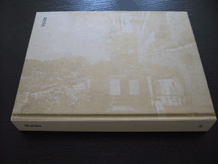
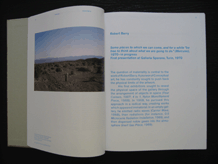
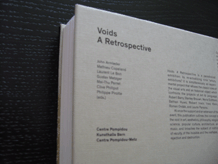
Voids. A Retrospective
Voids. A Retrospective is a paradoxical exhibition: by re-actualizing nine “empty exhibitions,” it is simultaneously an experimental project that refuses the classic rules of the visual arts and an historical object which confronts the projects of Art & Language, Robert Barry, Stanley Brouwn, Maria Eichhorn, Bethan Huws, Robert Irwin, Yves Klein, Roman Ondák, and Laurie Parsons.
At once the support and an extension of the event, this publication outlines the concept of the void in art, aesthetics, philosophy, religion, science, popular culture, architecture, and music, and broaches the subject of nothing, of vacuity, of the invisible and the ineffable, of rejection and destruction.
Opening with a catalogue section that documents the nine selected historical and contemporary exhibitions, the publication also contains an anthology of more than forty texts, many published here for the first time, as well as contributions by artists created especially for this volume.
Essays by Benjamin Buchloh, Jean-François Chevrier, Stuart Comer, Lucy Lippard, Bob Nickas, Brian O'Doherty, Sadie Plant, Ralph Rugoff, Jon Savage, and Sarah Wilson thus intersect with interviews conducted with Robert Barry, Morgan Fisher, Claude Parent, and Jacques Villeglé, and the propositions of Peter Downsbrough, Dominique Gonzalez-Foerster, Wade Guyton, Hans Haacke, Sherrie Levine, Malcolm McLaren, Olivier Mosset, Yoko Ono, Sturtevant, and Lawrence Weiner.
Through the rich documentation, as well as the texts by specialists on the subject, this book proposes an evaluation of the origins, the mechanisms, and the resonances of this major artistic gesture consisting of emptying the exhibition space rather than filling it.
Edited by Mathieu Copeland with John Armleder, Laurent Le Bon, Gustav Metzger, Mai-Thu Perret, Clive Phillpot and Philippe Pirotte.
Publié avec le Centre Pompidou, Paris, et la Kunsthalle Bern.
2009
édition française et anglaise
21,5 x 28 cm (broché)
540 pages (100 ill. coul. et 200 ill. n&b)
39 €ISBN : 978-3-03764-017-3EAN : 9783037640173
Michael Parsons, "Piano Music 1993 - 2007", played by John Tilbury,
audio CD - released on the 7th of December 2008 // Launch from 1pm, at the Warehouse, 13 Theed Street - London
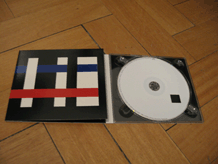
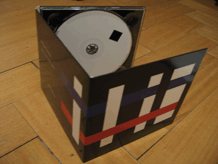
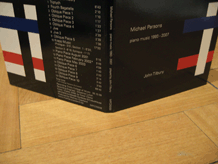
Michael Parsons: Piano Music 1993 – 2007
This selection of piano pieces represents an interplay of opposite tendencies, formal and informal, perhaps reflecting an unresolved tension between ‘classical’ and ‘experimental’ aspects of my music over the last 15 years. Triptych (1993) uses a form of 12 note serialism, in which the harmonic and melodic material is combined with its own inversion, but without the expressionist gestures associated with classic European serialism. Three formal main sections are offset by two rhythmically more fluid melodic interludes, the greater flexibility gradually infusing and transforming the character of the later sections with jazz-related chromatic inflections. (…)
Extracts from the CD notes
Michael Parsons (b. 1938 - Happy 70th!) has been active as a composer, performer, writer and lecturer since the 1960s. He belongs to the generation of English experimentalists who have explored a wide range of radical alternatives to prevailing traditional and mainstream tendencies in new music. In 1969 he was co-founder with Cornelius Cardew and Howard Skempton of the Scratch Orchestra, and during the 1970s he was closely associated with visual artists of the Systems group. In common with the work of other English and American experimentalists, his music exemplifies an economical use of material, clarity of structure and an objective and exploratory approach to the actualities of sound and performance.
Produced, designed and published in 2008 by Mathieu Copeland
with support by Culture House
LAUNCH PRICE : 15£ / 18€ (shipping included)
to purchase - pour commander, please either use PAYPAL or email info@mathieucopeland.net
![]()
The Saints, 6 Films by Amy Granat
MATHIEU COPELAND PRESENTS
The Saints, 6 films by Amy Granat on DVD, Launch at the Swiss Institute NY on Wednesday 29th of October 2008
THE SAINTS
6 FILMS BY AMY GRANAT WITH FIA BACKSTRÖM, JUTTA KOETHER,
AMY O’NEILL, MAI-THU PERRET, ANGEL TURNER
ST LUCIA
A FILM BY AMY GRANAT & FIA BACKSTRÖM, 11’05’’
ST AGATHA
A FILM BY AMY GRANAT & MAI-THU PERRET, 11’35’’
ST TERESA DE AVILA
A FILM BY AMY GRANAT & JUTTA KOETHER, 11’36’’
ST CECILIA
A FILM BY AMY GRANAT & ANGEL TURNER, 11’42’’
ST TWEETY
A FILM BY AMY GRANAT & AMY O’NEILL, 11’46’’
ST LOUISE
A FILM BY AMY GRANAT, 7’08’’
CAMERA BY PHILIPPE DECRAUZAT
PAINTINGS BY OLIVIER MOSSET
THE SAINTS
DVD ALL ZONES [PAL]
65 MINUTES
BLACK & WHITE / COLOUR / SILENT - 4/3
ALL PUBLIC
ISBN: 978-2-917097-03-8
Produced, designed and published in 2008 by Mathieu Copeland
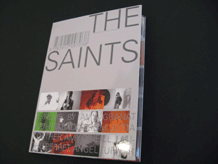
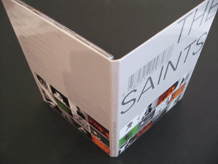
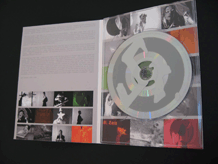
LAUNCH PRICE : 30€ / 45$ (shipping included)
to purchase - pour commander, please either use PAYPAL or email info@mathieucopeland.net
It is with great proud that we announce the release of the DVD 'AN EVENING OF THE BOOK', featuring 3 films by Mai-Thu Perret.
Originally produced for The Lyon Biennale of Contemporary Art and filmed on location at the Kitchen NY, Evening was conceived as a ‘remake’ of the 1924 agit prop play of the same title that was conceived as an experiment in mass artistic agitation for the book, and dramatized the conflict between old pre-revolutionary and new revolutionary books. Using actors from the academy of communist education, in a set & with costumes designed by Varvara Stepanova, it was a pantomime that culminated in the victory of the revolutionary heroes and a parade of libraries and new editions.
This performance, in which books and letters are actors in their own right, seemed a suitable starting point for the artist’s first array into moving images. Using props sometimes inspired by those of the original evenings, such as the books or the sports costume, sometimes unrelated such as the fluorescent tubes, the cut out from the banner, or the commas, Mai-Thu Perret devised the outline of a choreography which was performed for the camera by a team composed of artist friends such as Amy Granat or Fia Backström, and professional dancers.
DVD ALL ZONES
LAUNCH PRICE : 30€ / 45$ (shipping included)
to purchase - pour commander, please either use PAYPAL or email info@mathieucopeland.net
A signed limited edition of 30 copies comes with samples of two signed & numbered wall papers cuts screenprinted for the exhibitions. For more information please visit the webpage or contact info@mathieucopeland.net
Produced, designed and published in 2008 by Mathieu Copeland
APPEL çA COMME TU VEUX
Un film d'Arnaud Michniak - DVD Disponible maintenant (communiqué de presse)
“Appelle ça comme tu veux” est le premier long métrage d’Arnaud Michniak. Un film sans appel dont la violence sociale est d’une rare actualité. Sans ménagement que ce soit pour les sujets filmés ou l’objet film, “Appelle ça comme tu veux” est direct comme un slam et efficace comme de la télé réalité.
“Appelle ça comme tu veux” utilise la caméra comme un esclave. Tout débute avec le vol d’une caméra. Tout s’articule autour de l’outil qui permet sa réalisation et de ceux qui en croisent la cellule, qu’il s’agisse d’inconnus, de manutentionnaires, de paumés, d’acteurs dont Jean-Pierre Mocky, de proches comme Nonstop, ou plus généralement de tous ceux qui font notre réalité, qui créent notre paysage.
“Appelle ça comme tu veux” ça veut dire : on se fout de ce que tu penses, non pas parce qu’on se fout de toi, ni parce que ce que tu penses est nul, mais simplement parce que ça ne change rien, c’est déjà trop tard, c’est déjà fini.
Comme annonçant un programme, on retiendra cette phrase entendue au court du film, “On est historien, on filme la fin du monde”.
APPEL çA COMME TU VEUX, un film d’Arnaud Michniak
DVD Toutes Zones (PAL), Français, Couleurs, Son, 4/3.
APPEL çA COMME TU VEUX I (37’53) & II (22’09) ; BONUS (7’32)
Produced, designed and published in 2007 by Mathieu Copeland
Anna Sanders Films - The In Between
The In-Between – Anna Sanders Films
featuring works by Dominique Gonzalez-Foerster, Pierre Huyghe, Charles de Meaux, Philippe Parreno, Apichatpong Weerasethakul
The In-Between, the key book about French production company Anna Sanders Films, is now available. This company has blazed a trail for a new breed of cinema – one that is made by visual artists and shown most often in galleries, but increasingly is finding its way into cinemas and film festivals.
Anna Sanders’ films share a general fascination with Asia, exploring place and its relationship to personal narratives. Stunning, often sensual, imagery combine with simple cinema making. Retaining a cool distance form their subjects, the filmmakers create a space for the viewer to become immersed in the beauty of images and their meaning.
Who is Anna? She is too complex to be a mere representation of an
‘every woman’ character: not only is she the creator of remarkable films, she is the fictional subject of ‘a film currently being written’ [Huyghe and Parreno]. She is the personification of the creative talents of Dominique Gonzalez-Foerster, Pierre Huyghe, Charles de Meaux and Philippe Parreno. Ultimately Anna is an enigma, an imagined persona posing intriguing questions – like her films – about identity and representation.
Now, with the release of The In-Between, readers will be able to find out the fact and the fiction of Anna. This book delves in-between the films and places Anna into the contexts of film history and current visual art practice. The volume – co-published by Forma – offers a wealth of Anna Sanders film stills, production shots and a beguiling look and feel. It highlights the position of Anna Sanders as an in-between: in-between the economies of the art world and of cinema; in-between cinemas; in between realities, dreams and fictions.
Among the featured artists are Charles de Meaux, whose film Shimkent Hotel was selected as one of the highlights of the 2003 Edinburgh International Film Festival and Apichatpong Weerasethakul, whose Blissfully Yours won awards at Cannes and at the 2003 International Film Festival, Rotterdam and whose new film Tropical Malady produced by Anna Sanders has been awarded the prestigious Cannes Jury Prize 2004.
Other Anna Sanders Films artists, meanwhile, have claimed some of the most prestigious visual art prizes. Pierre Huyghe was awarded the Hugo Boss Prize and Dominique Gonzalez-Foerster the Duchamp prize, both in 2002.
In June 2004, the Filmmuseum in Amsterdam celebrated Anna Sanders with a major retrospective as part of the World Wide Video Festival. The In-Between was launched in the UK by Charles de Meaux, acclaimed actor Thibault de Montalembert and Forma, on 24 June – as part of the Artprojx Cinema Season at Prince Charles Cinema.
Anna Sanders - Films The In-Between
Edited by David Metcalfe and Mathieu Copeland
Published by Forma and Les Presses du Réel
Perfect Magazine is a magazine printed with white ink on white paper, the pages of this first and last issue are curated and published by Mathieu Copeland. Perfect Magazine features exclusive contributions by Gilbert and George - Yoko Ono - Cerith Wyn Evans - Lawrence Weiner - Liam Gillick - Martin Creed - Eva & Adele - Christian Boltanski - Hans Ulrich Obrist - Niele Toroni - Art & Language – Simon Patterson - Graham Gussin - Vuk Cosic - Lev Manovich - Sam Samore - Polly Staple - Matthew Higgs - 360 corp - Nick Crowe - Mike Dawson - Steven Parrino - Phoebe Unwin - Jemima Stehli - bank - Guy Brett - Susie Green - Helianthe Bourdeaux Maurin - Christophe Kirsch - Erna Rijsdijk - Emilie Renard - Mark Borthwick - The Wrong Gallery - Tom Morton - Elena Filipovic - Swetlana Heger - Didier Marcel - Eric Troncy – M/M (Paris) - Carine Boyadjan - Tim Albertsen - David Medalla - Angela Bulloch - Daniel Buren – Roman Opalka - Michael Craig-Martin
Perfect Magazine - 128pages - ISSN N°: 977 1761 – 2950 4
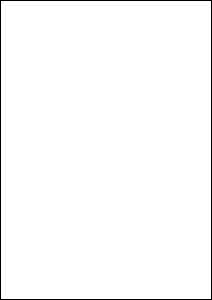
Available at the ICA in London, or via in les presses du réel in France
To order via the website: Selling price: £8 (€13) + £2 (€3)
to purchase - pour commander, please either use PAYPAL or email info@mathieucopeland.net
Produced, designed and published in 2003 by Mathieu Copeland
L’EXPOSITION D’UN FILM
CENTRE POMPIDOU
Du 23 au 27 novembre 2016, cinéma 1 & 2
Le cinéma comme l’exposition est le lieu de la synthèse des arts : il partage avec elle la capacité d’agencer des ensembles hétérogènes au sein de temporalités et d’espaces discursifs. Conçu autour de rencontres et de projections « L’Exposition d’un film » propose de penser les rapports complémentaires et contradictoires qu’entretiennent le film et l’exposition à travers un panorama à la fois historique et prospectif. Traversée par l’influence grandissante des images en mouvement dans le champ de la culture visuelle et patrimoniale du XXème siècle, la pratique de l’exposition a peu à peu assimilé certaines propriétés du film – mouvement, montage, projection, défilement, etc… – dont elle aura su intégrer les potentialités pour se réfléchir et s’inventer de nouveaux modèles. « L’Exposition d’un film » formule l’hypothèse du film exposé autant que celle de l’exposition filmée. Explorant aussi bien le registre documentaire que des formes filmiques hybrides employées par certains artistes et cinéastes comme des espaces d’exposition singuliers et autonomes, cette programmation est l’occasion d’approfondir une réflexion sur le devenir de ces deux médiums à l’ère d’une dématérialisation accélérée des supports.
Rencontres et projections en présence de Pierre Bismuth, Enrico Camporesi, Mathieu Copeland, Clément Delépine, Bethan Huws, Philippe-Alain Michaud, Charles de Meaux, Olivier Mosset, Jonathan Pouthier, Xavier Veilhan et les oeuvres de Gabriel Abrantes, Charles Atlas, Serge Bard, Pierre Bismuth, Constantin Brancusi, Marcel Duchamp, Bethan Huws, Man Ray, Robert Morris, Ed Ruscha, Stan Vanderbeek, Xavier Veilhan, Hannah Wilke.
L’EXPOSITION D’UN FILM
CENTRE POMPIDOU
18, 19 ET 20 SEPTEMBRE, CINÉMA 2
Le cinéma comme l’exposition est le lieu de la synthèse des arts : il partage avec elle la capacité d’agencer des ensembles hétérogènes au sein de temporalités et d’espaces discursifs. Conçu autour de rencontres et de projections « L’Exposition d’un film » propose de penser les rapports complémentaires et contradictoires qu’entretiennent le film et l’exposition à travers un panorama à la fois historique et prospectif. Traversée par l’influence grandissante des images en mouvement dans le champ de la culture visuelle et patrimoniale du XXème siècle, la pratique de l’exposition a peu à peu assimilé certaines propriétés du film – mouvement, montage, projection, défilement, etc… – dont elle aura su intégrer les potentialités pour se réfléchir et s’inventer de nouveaux modèles. Empruntant son titre au film éponyme de Mathieu Copeland, « L’Exposition d’un film» formule l’hypothèse du film exposé autant que celle de l’exposition filmée. Explorant aussi bien le registre documentaire que des formes filmiques hybrides employées par certains artistes et cinéastes comme des espaces d’expositions singuliers et autonomes, cette programmation est l’occasion d’approfondir une réflexion sur le devenir de ces deux médiums à l’ère d’une dématérialisation accélérée des supports.
Rencontres et projections en présence de Mathieu Copeland, Rosa Barba, Pierre Leguillon, Jeremy Millar, Philippe-Alain Michaud, Lydie Delahaye, Enrico Camporesi et Jonathan Pouthier ; avec les oeuvres de Jean-Pierre Bertrand, Michael Snow, Hollis Frampton, Paul Sietsema, Richard Hamilton, James Scott, Liam Gillick, Karin Schneider & Nicolas Guagnini, Marcel Broodthaers, Elizabeth Price, Storm de Hirsh, David Sylvester, Harry Holtzman, Runa Islam, Willard Maas, Warren Sonbert, Charles Henri Ford, Gerry Schum…
BEGINNING AGAIN
15 et 16.05.14
Une rétrospective des films expérimentaux de Ben Van Meter, avec des oeuvres de Francis Baudevin, Marcia Hafif, David Lamelas, Charlotte Moth, Phill Niblock, Karin Sander et Cerith Wyn Evans.
Une programmation d’événements proposée par Mathieu Copeland et Philippe Decrauzat dans les espaces vides du Plateau.
2e session:
Jeudi 15 et vendredi 16 mai 2014
Entrée libre à partir de 18h*
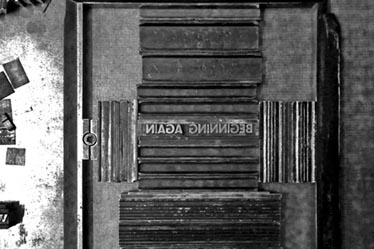
Il s’agit de commencer. L’espace vide, décroché dans l’attente d’une prochaine exposition. Un interstice comme espace et temporalité. L’image projetée, percutée, comme le croisement de programmes aux durées divisées pour la création d’un environnement.
Comme point de départ, une « rétrospective » des films de Ben Van Meter. Déployant son vocabulaire par un montage syncopé au son désynchronisé et discrépant, un brouillage informel de l’image aux couleurs dénaturées, il documente une génération, témoigne du San Francisco Trips Festival (1966), et en restitue tout le parfum astringent sur un mode psychédélique.
En écho est présentée une sélection d’oeuvres projetées qui considèrent un périmètre donné (Niblock), l’archive d’une architecture pavillonnaire (Hafif), la réalité d’un évènement (Moth), une plongée dans un intérieur (Wyn Evans), une réflexion structurelle sur la projection (Lamelas) ou encore la projection d’un logo (Baudevin).
Une démultiplication des sources lumineuses, tel un ballet sourd et rythmé.
--
BEGINNING AGAIN
15 & 16.05.14
A retrospective of Ben Van Meter’s films in dialogue with works by Francis Baudevin, Marcia Hafif, David Lamelas, Charlotte Moth, Phill Niblock, Karin Sander and Cerith Wyn Evans.
A programme of events conceived by Mathieu Copeland and Philippe Decrauzat for the empty spaces of Le Plateau.
2nd session:Thursday 15 & Friday 16 May 2014
Free entry starting at 6pm*
Let’s start. Empty spaces, as suspended during a break, waiting for the next exhibition. A space and time in-between. As a prelude, the image projected and collided with, like an overlap of multiple programmes and divided durations, permitting the creation of an environment.
As a point of departure, a “retrospective” of Ben Van Meter’s films. Developing his vocabulary through syncopated editing with de-synchronized and discordant sound, an informal blurring of the image with unnatural colours, he records a generation, goes to the San Francisco Trips Festival (1966), and re-creates all its astringent aroma in psychedelic mode.
At the centre of Le Plateau’s exhibition space, Me, Bruce and Art (1966) appears to us like a mechanical piece with two meanings. Recording a journey, from start to finish, in a time-frame provided by the televised interview between Bruce Conner and Ben Van Meter.
Here, experimental film appears to be the subject in its relation to television and time. The mode of production and the TV studio set’s backstage are revealed, like a dialectics of deconstruction.
“A documentary of the event from the point of view of a goldfish in the Kool-Aid bowl.” (Ben Van Meter on his film SF Trips Festival).
A selection of screened works is presented in relation to Van Meter’s films. Light sources are multiplied, like a muffled, rhythmic ballet, with differentiated and continuous loops.
Amplification of matter within a given perimeter, Grand Street (Phill Niblock), an inventory and archive of a suburban architectural development (Marcia Hafif), the reality of an event made to be photographed (Charlotte Moth), a plunge into an interior (Cerith Wyn Evans), structural reflection about projection, and the remake of a logo projected onto the floor (Francis Baudevin).
These works, like bachelor constructions, assert their autonomy and function here as myriad notices, which augment, appropriate and complicate our reading.
THE BEATING (FROM THE MICROTONES) IS BEATING ME DOWN
05 et 06.03.14
1re session:
Mercredi 5 et jeudi 6 mars 2014
Avec The Boyle Family, FM Einheit, Fritz Hauser (interprété par Serge Vuille), Bruce McClure, Karin Sander
Une programmation proposée par Philippe Decrauzat et Mathieu Copeland dans les espaces vides du Plateau.
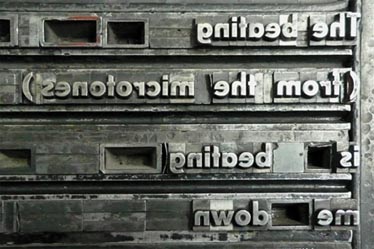
The Boyle Family – Elemental Study for the Skarberget Site, Norway 1972 World Series – pièce sonore diffusée en continu
FM Einheit – Blech No.316 to 324
Fritz Hauser – SCHRAFFUR POUR GONG SOLO interprété par Serge Vuille
Bruce McClure – IN AN UNDIVIDED REALITY YOU MUST DRAW THE LINE SOMEWHERE – Projector performances
Karin Sander – Gebrauchsbilder (Patina Paintings) – installation / intervention en extérieur
Phill Niblock – manifeste
Il s’agit de commencer. L’espace vide, décroché, dans l’attente d’une prochaine exposition. Un interstice comme espace et temporalité. En préambule, le son, dans toute sa matérialité, dans toutes ses variations d’intensités. The beating (from the microtones) is beating me down, manifeste écrit par Phill Niblock, envisage le son dans sa minutie et annonce l’explosion du sens.
Le son prend forme, et sa forme se construit là où elle se détruit – entre accumulations d’enregistrements confrontés à un temps réel (Hauser) – fragments d’un temps passé rediffusé (Boyle Family), projections de lumières sonores (McClure), réceptacle sensible d’une destruction active (Einheit), et annonce d’une exposition à venir (Sander).
--
THE BEATING (FROM THE MICROTONES) IS BEATING ME DOWN
05 & 06.03.14
Avec The Boyle Family, FM Einheit, Fritz Hauser (interprété par Serge Vuille), Bruce McClure, Karin Sander
A programme of events conceived by Mathieu Copeland and Philippe Decrauzat for the empty spaces of Le Plateau
1st session:
The beating (from the microtones) is beating me down
Wednesday 5 and Thursday 6 March 2014
Doors open at 6.30 pm and the concerts start at 7 pm (no access after 7.30 pm)
The Boyle Family – Elemental Study for the Skarberget Site, Norway 1972 World Series - Recorded piece played on repeat
FM Einheit – Blech No.316 to 324
Fritz Hauser – SCHRAFFUR POUR GONG SOLO interpreted by Serge Vuille
Bruce McClure – IN AN UNDIVIDED REALITY YOU MUST DRAW THE LINE SOMEWHERE – Projector performances
Karin Sander – Gebrauchsbilder (Patina Paintings) – Outdoor installation
Phill Niblock – Statement
Let’s start. Empty spaces, as suspended during a break, waiting for the next exhibition. A space and time in-between. Here the sound as a foreword, in its materiality, in all its intensity variations. The beating (from the microtones) is beating me down, a statement written by Phill Niblock, considers the sound in all its infinite forms, and announces meaning’s explosion.
The sound takes shape and this shape builds where it destroys itself – between recording accumulations facing real time (Hauser) – fragments of the past replayed (Boyle Family), sound generated by light projections (McClure), the sensitive recollection of a live destruction (Einheit) and announcement of a future exhibition. (Sander)
Chorégraphier l'exposition
un festival de Mathieu Copeland
À l’occasion de la publication du livre Chorégraphier l’exposition, la Ferme du Buisson invite Mathieu Copeland à investir ses espaces (théâtre, cinéma et centre d’art) pour un événement exceptionnel.
En écho au livre Chorégraphier l’exposition, le festival croise danse contemporaine, arts plastiques, musique et cinéma pour célébrer les auteurs invités au travers de propositions inédites écrites pour trois interprètes. Sans en être l’illustration, au travers des termes qui structurent l’ouvrage – partition, corps, espace, temps et mémoire – cette journée continue s’articule non seulement sur l’occupation d’espaces fragmentés, mais surtout sur une célébration de la durée – 12 heures – pour créer un festival qui se compose, en parallèle et en alterné, de trois volets.
Chorégraphier l'exposition : le festival
sam 30 nov de midi à minuit
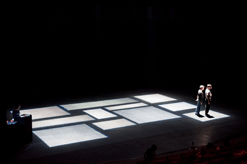
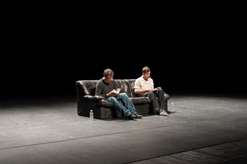
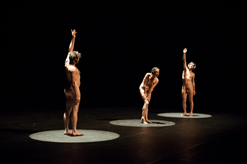
1/ Des œuvres du temps, au Théâtre
Conçu comme un long continuum interrogeant l’écoute, la voix et le rôle de l’interprète, ce volet réunit des œuvres des artistes Carl Andre, Tim Etchells, Kenneth Goldsmith, Franck Leibovici, Alan Licht, Loreto Martínez Troncoso, Irena Tomažin et Myriam Van Imschoot. Il est augmenté et rythmé de lectures d’extraits des entretiens entre les chorégraphes Jérôme Bel et Boris Charmatz, pour lesquelles le livre devient le libretto d’une pièce à écouter. L’ensemble de ces partitions, aux formes variées, prolongent et redonnent vie à un projet, un écrit ou une performance. Elles sont confiées à trois mêmes interprètes, Grégory Guilbert, Stève Paulet, et Virginie Vaillant, qui deviennent l’incarnation de ces œuvres du temps interrogeant la chorégraphie, l’appropriation d’un texte et d’une partition.
2/ Une programmation de films, au Cinéma et au Studio
Au cinéma sont projetés pendant toute la durée du festival des films rares ou inédits en France, réalisés par les cinéastes historiques Phill Niblock, Kenneth Anger et Amy Greenfield. Une pensée qui se prolonge au travers de l’ouvrage Chorégraphier l’exposition et propose une approche du cinéma par le mouvement, l’utilisation du corps et sa captation. Parallèlement est présenté au studio le film JG Reads (2008) de Rirkrit Tiravanija, dont la durée donne sa temporalité au festival.
3/ Des tables rondes, au Centre d’art
Cinq tables rondes d’une durée respective de trois quarts d’heure sont organisées tout au long du festival. Elles réunissent les auteurs du livre et les artistes des œuvres du temps autour des cinq prismes qui articulent le livre Chorégraphier l’exposition : la partition, l’espace, le temps, le corps et la mémoire. Ces tables rondes sont l’occasion de poursuivre les réflexions autour des relations entre exposition et chorégraphie, performance et musée. Avec Franck Leibovici, Kenneth Goldsmith, Giovanni Carmine, Barbara Formis, Loreto Martínez Troncoso, Irena Tomažin, Julie Pellegrin, Jennifer Lacey, Lilo Nein, Gisèle Vienne, et Catherine Wood
ECHO PIECE (CANARY WHARF) 2009
by Michael Parsons
Saturday 20th June 2009
10.45 am – 12 noon
A one hour walk through Canary Wharf with live brass accompaniment of a sound composition written by Michael Parsons and site specific to Canary Wharf.
Echo Piece is an environmental sound work to be performed by a number of musicians, moving around and exploring the acoustic properties of an open-air space. Players with trumpets, horns and trombones will play short single notes, interspersed with silences, evoking echoes from reflective surfaces, in a variable, open-form, sparse and pointillistic texture of discrete sounds.
Echo Piece creates a spatial polyphony of multiple echoes, activating the sound-reflecting surfaces of buildings at different distances, revealing the elasticity of the surrounding medium. Canary Wharf is an ideal urban location for this event, having a series of open spaces surrounded by sound-reflecting surfaces, and being relatively free of traffic noise. Echo Piece will change the way these spaces are perceived and experienced, by exposing their latent acoustic potential.
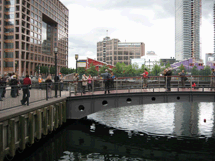
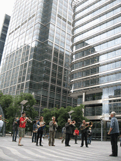
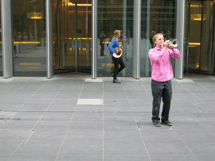
“The space between buildings is also part of their architecture. Volumes, masses and voids ‘transmit’ and ‘receive’ messages from one another.”
Le Corbusier
Curated by Mathieu Copeland
Commissioned by Culture House at Arts and Business
WALKING IN THE CITY
Friday October 10th 2008 at 8pm, live discussion between Iain Sinclair, Michael Parsons and Mathieu Copeland on Resonance FM
http://resonancefm.com/archives/352
Photographs courtesy Deborah Bullen
Sunday October 12th 2008 at 11.00am
Finsbury Avenue Square London EC2 (west side of Liverpool Street station)
Michael Parsons Walking Piece***
Philip Corner One Note Once
Michael Parsons will create a new version of his experimental classic Walk, originally written for the Scratch Orchestra in 1969. The performance will take place between 11.00am and 12 o’clock. To participate, meet in the Octagon next to the Richard Serra sculpture at the west entrance to Liverpool Street station at 10.30am. The work by Philip Corner will be performed inside the Richard Serra sculpture at exactly 12 o’clock.
«The architecture geometrically defined by urban planning is transformed into a space by walkers. Space is articulated by the operations that take place within it. It is composed of intersections of mobile elements; it exists when one takes into account vectors of direction, velocities and time variables».
(Michel de Certeau)
A Culture House commission curated by Mathieu Copeland, media partners Resonnance FM
